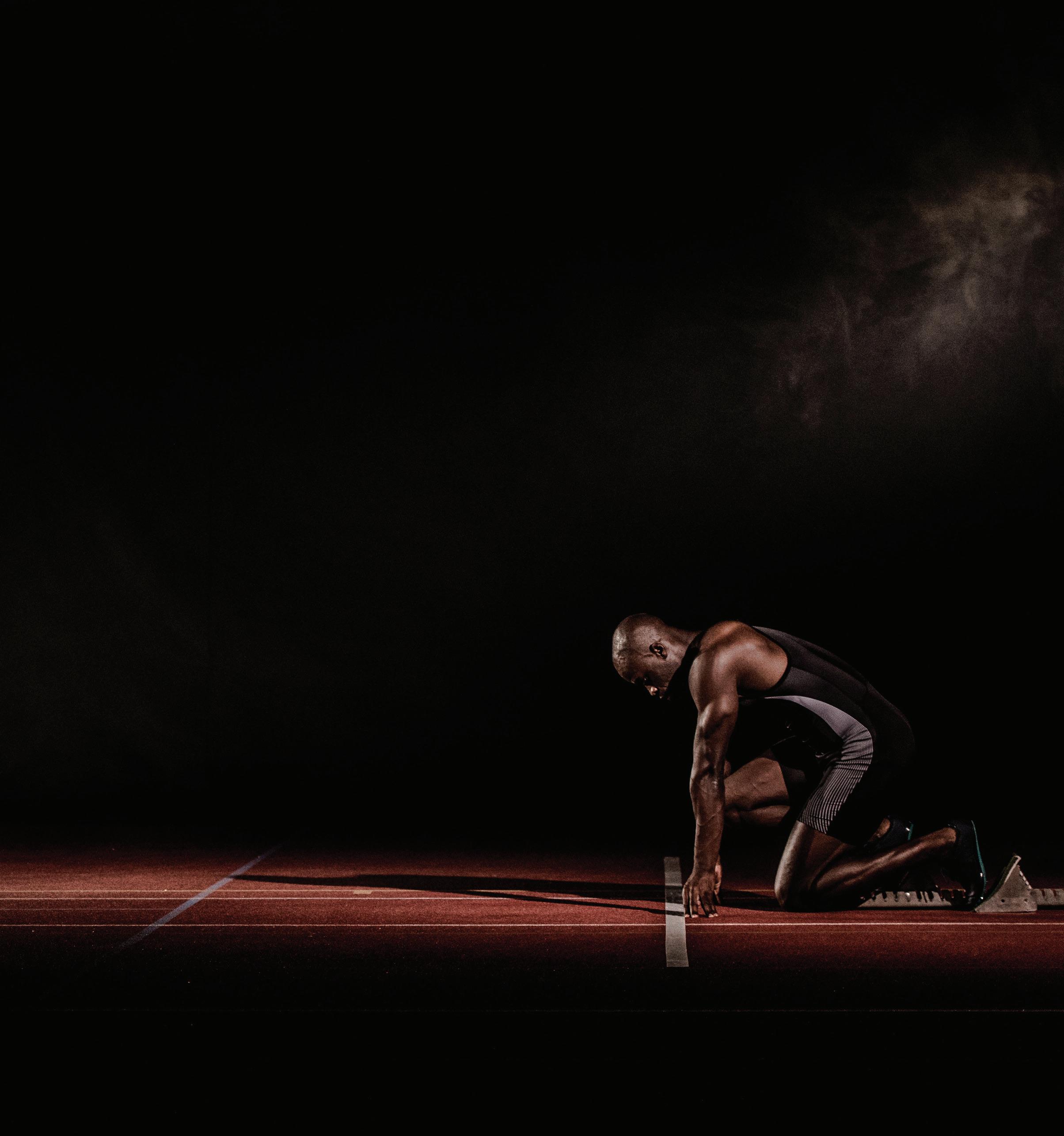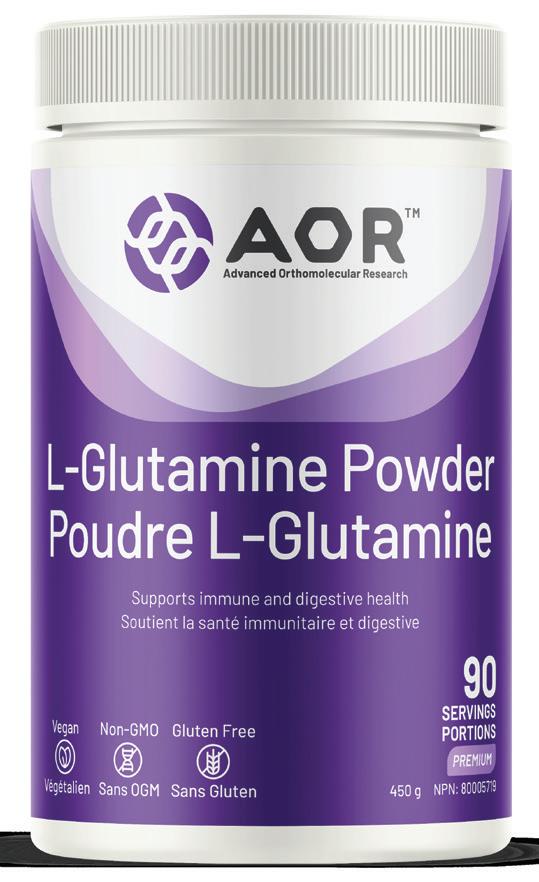

in





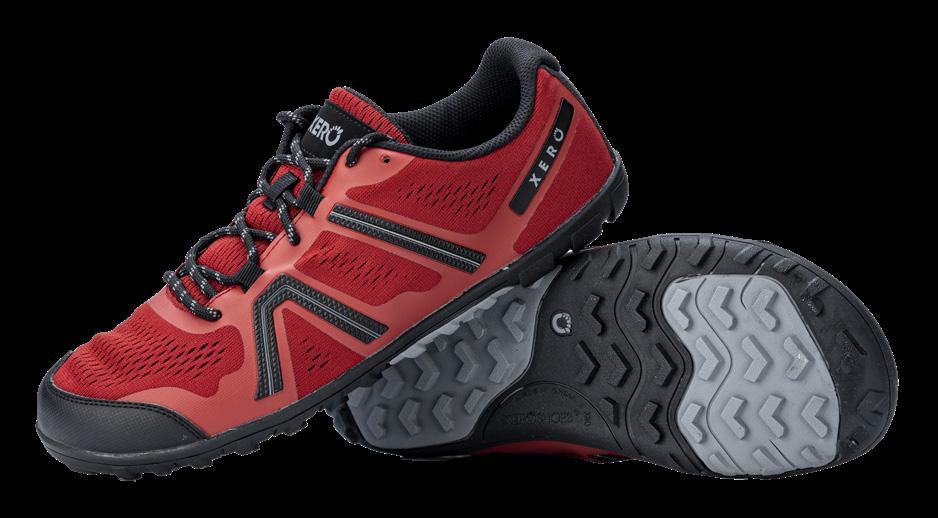


Style
Pot Panch Phoran Channa
Baked Butternut Squash,


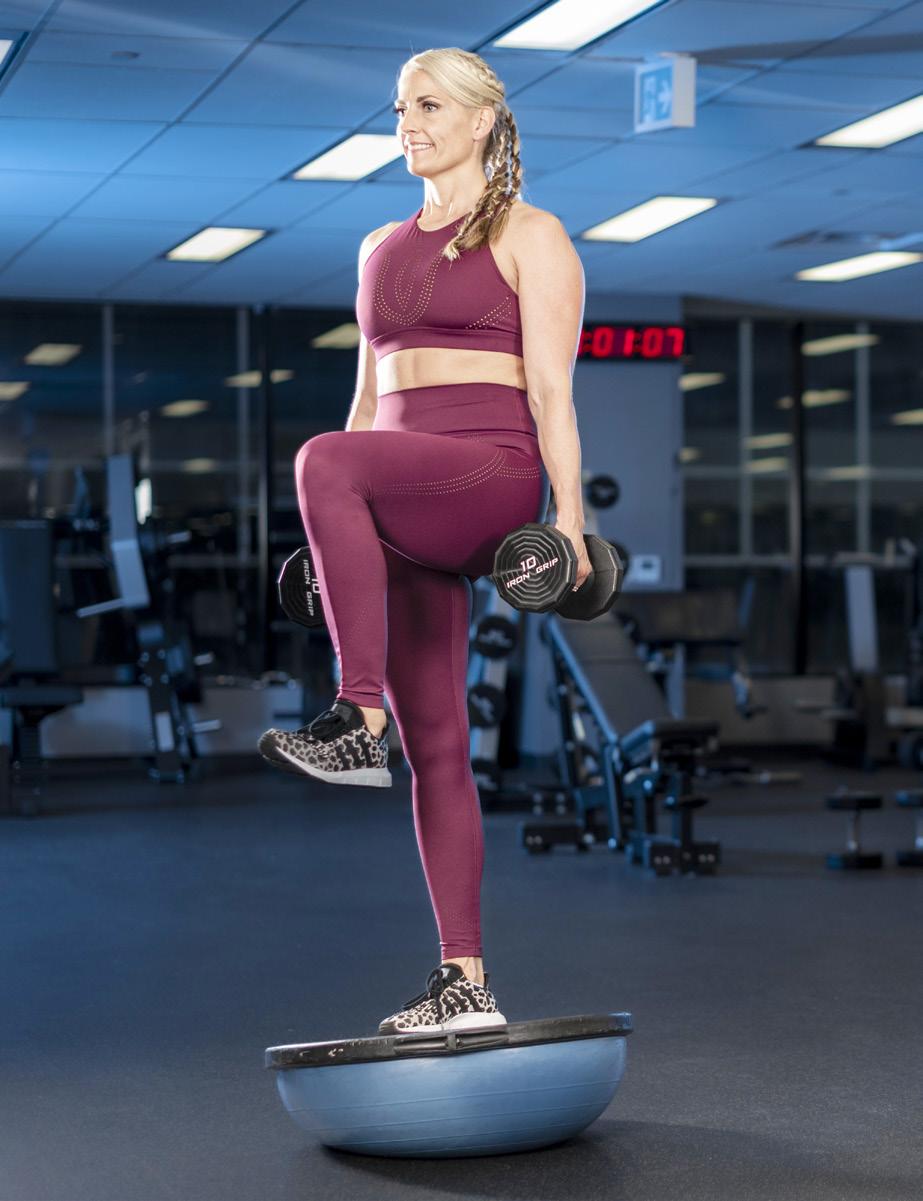
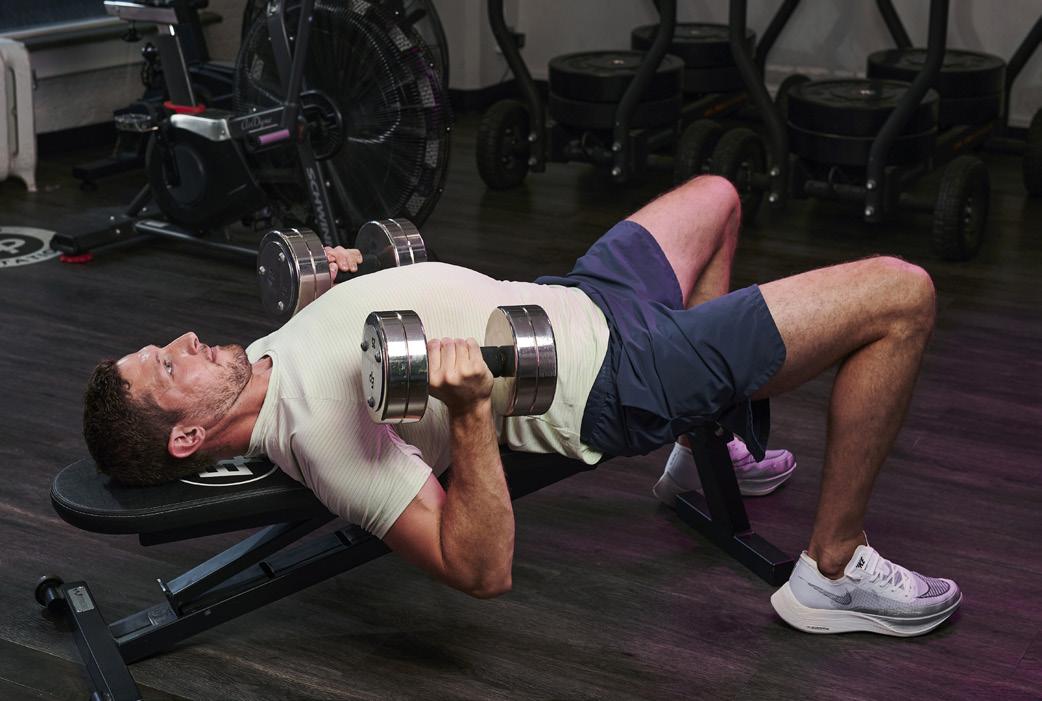
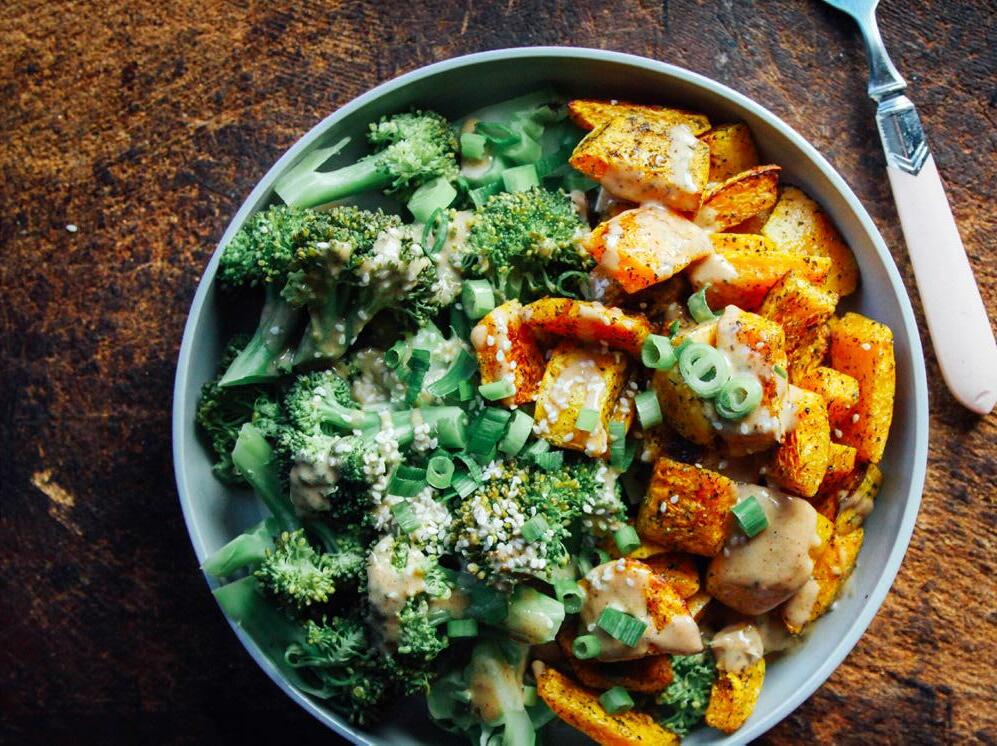
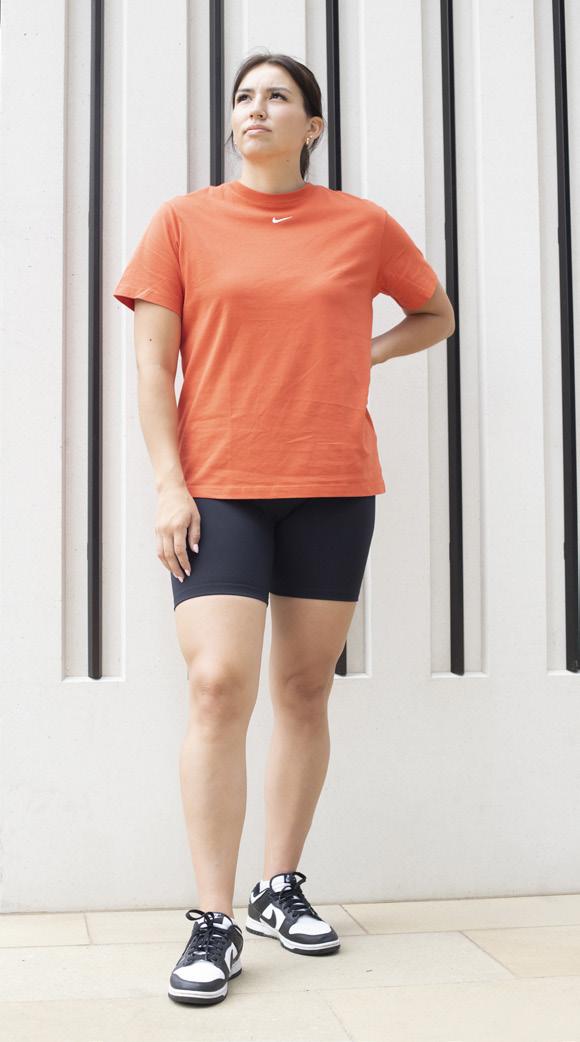


A leader in the industry for over 31 years, IMPACT Magazine is committed to publishing content provided by the best experts in their fields for those who aspire to higher levels of health and fitness.
PUBLISHER & EDITOR-IN-CHIEF

Elaine Kupser elaine@impactmagazine.ca
GUEST EDITOR Louise Hodgson-Jones corsa.communications@shaw.ca
ART DIRECTION & GRAPHIC DESIGN Spindrift Design Studio Inc. hregehr@studiospindrift.com
VP BUSINESS DEVELOPMENT Janet Henderson janet@impactmagazine.ca
VP PARTNERSHIPS & MARKETING Rhyan Pietromonaco rhyan@impactmagazine.ca

ASSISTANT EDITOR Emily Meyer emily@impactmagazine.ca
COPY EDITOR Tom Lundteigen LEGAL COUNSEL Gregory Forrest
PRINTING Mitchell Press DISTRIBUTION Media Classified Streetbox Media
CONTACT IMPACT Magazine Head Office 2007 2nd St. S.W. Calgary, AB T2S 1S4 403.228.0605
ADVERTISING advertising@impactmagazine.ca
$45 for one year, or $70 for two years (includes GST) impactmagazine.ca/subscriptions
WEBSITE www.impactmagazine.ca
SOCIAL impactmagcanada impactmag impactmag impact-magazine
The opinions expressed in IMPACT Magazine are the writers’ and not necessarily those of the publication. IMPACT Magazine advises you to consult your physician if you do not follow a regular fitness program. All content is the property of IMPACT Productions Inc. and cannot be reproduced in any form without written consent of IMPACT Productions Inc.
© 2022 Impact Productions Inc.




Bestselling author, speaker, and a leader in the exercise movement, Katy is a biomechanist changing the way we move and think about our need for movement with her company, Nutritious Movement. She teaches movement globally and speaks about sedentarism and human movement ecology to academic and scientific audiences, and is based in Carlsborg, WA.


NUTRITIOUSMOVEMENT NUTRITIOUSMOVEMENT
Amby won the 1968 Boston Marathon and served for 20 years as the executive editor of Runner’s World Magazine. He has authored several running books, writes for Run Long, Run Healthy newsletter, coaches online, and is in demand as a speaker at running expos and clinics. Amby resides in Mystic, CT.

EXERSCIENCE WWW. AMBYBURFOOT.COM
Mo is the founder and president of Empathy Inc., marketing professor at Centennial College, and member of the Interactive Advertising Bureau of Canada (IAB) public policy committee, based in Toronto, ON. He has appeared on CBC’s The National and quoted in outlets such as The Washington Post and The Message.

MODEZYANI
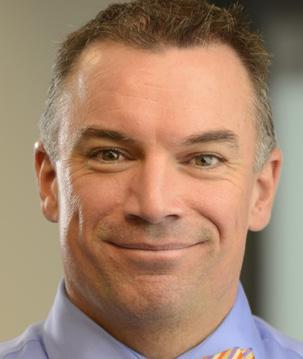
Reed is an associate professor in the Faculty of Kinesiology at the University of Calgary, and the Chief Scientific Officer of the Running Injury Clinic. He is a board-certified athletic trainer and completed two post-doctoral research fellowships in bioengineering. He is internationally recognized as a leading expert in the research and clinical treatment of lower extremity injuries.
DRFERBER RUNNINGINJURYCLINIC
Shiggy is an award-winning photographer, videographer and short film in Los Angeles, CA. He specializes in celebrity portraits, executive headshots and commercial photography. He is trilingual (English, Japanese, German), a published author and has finished two IRONMAN triathlons. He loves dogs and feeds backyard birds, squirrels and now raccoons.

GOSHIGGYGO WWW. GOSHIGGYGO.COM
Robbie McDonald uses the power of story to bust the stigmas that lurk around neurodivergence, mental health, and hidden disabilities. In addition to freelance writing, she co-hosts a popular podcast about ADHD discovery in midlife and is a staff writer for the Adult ADHD Centre, in Vancouver, B.C. She is passionate about creating accessible communities and sustainable ways of working and connecting that move beyond performance and into action.
FRAZZLEDINVAN ROBERTADINVAN
CONTRIBUTORS Katy Bowman, Nina Bolders, Amby Burfoot, Arvinda Chauhan, Preena Chauhan, Scott Cruickshank, Mo Dezyanian, Zuzana Fajkusova, Reed Ferber, Amélie Gagné, Caitlin Galer-Unti, Michael Greger, Emma Herrle, Louise Hodgson-Jones, Mikaila Kukurudza, Kristin Lajeunesse, Josh Levin, Sarah Mackenzie, Robbie McDonald, Mary McDougall, Andrew McGonigle, Doug McNish, Ian McWalter, Emily Meyer, Coleman Molnar, Jennifer Neil, Amanda Persi, Jacob Puzey, Carolyn Scott-Hamilton, Alysa Tarrant, Lauren Toyota, Emily Von Euw, Jessica Woollard, Lauren Yakiwchuk.
PHOTOGRAPHY Tiggy Ara, Nicole Axworthy, Nicolas Berger, Todd Duncan, Grand to Grand Ultra, Tomás Greally, Jenna Jones, Leah Hennel, Shiggy Ichinomiya, Graham McKerrell, Doug Mitchell, Reena Newman, Nutritious Movement, The Collective You, VisitScotland/Kenny Lam, 5 Peaks Adventures.

Sameer Khan is very excited that Only Oxygen will be manufactured and in full production in Canada by the end of the year. As President and Managing Director of the Canadian brand he wants to see the natural spring water in the market here so everyone can experience its amazing health benefits. Khan is a Food Scientist, with a bachelor’s degree in Food Science from the University of Manitoba, and so understands the process that Only Oxygen goes through from its source and into the hands of the consumer.
Only Oxygen is water that is oxygenated from a natural spring source. The natural bubbles deliver a high level of oxygen to blood cells which can have a healing and therapeutic effect on the body. Even when frozen or boiled it can maintain its quality and composition.
With no chemicals or additives, the product is 100 per cent natural. “There is no special ingredient in the water, just a unique Patented technology involved in the manufacturing process. This gives functionality to the water, making it easy to absorb into your system giving you the benefits of breathable oxygen,” says Khan.
Only Oxygen is the Canadian brother of Kure Oxygen which originates from the U.K. and has been in operation just over three years. In that time the product has expanded to Hong Kong, Malaysia, Brunei, the Caribbean (under the brand names Kure Oxygen, and Just Oxygen). Future plans include expansion into the Gulf Cooperation Council and Jordan soon.
Numerous clinical trials have been conducted in the U.K., working with health professionals from the National Health Service and naturopaths. Trials range from blood analysis—testing how quickly the oxygenated water enters the blood stream— to hydrotherapy sessions. Results have shown that consuming the water can improve blood flow, speed up the rate that oxygen enters the body and improve detoxification.
Athletes use Only Oxygen in their training, in hydrotherapy baths and as apart of their nutritional program. “The water is a natural source for electrolytes and so once they see what the oxygen can do to their performance, they come back for more,” says Khan.
In the U.K., the water is sourced from a spring in Cornwall in the west of England. It undergoes a four-stage filtration process to treat any nitrates before being oxygenated by nano oxygen bubble technology. These ultra fine bubbles are small oxygen bubbles that have unique properties making them different from the larger bubbles seen in a product that may be carbonated.
Only Oxygen will be manufactured on the west coast in B.C. and in the east coast, in Ontario and Montreal. Khan is delighted that the companies who will be manufacturing in Canada also have a natural spring source. “This is important for the sustainability of the product, and it means we can replicate the technology from the U.K.”
It will be manufactured for the domestic market and then for export. Khan’s focus is on sustainability, price, and awareness.
In the U.K. Only Oxygen is packaged in plastic but in Canada it will be in 500 ml cans and glass bottles. The price will also be in the $2 - $2.50 range. “We want to get the product in the market in the most sustainable way and make it affordable for everyone by offering a premium product at a reasonable price.”


Clinical tests have found that maximum health benefits come from drinking two 500 ml cans/bottles a day. From testimonials the benefits range from alleviating arthritis, headaches, and migraines to improved skin care and athletic performance.
Khan believes that Only Oxygen will be a game changer in the spring water market. “It has a unique flavour with proven health benefits. We want to provide a product that is functionally beneficial to anyone who drinks it.”

It is a joy when we are lucky enough to find the perfect front cover athlete who epitomizes our chosen theme, as was the case in this issue. Vancouver-born Brendan Brazier is a trailblazer—a pioneer in the sports nutrition industry being one of the first in Canada to formulate a plant-based nutrition product for sports performance and recovery. Brendan’s story is remarkable, and he is as humble as he is accomplished. He and I also happen to share a deep love for potato chips. It’s comforting to know that even the most impressively fit and healthy can enjoy a guilty pleasure too! I’m thrilled to share Brendan’s fascinating journey with our readers.
I hope this issue will gently encourage you to incorporate more plant-based nutrition into your diet, even if just little by little.
The goal here at IMPACT is and has always been to help our readers live their healthiest lives, and who can argue with the notion of simply eating more fruits, vegetables and whole foods to accomplish this? The additional benefits of a plant-based diet, such as enhanced athletic performance and recovery, are just the icing on the (vegan) cake. We continue to bring you the latest information on nutrition from our experts, as well as some fabulous recipes. We’re not just serving up beans and kale, folks.
Now that fall is upon us, I’m definitely ready to head back into the gym and get my

personal fitness routine revved up, and I’m sure I’m not the only one. This issue will inspire you to get reacquainted with your favourite workout routine after what was hopefully a restful, relaxing summer. We share a story about how our community is feeling about Getting Back to the Gym in this post-yet-not-completely-postpandemic world. One thing is undeniable: there is something special to be achieved by working out with others. We feed off each other’s energy, we breathe together, laugh together, and most of all, we sweat together!
As always, Canada’s Top Fitness Trainers share their workouts with us. We also have something special for the yogis and yoginis, as well as a must-read story on movement and exercise (you’ll find out they aren’t necessarily the same thing).
I would like to draw your attention to an event that one of our featured, inspiring young athletes is launching on September 30th: the Reconciliation Run. I was extremely moved by this story, and if you can’t attend in person the event is offered virtually between September 20th and September 30th. In the spirit of reconciliation, let’s all participate and show our support.
I invite you to be inspired as much as we were with this edition.
It’s that time of year again! We are calling on you to nominate your favourite, most outstanding fitness instructors for the class of 2023! Let us know whom you feel should be recognized and featured in this special edition with a nomination for our 2023 Canada’s Top Fitness Instructors Awards at impactmagazine.ca.



With so many fitness apps to choose from, we’ve taken away the guesswork
BY EMILY MEYER IMPACT assistant editor, fitness and travel enthusiast in Calgary, AB. EMILY.MEYER.TRAVELTALES EMILY MEYERThe fitness application market exploded during the COVID-19 pandemic. And even though we have our favourite fitness studios and gyms back, people aren’t turning their backs on fitness apps, with the market expected to increase by 20 per cent over the next 10 years. Busy lives mean we don’t always get around to going to the gym. For those days, we turn to our trusted apps, and we’ve compiled a list of the best!



Daily Yoga may be one of the hottest yoga apps available. It was awarded the 2022 Editors’ Choice, and with more than 50 million users worldwide, it’s no surprise why. With Daily Yoga, try multiple yoga poses, follow along with a guided class or try a weight-loss yoga challenge. With new classes added weekly and a smart-coach feature to help schedule classes, you’ll love this app.
FREE, PREMIUM SUBSCRIPTION AVAILABLE
Customize your yoga practice with Down Dog. Choose your practice length, experience level, music, and practice type, including Vinyasa, Hatha, Gentle, Restorative, Ashtanga, Yin, Cardio Flow and more. Never get bored of your practice with more than 60,000 different configurations.
MONTHLY/YEARLY SUBSCRIPTION

MapMyRun tracks just about everything when it comes to fitness. Log 600+ activities including yoga, running, cycling, Pilates and more. Apart from tracking performance parameters like pace, distance, elevation and route, MapMyRun allows you to automatically sync data from other fitness apps and devices to keep you on track in your fitness journey.
FREE, PREMIUM SUBSCRIPTION AVAILABLE

With a 4.8-star rating on both the App Store and Google Play, AllTrails is one of the most loved hiking apps available. AllTrails is designed to get you outside with a range of activities including hiking and biking. Whether you’re looking for an easy stroll or a challenging summit, with more than 350,000 trails worldwide, AllTrails has everything.


FREE, PREMIUM SUBSCRIPTION AVAILABLE
Get in-depth performance metrics for running and cycling. Strava syncs with most devices, making it easy to monitor and map your training and performance, so you can train smarter. With an unmatched network of trails and roads, whatever route you're looking for, if it’s been run or cycled, it’s on the app.
FREE, PREMIUM SUBSCRIPTION AVAILABLE

With access to unlimited free fitness classes, many taught by celebrity trainers, if FitOn isn’t in your library already, it should be. FitOn creates a personalized plan for you to follow, making it easy to track progress. With the premium subscription, receive a tailored meal plan with recipe suggestions based on your goals.
FREE, PREMIUM SUBSCRIPTION AVAILABLE
It’s Europe’s #1 fitness app for a reason, and when it comes to HIIT, Freeletics delivers. With training personalized to your fitness goals, Freeletics makes it easy for you to track your progress and build healthy habits. With over 1,000 training variations to choose from, Freeletics focuses on bodyweight training, meaning no extra equipment is required.
FREE, PREMIUM SUBSCRIPTION AVAILABLE
Komoot lets you plan your hiking, road cycling and mountain biking adventures wherever you find yourself in the world. Featuring offline maps, turn-by-turn navigation and a community list of favourite places to visit, download Komoot and start planning your next active adventure.
FREE WITH IN-APP PURCHASES
Peloton is known for its ondemand home workouts from world-class fitness instructors. This app offers a variety of spin classes designed to get you sweating and keep you motivated. There isn’t just spin available on the app. Try yoga, barre class, boxing, meditation, Pilates, boot camp and more!


Your indoor training experience is about to change with Wahoo. The Wahoo Fitness app uses GPS data and can be combined with the KICKR Power Trainer and other Wahoo sensors to track heart rate, stride rate, cycling power, speed and cadence for 39+ different fitness activities. The app is also compatible with numerous other apps and websites to share your workout data.
FREE
See the complete list at impactmagazine.ca
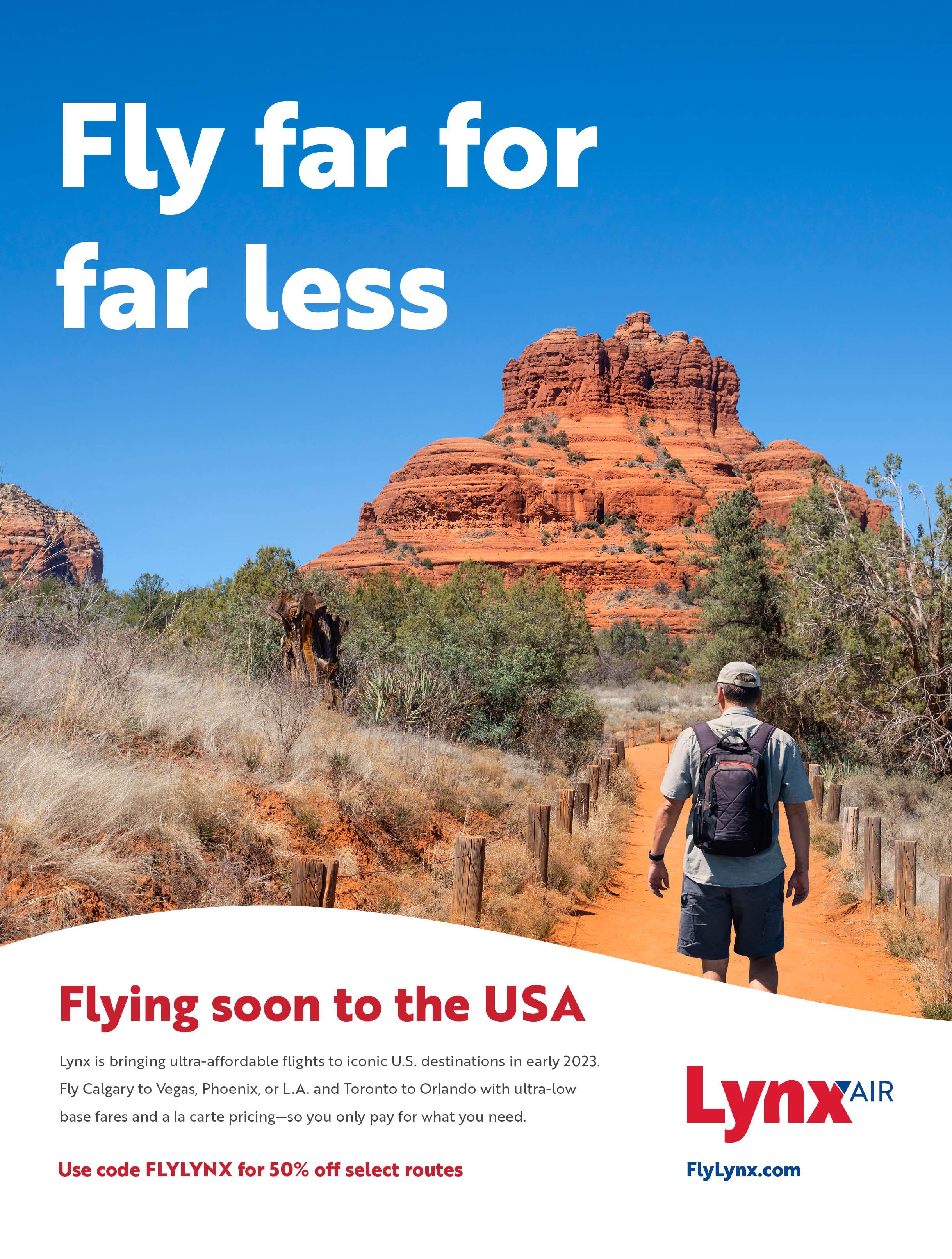
warm this winter with
brand
Ski Glove
know that the frigid winter
is inevitable, but being cold
have to be
Power in Motion’s Canadian designed MOTIONHeat products allow you to keep your heat all throughout the frozen months.
In 2006, Ken Cheung opened Power in Motion to promote more sustainable transportation. The first business in Calgary to specialize in urban electronic transport, Power in Motion has grown into much more than a retail e-bike store. They are a technology company with an inventor at the helm.

As an avid bike rider, Ken didn’t want the Canadian winters to slow him down. After trying other heated gloves during his rides and realizing they weren’t warm enough, he dismantled the gloves and redesigned them, knowing just what to do to make them better. Adding more sizing options for any hand size and powerful heat you can truly feel.
Most companies selling heated apparel are fashion-focused first, meaning they lack knowledge in battery technology and electronics—something that Ken and his team of engineers and designers were very familiar with.
Transitioning from e-bike batteries to heated glove batteries was easy enough, and with the right design software, MOTIONHeat was born.
The MOTIONHeat line has expanded to offer great products to keep all winter warriors warm. With the heated vest, heated belt, heated insoles and heated glove liners, being cold is a thing of the past. There are also windproof and waterproof insulated glove shells to complement the heated liners.

And now, Canadians have another reason to be excited about winter, with the newest edition to the MOTIONHeat line coming this fall, the 2.0 Heated Ski Gloves. This game-changer is different from any other glove on the market thanks to the insulation and layers of material, meaning longer time on the slopes.
“You need some real heat here in Canada, so we use a really powerful battery that can give you that heat,” says Liam Hawryluk, operations manager at Power in Motion.
In fact, the line of MOTIONHeat clothing is the hottest on the market. The additional heat is caused by the 12 and 16-volt batteries unlike the competitions 5 and 7-volt options. Made with breathable materials, moisture escapes for a sweat-free feel.
The best part? Unlike other heated clothing products, MOTIONHeat’s products work in combination with each other. With extension wires and universal connections, the products operate like an ecosystem rather than separate systems. Choose to house the batteries in the vest and use extension wires to connect to the heated insoles and gloves for ultimate warmth and comfort.
Shop online at motionheat.ca, or visit the team at Power in Motion located in the Eau Claire Market.







are

One of Canada’s Top Fitness Trainers 2022, WBFF Pro Fitness Model, GYMVMT Specialist Post Rehabilitation Trainer, mental health advocate, Registered Clinical Nutrition Metabolic Balance CANNP & Holistic Nutrition RHN, Vice President DreamBody in Calgary, AB. JENNIFERNEILWBFFPRO JENNIFER NEIL HAIR & MAKEUP: SHANNON PAYNE
Here are four movements that will incorporate and challenge your full body for strength, core and balance. Coming from a gymnastics, martial arts, track and field and bodybuilding background, I love athletic workouts. Here is a little secret—anyone at any age, in any profession or with any athletic background can benefit from these movements. By challenging yourself at the next level you also train your nervous system and body in a different way to handle the daily stresses in life, making them more manageable and making it easier to do daily activities. Completing these exercises on a regular basis, you will discover what you can do to improve balance and maintain strength, mobility, and agility.
You can complete four to six sets of these exercises together if you are looking to have a great sweat and challenge yourself with a dynamic workout. Rest 60-90 seconds between sets if needed (transition time is also just enough if you would like to keep the workout a higher intensity metcon). Exercises can be completed one after another making it a fun circuit.

Train like an athlete with athletic and challenging movements
8-12 reps, alternating
• Start in an athletic stance, feet shoulderwidth apart with bar hanging in front and grip palms facing towards the body. The distance between hands on the bar may vary depending on your flexibility at the top of clean movement.

• Drive legs from a mini squat to a high-clean catch position with single-leg knee drive to the medium box.
• Land foot flat on top on the box (movement should be performed quickly and as smooth as possible).
• Hold top position for 3 seconds before transitioning to next rep.
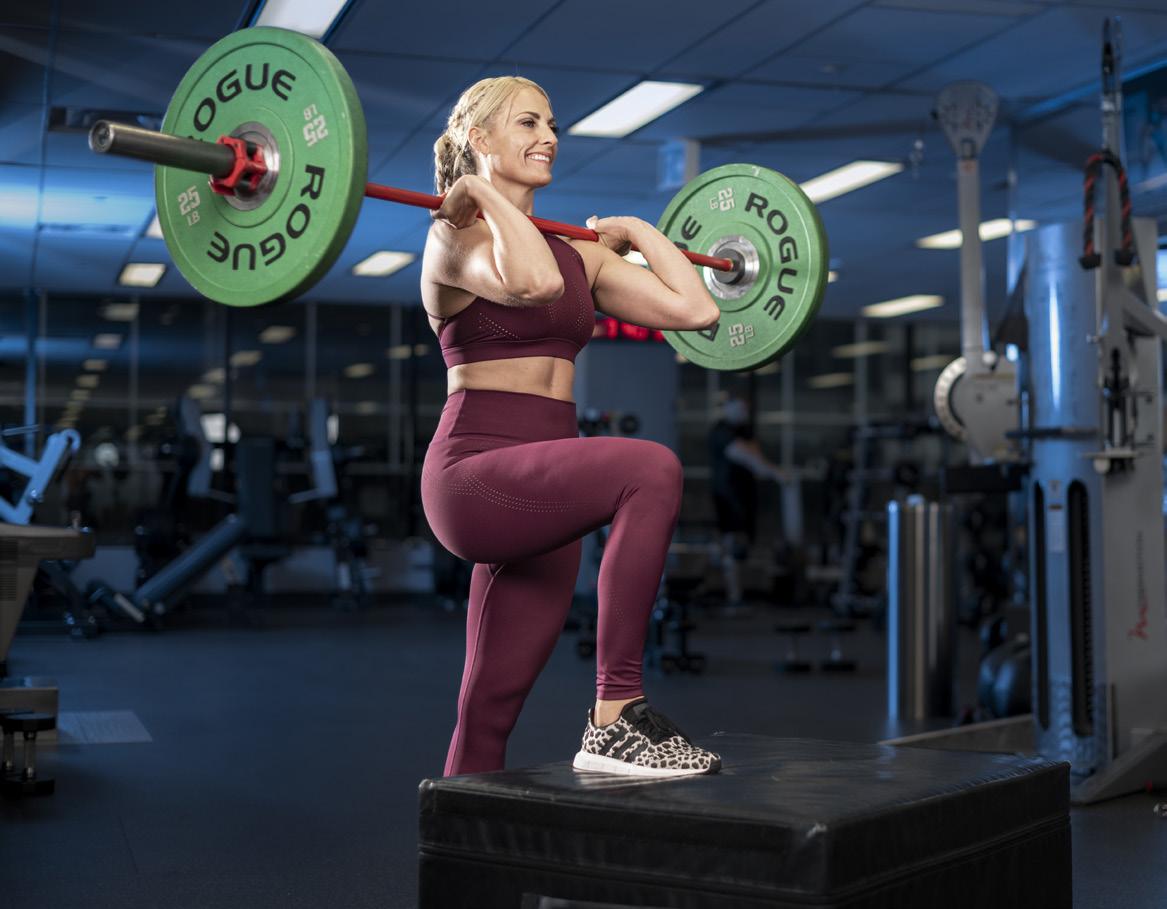
10-20 reps
• Holding dumbbells, transition onto the FitBall in a kneeling position.
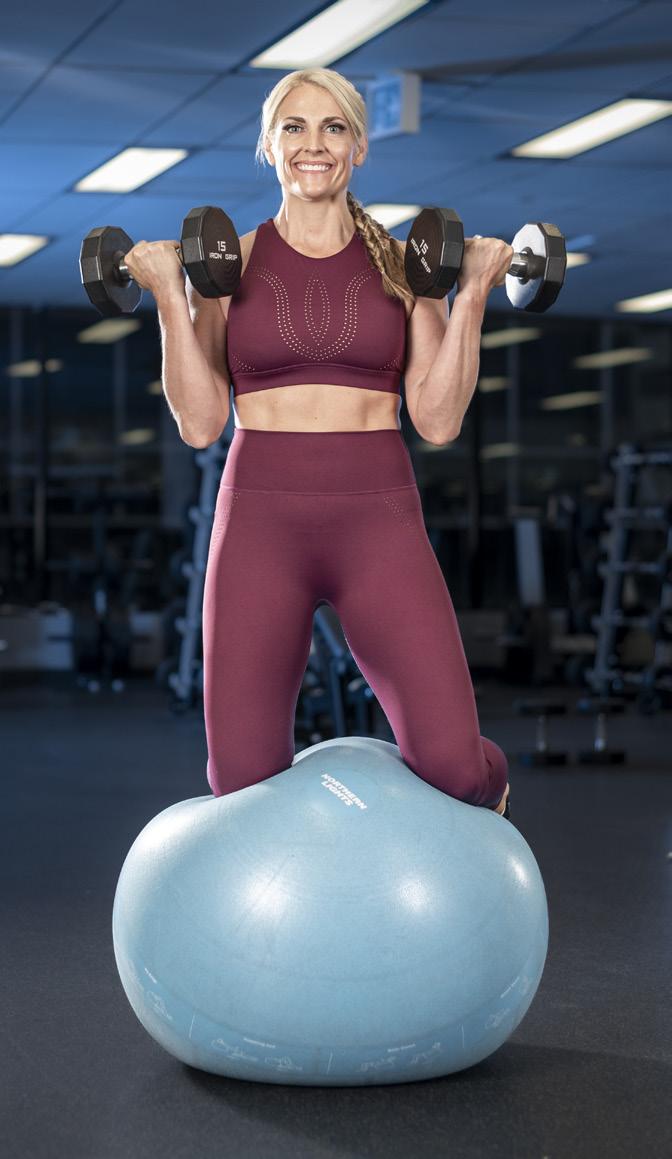
• Start with arms in a downward position resting on thighs, palms toward the body.
• Twisting palms forward, pull arms toward the shoulder to perform a bicep curl.
• Return to start position with palms towards the body.
• Curl with a controlled tempo 3 seconds up, holding and squeezing the bicep for 1 second on the top of the movement and 3 seconds down.
KEY POINT: Squeezing the abdominals and hips slightly back while performing this exercise will help with balance and stabilizing while on the ball. You can use a friend or a bench to help get onto the ball if you are doing the exercise for the first few times.


8-12 reps (side to side with a tuck is considered one rep)
• Start in a front plank with your hands on the floor, shoulders over your hands, abs engaged and body parallel to the floor (straight line). Place your feet on either side of the stability ball, lightly squeezing your feet together; this will activate your adductors to prevent your legs from slipping off.

• Keeping your core engaged, twist your hips to the right (like you’re making a rainbow). Touch your foot lightly on the floor and use your obliques to pull your hips back square and then over to the left side.
• For an added challenge at the end, bring your feet closer together on the top of the ball and tuck your knees into your chest after the side-to-side; lift your hips to the ceiling when you tuck in and return to a plank position on the ball.
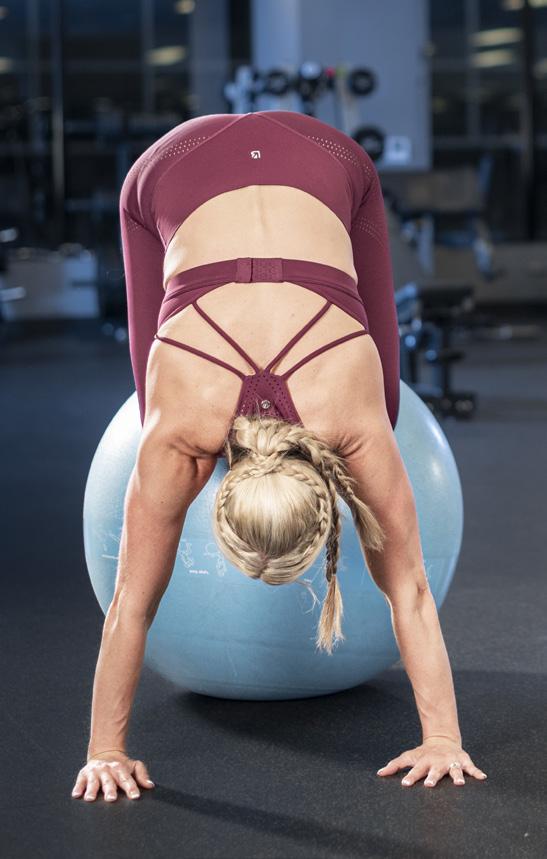
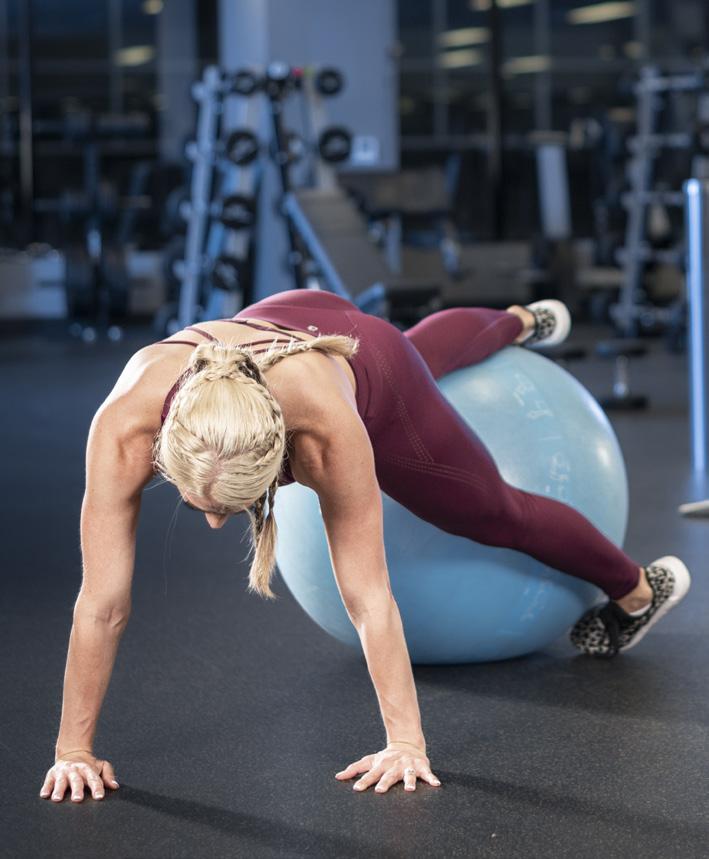
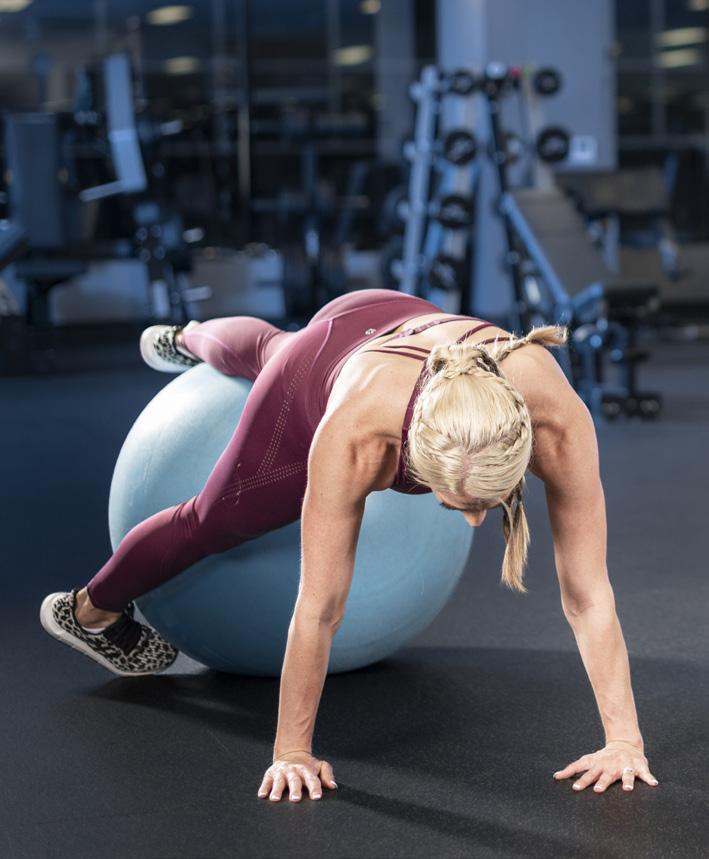

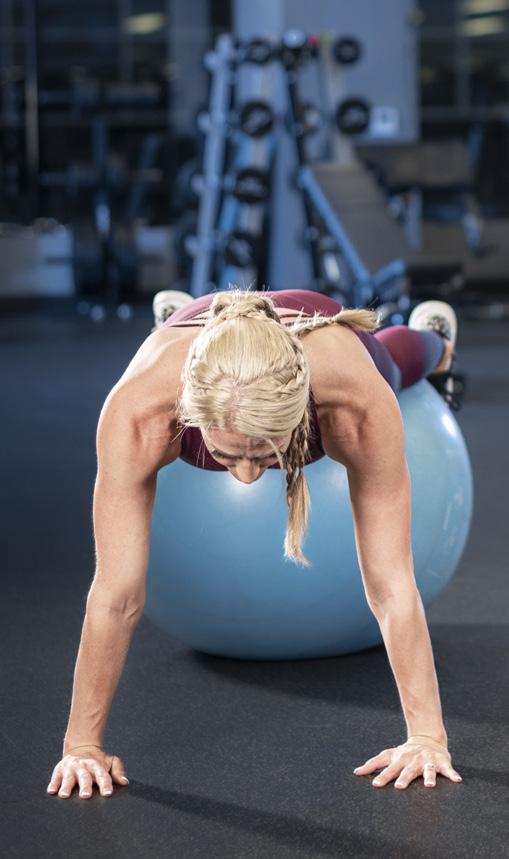
• Return to the starting position with feet on the sides of the ball.
KEY POINT: You can perform one set left to right and the other set right to left. Remember to keep hips elevated throughout the movement.
10-20 reps
• Perform this exercise with or without a weight or ball.
• Lay down on your back with the ball or weight overhead touching the ground, knees bent and feet planted flat on the ground.
• Hold the ball or weight as you throw your arms forward, sitting up and rocking forward to a low squat position.
• Stand up, hold for a second on top and return to the low squat position, laying back down to the start position with arms and weight overhead touching the ground.
KEY POINT: For beginners—or if this is your first time trying this exercise—you can use a small box to sit and lay on. The movements are the same but you have more cushion and support, making the exercise easier to perform. The box is also a great substitute if you have limited range of motion or flexibility in a low squat or if your spinal health is not as functional and you require more support through movement.
• Without using a weight or ball, your arms will need to move more quickly.
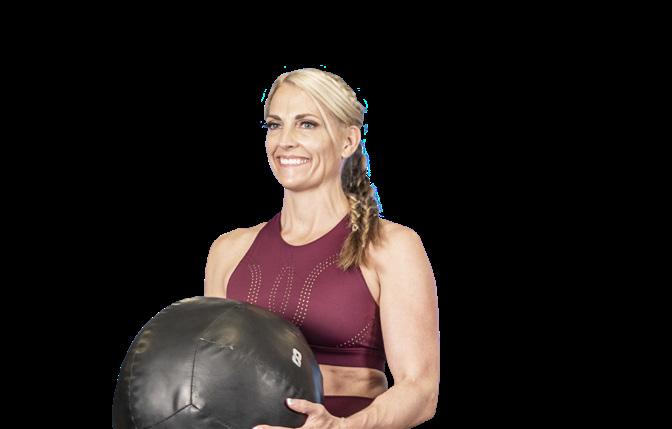
Get ready Calgary! With a massive facility expansion of over 50%, Vivo is just a few short months away from its grand opening

Vivo is a charity on a mission to raise healthier generations by inspiring a wholistic mindset for healthy living. And with that mission, Vivo is expanding to be a more inclusive, accessible and sustainable community and a place for all generations to belong.
And now, the wait is nearly over, with Vivo’s $60-million building expansion close to being complete. Vivo will be welcoming the community back with a partial reopening in January 2023, and the grand opening event just around the corner in April 2023. And Calgary, you’re going to love what they’ve done with the space!
Since 2012 Vivo has been asking the community what it takes to raise a healthier generation.

And with the community yearning for more social connection and deeper, more meaningful diversity and inclusion, Vivo has focused on creating a space where the community can grow together.
Get excited because this development is impressive. Vivo will be launching a first-ofits-kind indoor park and outdoor community hub, which will serve as gathering spaces. Enjoy the aquatic expansion with a six-lane 25-metre pool, sauna and steam rooms and an indoor lakeside experience with an ondeck fire pit.
Accessibility was an important consideration for the expansion, and Vivo has delivered with things like accessible equipment in the fitness centre and a fully accessible pool, complete with wheelchair ramp, pool lift, water wheelchair and more.
We’re not done. There will be enhanced accessible fitness opportunities like HIIT and yoga classes, boutique-style studios including a spin studio and dance studio, certified LEED Gold green building strategies, and a social innovation Collaboratory so the community can continue to bring its ideas to life.
Raising healthier generations can’t be done alone and magic happens when like-minded people, organizations, and communities take the time to share generously, listen openly, and make space for one another. Three levels of government have been instrumental in saying “yes” to community, and soon Vivo will be able to share this platform they hope will inspire and move you to take action to live your best life.
soon,
“Vivo has incorporated more balance and mindfulness in the new space.”
How four exercises can have a BIG impact on your training
BY IAN MCWALTER TODD DUNCANIan McWalter is one of Canada’s Top Fitness Trainers 2022, training and coaching at Elite Performance in Vancouver, B.C.

IANMCFIT IAN MCWALTER
WWW.IANMCFIT.COM
Even though I am slightly aging myself, the 90s smash hit All The Small Things, by Blink 182 serves as a great foundation for my training methodology. While I don’t suggest we treat our workouts like a love song, especially those that include breaking or tearing, the aforementioned song title echoes an important message which is a key factor in my approach—the impact of small and incremental changes to your training will translate into big results in the gym. Over the last 15 years as a coach, I’ve implemented the suggested variations to the following exercises with a wide range of clients, including celebrities, executives, athletes, even my own family , including my mother. By introducing simple modifications such as altering the grip, slowing down the tempo and elevating a single foot, workouts become varied, exciting, will recruit different muscles and overall help you obtain better results. This philosophy is the basis of the following routine, which will take approximately 30-40 minutes post-warm up. Now, turn on your favourite 90s playlist (no judgment!) and get moving!


3 sets x 8-10 reps - lower yourself to a count of 3 seconds
• Start with your weaker foot elevated (use a plate or low step approx 6 inches high) and dumbbells held by your side
• To descend, move your front knee down and forward. Think about the knee moving like an escalator, not an elevator
• Keeping your torso upright, try to get your knee past your toes and your back foot straight
• Push from your front foot back up to the starting position
KEY POINT: This is an amazing exercise to improve imbalances, and develop strength and mobility. The front foot is elevated to make it easier for the working leg. If you want to progress and make this exercise more challenging, remove the front step, meaning both feet are on the ground, and to up the ante even more, elevate the back foot only!

3 sets x 8-10 reps - lower dumbbell to a count of 3 seconds
• Start with a dumbbell held on your weaker side and raise the bench to 35 degrees

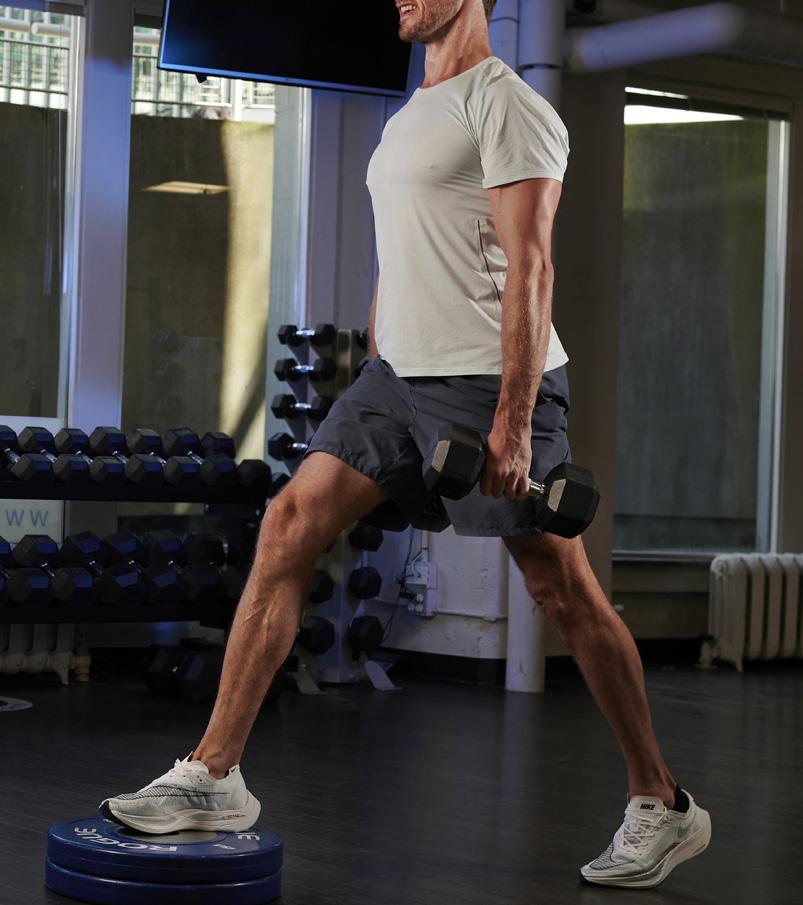

• Place one knee on the bench and the other leg out to the side and flat on the floor
• Keep your forehead against your forearm (shout-out to Kilo Strength Society for this technique) throughout the exercise and maintain a flat back
• Retract (squeeze) your shoulder blade and then row the dumbbell with your elbow going above your hip
• Lower the dumbbell, repeat until all reps complete and then switch sides
KEY POINT: Resting your forehead on your arm against the bench allows you to isolate the working arm more and increases neural drive of the muscle (creating a stronger mind-muscle connection).
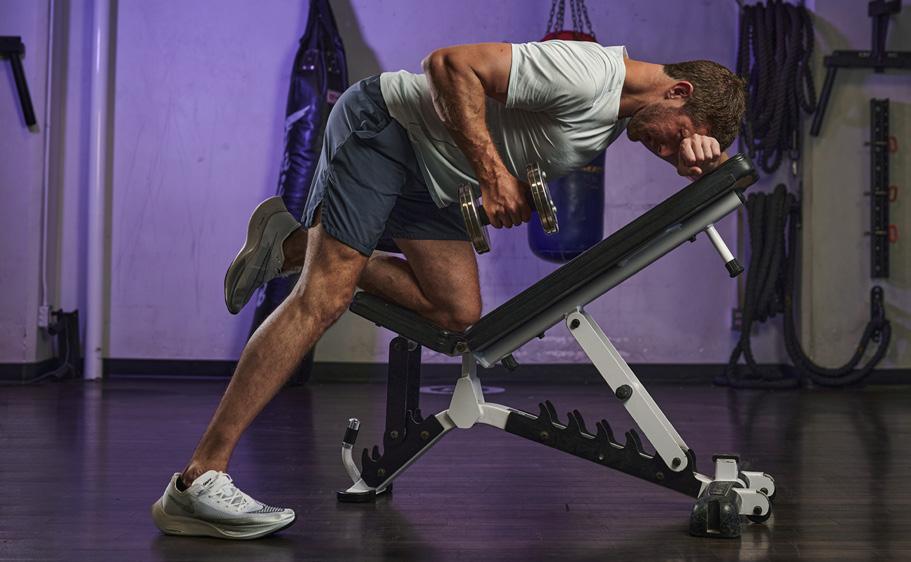
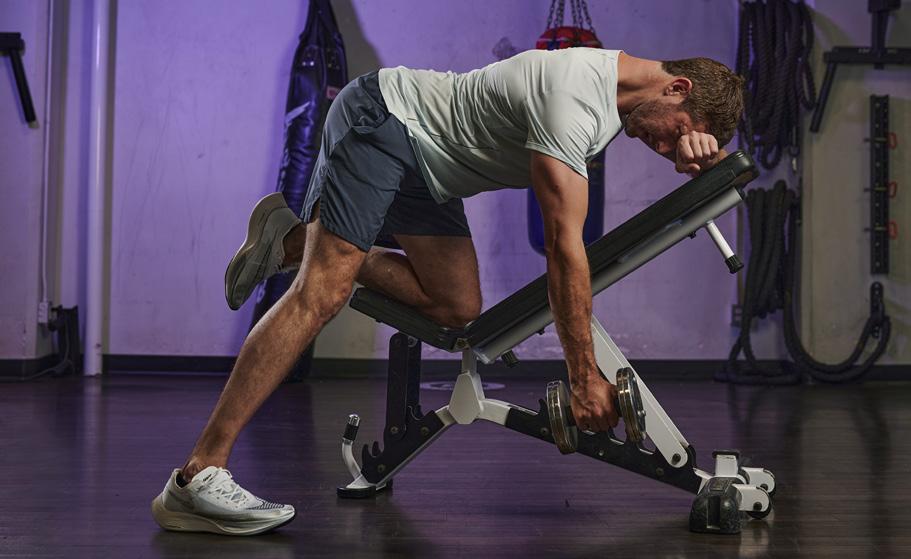
4

3 sets x 8-10 reps - lower dumbbells to a count of 3 seconds


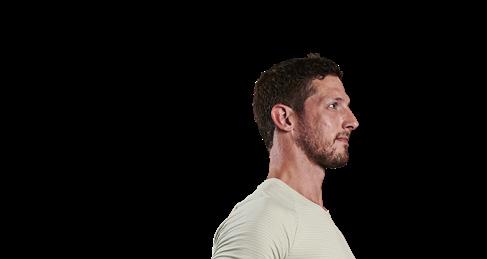
• Start with feet flat on floor, dumbbells held on either side of the body
• Brace your abdominals, bring your shoulder blades together and start to descend towards the floor by pushing your hips back
• Keep the dumbbells close to the body. Most importantly, maintain a neutral spine / flat back


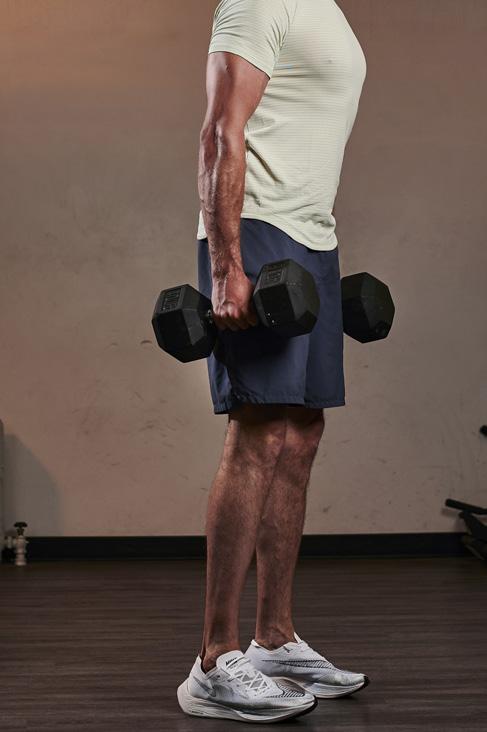
• Bring the dumbbells below the knees feeling a stretch in the hamstrings (back of the legs) and then return to the start position, without overarching the back at the top

KEY POINT: The RDL is an amazing exercise to develop strength and mobility for your posterior chain (hamstrings, glutes, lower back and calves) and can also help prevent hamstring injuries.
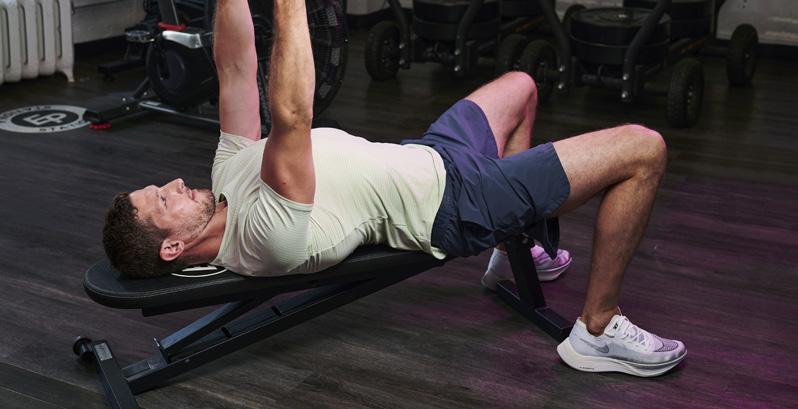
3 sets x 10-12 reps
• Start by sitting on the bench with the dumbbells on your thighs
• Lie back on the bench with the dumbbells, ensuring your feet are flat on the ground (if not, have a plate or something underneath them) with both dumbbells up and your palms facing each other

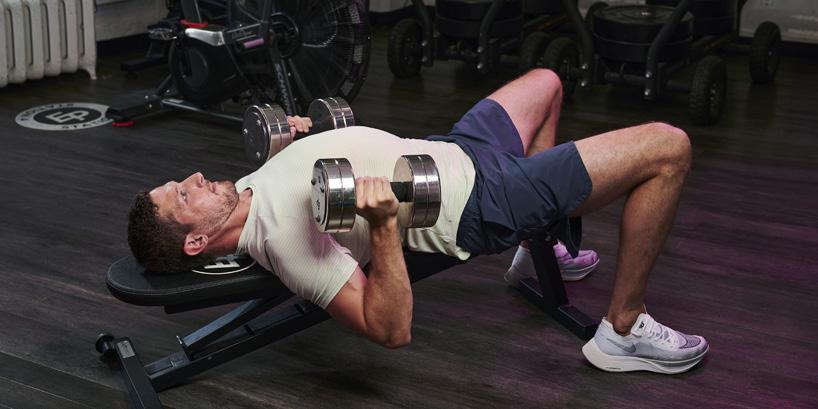
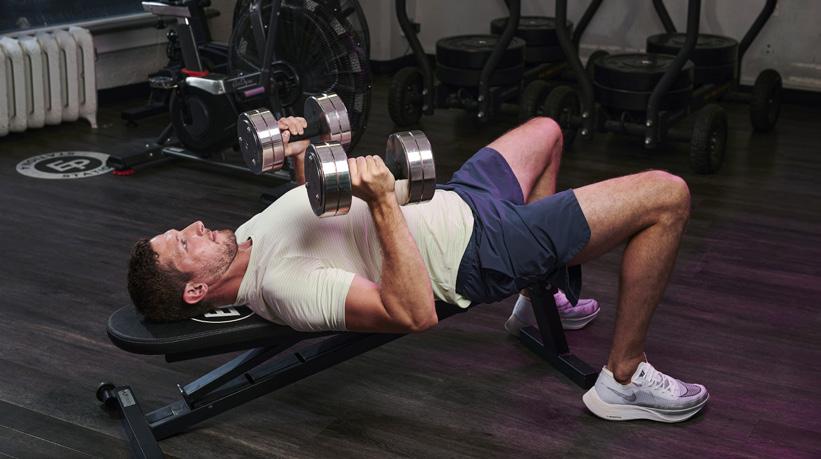
• Lower the dumbbells to fully stretched position at the bottom and then immediately lift again, but only partially (approx a ¼ of the total rep)

• Then bring the dumbbells back down as low as you can and then push out fully to the top - this range of movement counts as one rep
KEY POINT: By adding the quarter rep, time under tension (the amount of time the muscle is working) is increased. This causes a greater training response by working the muscle for longer.

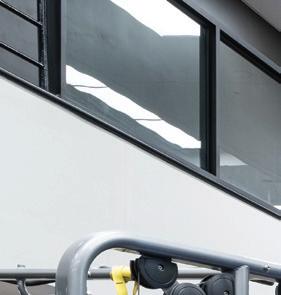

Calgary’s very own Fifth Avenue Club is one of Calgary’s longest running gyms in operation today. This newly renovated club is now UNDER NEW OWNERSHIP with local Calgarians, Rod Coulter and Leo & Charlotte King, who are bringing the already high standard up to current training trends and bringing in state of the art equipment.

With over 15,000 square feet, this facility is more than just a gym - it’s a community. Conveniently located in downtown Calgary, Fifth Avenue Club is a premium fi tness facility that sets the standard for friendly, personalized service.


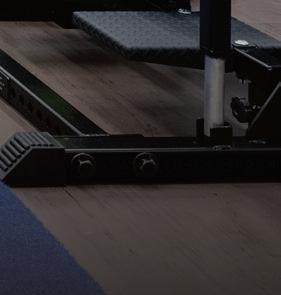
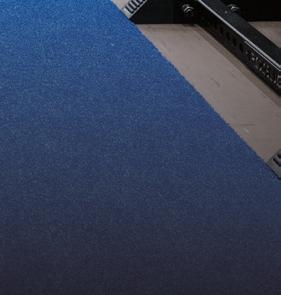


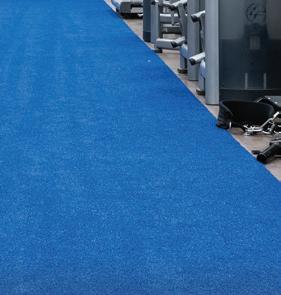

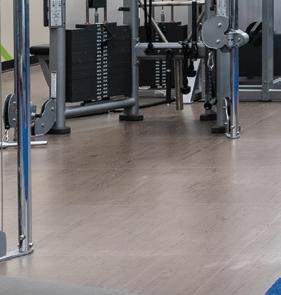
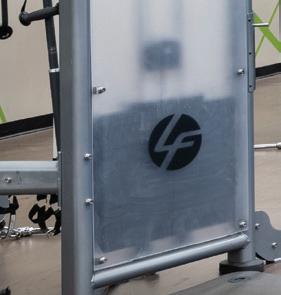
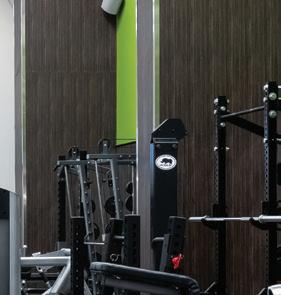





“We are passionate about building relationships with our members and meeting their fi tness needs with sincerity.”





In addition to the gym, there are two squash courts, a multi-purpose studio with group classes, massage therapy, personal trainers, luxury changing rooms with steam rooms/saunas and a fully stocked cafe (Juice & Java) proudly serving Rosso Coffee.
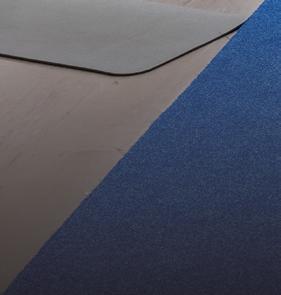



We pride ourselves on our friendly, knowledgeable and energetic staff! Our team selection process is rigorous, and the end result is an unmatched level of superior service in a comfortable and genuine atmosphere.

Now operating as a 24-hour facility, 365 days of the year, there is never an excuse to not workout, whether you need to take a break from the office, come in before or after work, or even on weekends & holidays, we have you covered.



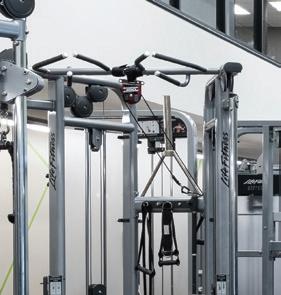


Our personal trainers have a diverse backgrounds and areas of expertise, will hold you accountable to your fi tness goals by providing knowledge, enthusiasm, motivation and inspiration.
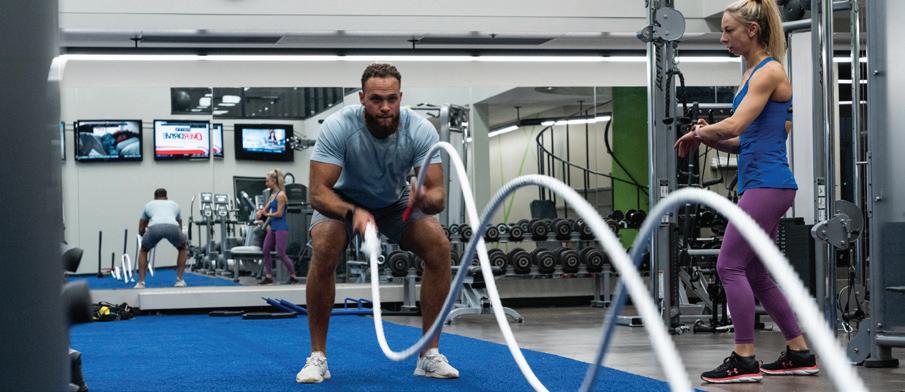

are excited to invest in the future and in the modernization of this amazing club.
While the pandemic created challenges for the fitness industry, research shows that there is now an increased desire to invest in fitness and health
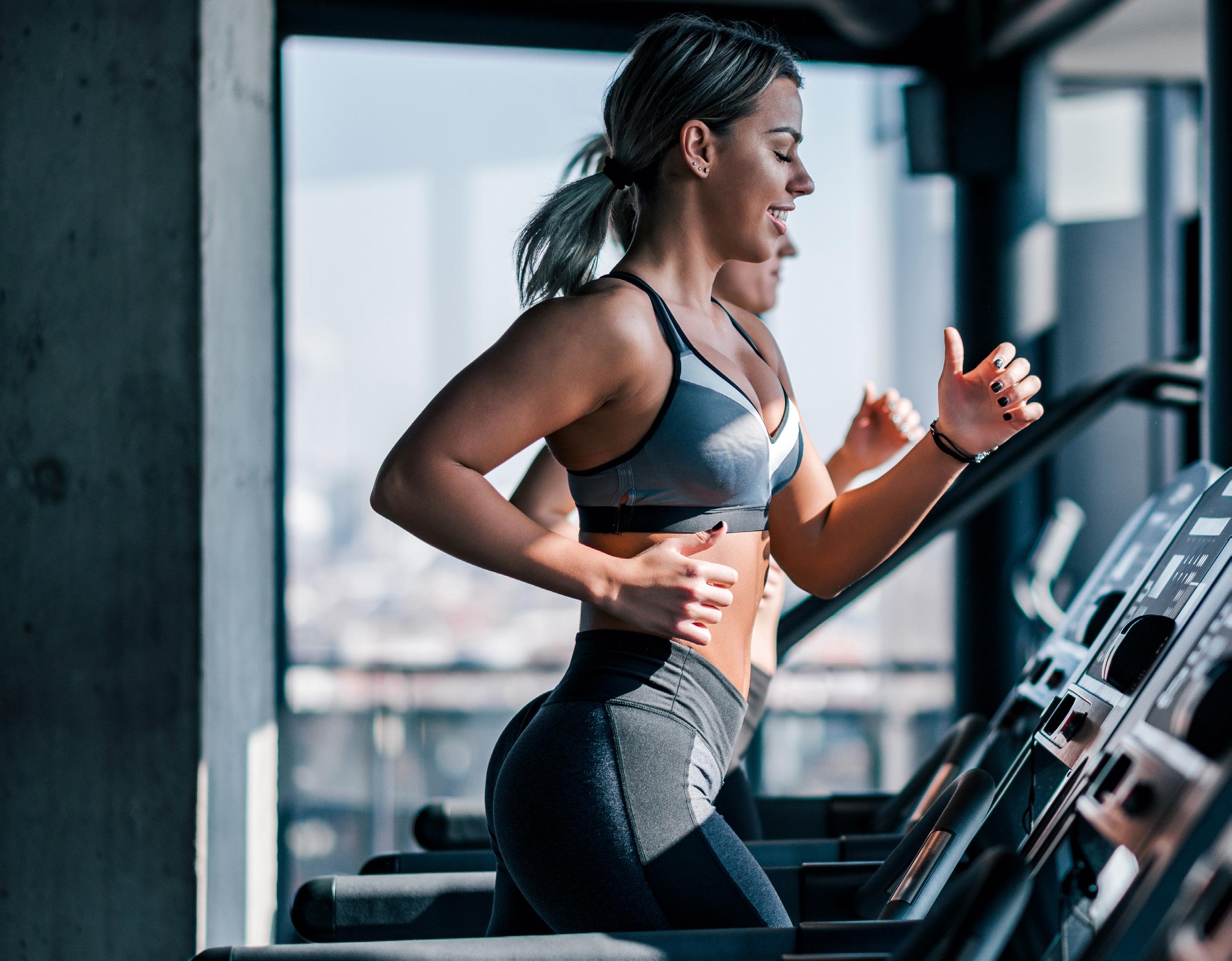 BY MO DEZYANIAN
BY MO DEZYANIAN
Founder and President of Empathy Inc., marketing professor at Centennial College, member of the Interactive Advertising Bureau of Canada (IAB) public policy committee, from Toronto, ON.
MO DEZYANIAN
Haveyou found yourself wanting to get away from the yoga mat or Peloton that sits in your dim basement? Is the scene at home a bit too crowded with family working remotely, or young children trying to nap? Do you find yourself passing by a gym or pool and telling yourself that tomorrow is the day you join?
Well, you’re not alone. Turns out, the Peloton or your yoga mat did not replace the gym.
If we use the average monthly workouts of Peloton subscribers as a proxy for how many times people work out at home, it becomes clear that home workouts peaked at the height of the pandemic. But this is now dropping, and those who have paid a good penny for home equipment are gradually going back to the gym.
The latest research from Empathy and Vividata suggests that the pandemic has caused fitness to become a necessity for most
The pandemic has changed how we see and value our physical and mental health. For many, fitness is indispensable, based on three motivators.
Physical: Enhancing appearance; losing weight; gaining strength
Emotional: Managing stress; improving sleep
Social: Meeting new people; being part of the community
compete with gym memberships. Some have already invested in a home gym and are comfortable with it, not wanting to return to fitness centres.
People seek fitness for three primary reasons: physical, emotional, and social. To cater to their clienteles’ needs, gyms must first understand their motivations and which factor is of utmost importance. For example, our research shows that people who feel insecure about their finances—especially as the economy turns around—indicate “fulfilling their emotional needs” as the top priority to be fit (31 per cent said yes versus 17 per cent said no to fulfilling their emotional needs. The balance had no comment).
Conversely, folks who feel secure about their finances prioritize physical reasons to go to the gym (64 per cent of financially comfortable folks prioritize physical motivators).
The issue of competing with home-gyms is at the top of the to-do list. Once again, our research suggests that there hasn’t been a gold rush towards home-gym purchases: investment in health/fitness equipment among Canadians just rose five points (from 25 per cent to 30 per cent).

folks. Many respondents (53 per cent) say the pandemic has increased their desire to spend money and time on physical fitness.
What’s most interesting is that this desire has happened across all socio-economic classes. For example, it is true for those who have identified themselves as being financially precarious (66 per cent versus 47 per cent of those who say they are comfortable in their finances).
This presents the biggest opportunity for the fitness industry. I believe the industry is at the cusp of a major boom—despite the looming economic downturn. Yes, people will tighten their belts as the economy slows, but after two years of the pandemic, fitness— mental and physical—has now gone from a luxury to a necessity.
"The last few years have changed the way we look at our health and the role the gym plays in our lives," says Sara Hodson, President of Fitness Industry Council of Canada. "Beyond a doubt, we place tremendous value in how social connection positively impacts our health.”
As much as fitness has become an essential part of everyone’s life, the choices for keeping fit have never been greater. At-home programs and equipment at various investment levels now directly
But people have different motivations to leave the house and go to the gym. It all depends on their circumstances. For example, most people seeking a new partner have missed the fact that gyms are better motivators to work out and potentially meet someone. While most of those who are worried about their finances just want to get out of the house, they welcome the distraction.
“We know that what you can get at the gym is more than a workout. You get community, accountability, and human connection. All of these are core values we have realized are essential for not only sticking to a routine but improving our lives,” adds Hodson.
It goes without saying that fitness is an important part of our lives, and the research suggests that more people are coming to this realization. As a result, we can expect fitness options—gym or at home—to become even more accessible and customized to individual preferences and lifestyle. Along with hybrid memberships, classes that are focused on holistic wellbeing— focusing on the mind and body—as well as “fun” group classes that incorporate a community vibe will become more prevalent.
For more information about Empathy’s research visit empathyinc.ca
We know that what you can get at the gym is more than a workout. You get community, accountability, and human connection.
All exercise is movement, but not all movement is exercise
 BY KATY BOWMAN NUTRITIOUS MOVEMENT
BY KATY BOWMAN NUTRITIOUS MOVEMENT
Bestselling author, speaker, biomechanist, and a Movement leader changing the way we move and think about our need for movement, from Carlsborg, WA.
The body needs a lot of movement to keep it working well. Just like a well-balanced diet includes different foods, each with their own necessary nutrients, a well-balanced movement diet includes a variety of movements that challenge all of our parts—and we have a lot of parts!
We all know the term cross-training. Cross-training is an exercise technique that calls for a variance of exercise type (and sometimes a variance of the way you do one type of activity) to improve the body’s response to exercise and decrease injury. Cross-training is often recommended by exercise and therapeutic professionals because being strong or healthy in one specific way doesn’t transfer over to being strong or healthy in every way. For example, if you’re a kick-ass runner and you run all the time and you run easily and without pain, your body is probably very adapted to the tissue strengths necessary to run. But say you help a friend move and in lifting a few boxes you are thrown out of commission for a month with a major back spasm. Weren’t you strong? Weren’t you in shape? Weren’t you a regular mover, and doesn’t that mean you were conditioned to move?
The answer to all of these questions has to do with the Law of Specificity, which dictates that you get better at what you do and not better at what you don’t. A particular way of moving creates loads and adaptations in only the tissues pulled and pushed and compressed by that activity. The more you do the same thing repeatedly, the stronger some areas of your body become. As with any kind of material—cloth, metal, wood—strength in one area increases the relative weakness of the surrounding areas not strengthened. Having strong, regularly-used parts next to underused (or overused) weak ones can actually increase tissue damage by creating a natural stress riser. The more parts you integrate into your movement, the less disparity between parts. This is why experts have recommended changing up your workout (i.e., cross-training) for years:
to close the strength gaps that live between the exercises you do and exercises you don’t.
The gap between what you are physically doing right now and what your body can do is vast. Typically, cross-training is applied to your workout: “If you usually run, you should throw in some strength training,” or “If you are a cyclist, you should balance your workout with yoga.” Again, the sentiment is correct. Look at what you are doing and then round out the loads applied to the body by doing something different. The problem is most of what we do for exercise is just slightly different versions of the same kinds of motions.
our exercise session to the frequencies of movement, ranges of motion, and the way we load our body throughout the day, every day, over a lifetime.
Exercise is one type of movement. Exercise, by definition, is planned, structured, repetitive, and purposive in the sense that improvement or maintenance of one or more components of physical fitness is an objective. We tend to have preferred modes or types of exercise— running, biking, pickleball—that use particular parts of our body and increase our physical fitness. But even the most diligent exercisers can still be sedentary the rest of the day and can have many stiff and underused body parts right next to the parts used for their favourite activities.
There is rarely uniqueness to what we do, and even routines designed to recruit more of our bodies often fail to do so because our movement patterns are so ingrained that we don’t perform the program’s movements as intended. Moving differently requires an inordinate amount of mindfulness, and once we forget to pay attention, we automatically default to the same pattern and go back to increasing the difference between one and every other area of our body. We go back to making stress risers. To determine where we move a lot and where we move a little, we must look beyond
How do we deal with our sedentary parts? Instead of just balancing your workouts over the week with different modes of exercise, you can “cross-train” your movement over the day. If your exercise session is surrounded by hours spent sitting in a car, at work, and at home, work to reduce that repetitive “chair” input. Forgo the car for an easy walk to and from the store for groceries and give your cycling or swimming legs more weight-bearing time. Lots of exercise tends to be leg-heavy. Look for opportunities to carry. Holding a bag of groceries or library books is a quick core and arm workout, but there’s no “exercise mode” or need to step away from your other daily to-do list. Sitting on the floor when taking in your evening Netflix or while working on your computer—legs crossed, in a V-shape, and then straight out in front—gets the hips and knees some of the recovery stretching they can use, extra time not required.
Keeping a body moving well requires regular movement that’s distributed both throughout the body and throughout the day. Swaddle your exercise time with more dynamic activities of daily living so that a workout isn’t the only peak on the “how much did I move today” graph, and the bulk of your non-exercise time isn’t shaping your tissues into the same use patterns repeatedly.
The answer to all of these questions has to do with the Law of Specificity, which dictates that you get better at what you do and not better at what you don’t.
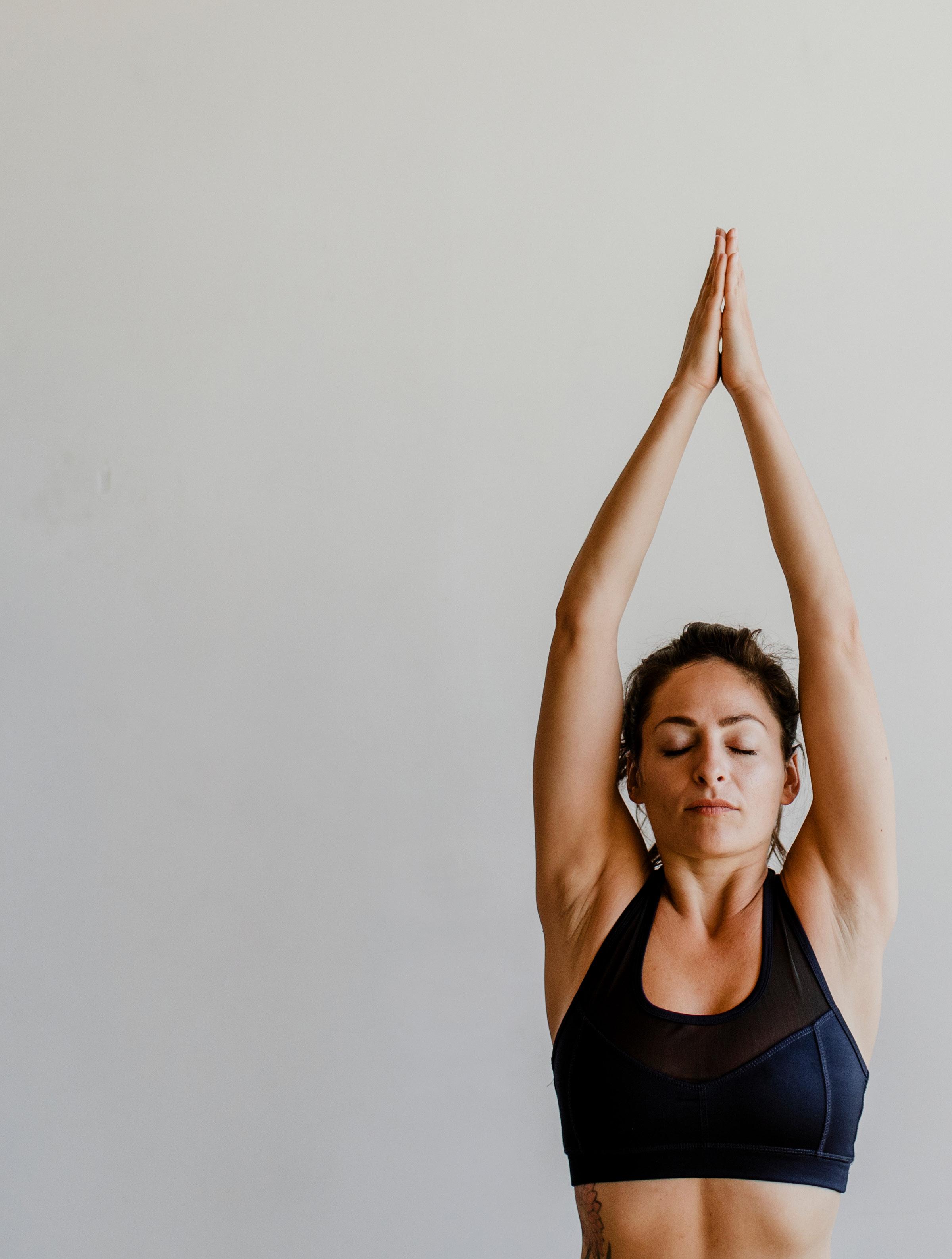 BY ANDREW MCGONIGLE
BY ANDREW MCGONIGLE
Teaches anatomy and physiology in yoga teacher training courses internationally,
runs his own yoga anatomy online course, from Los Angeles,
There are many “old wives’ tales” that tend to spread like wildfire through the yoga community. Does practicing headstand stimulate the thyroid gland? Does twisting the abdomen help the liver detoxify? While not everything has to be evidence-based or quantified, I believe in the importance of trying to separate theory from fact, particularly when making bold claims about how yoga can improve our health or even help us to recover from illness and injury. Here, I examine three specific claims about yoga’s impact on our physiology using insights from scientific research.
Detoxification is the physiological processes through which the body identifies, neutralizes, and eliminates toxic substances and metabolic byproducts. Detoxification is an essential part of homeostasis, and our bodies naturally possess the capacity to perform these processes very effectively. Without an effective detoxification system, we would be very unwell. ➝
W

work with people of all shapes and sizes but we love working with clients who want to fight ageing every step of the way,” says One on One owner Sandra Bueckert (pictured below).
great equalizer and at 56, I’m a part of the resistance.”
“I chose One on One many years ago as I wanted to gain muscle and become stronger,” says Elizabeth Walsh, a 20-year client. “I knew the best way for me was to be with experts and to have appointments I would not miss.”
There are no fads or gimmicks at One on One. It’s the home of sweat equity. Workouts for clients looking to reach their goals online or in-person are by appointment only.

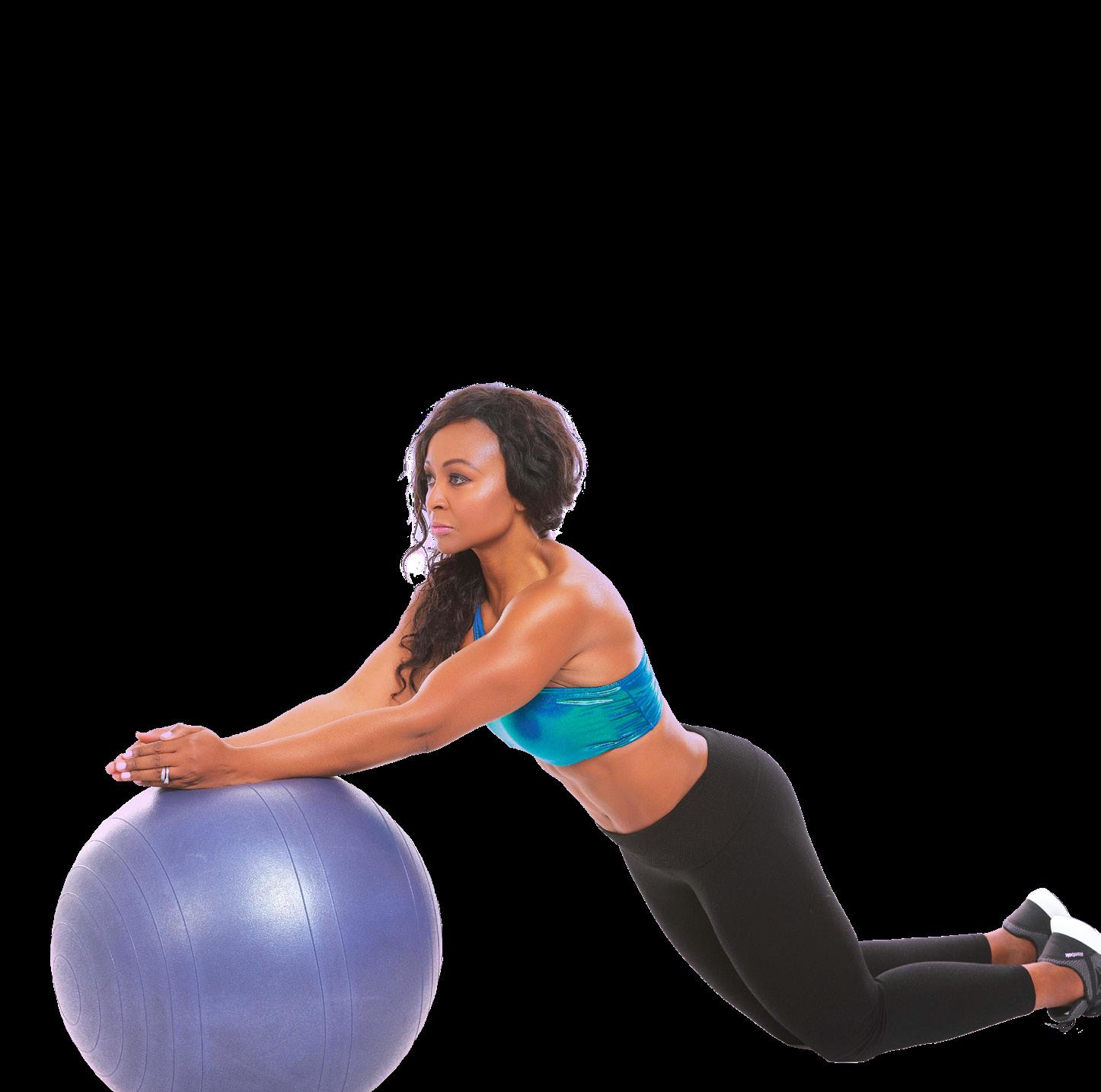

“Every client has different goals and different issues to consider. We get it.
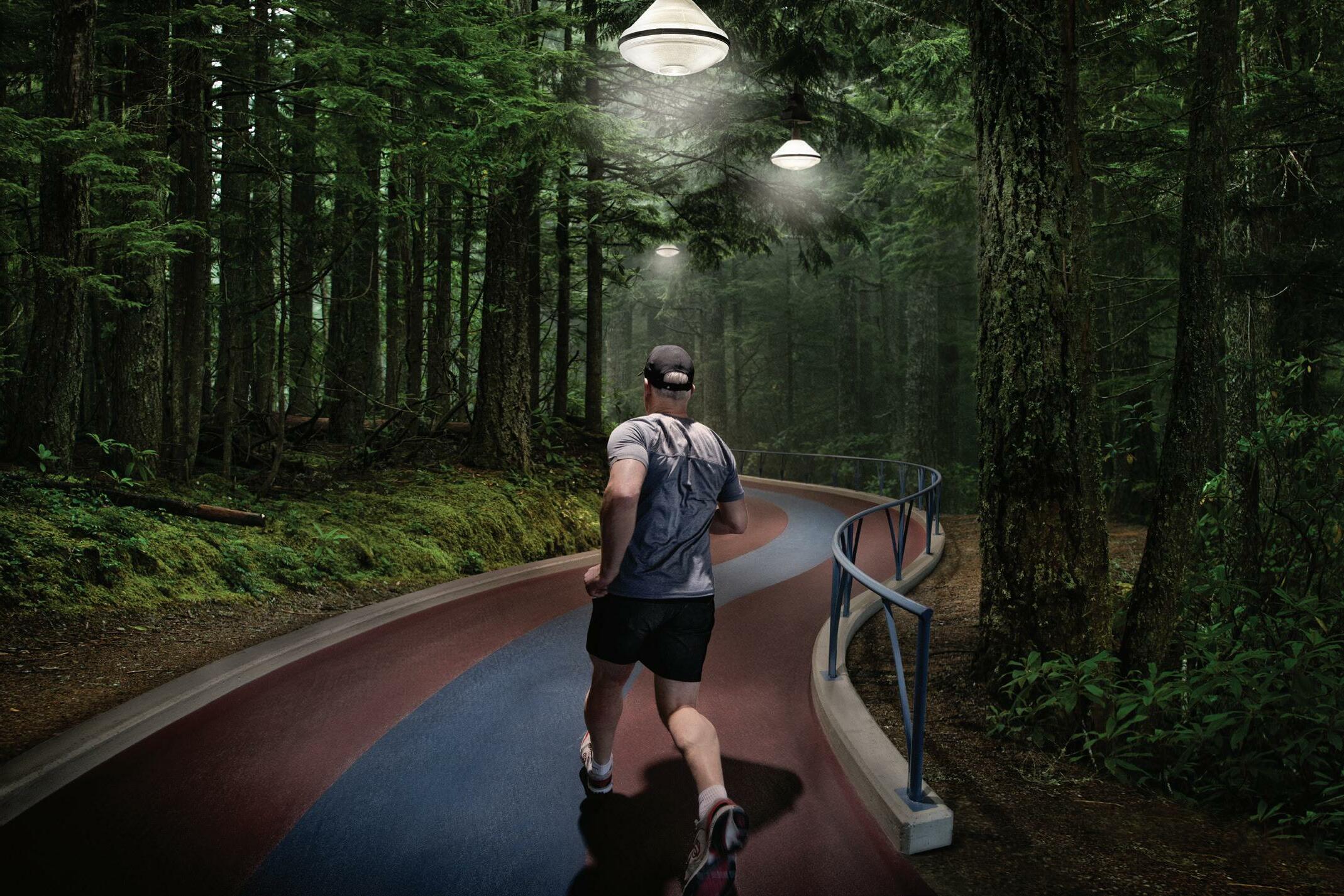
Sweat glands are often perceived to play an important excretory function, similar to that of the kidneys. However, research has concluded that the role of the sweat glands in eliminating waste products and toxicants from the body seems to be minor compared with other avenues of breakdown (liver) and excretion (kidneys and gastrointestinal tract). Studies suggesting a larger role of sweat glands in clearing waste products or toxicants from the body (e.g., concentrations in sweat greater than that of blood) may be an artifact of methodological issues rather than evidence for selective transport. Nevertheless, studies have shown that perspiration plays a role in skin hydration and microbial defence.
So, it appears that heavy sweating in a hot yoga class or in a sauna might not help us to relinquish all those perceived toxins after all. However, the good news is that practicing yoga as part of a healthy lifestyle will allow our kidneys, liver, and gastrointestinal tracts to continue to work optimally.

There is widespread belief that inverting the body during asanas such as the headstand has many potential benefits from increasing blood flow to the brain to stimulating the pineal gland.
The brain has the very important ability to maintain relatively constant blood flow despite changes occurring elsewhere in the body. In healthy adults, large changes in blood pressure result in little or no change in cerebral blood flow. This mechanism of autoregulation of cerebral blood flow is vital since the brain is very sensitive to too much or too little blood flow. Only in severe head injury or acute ischemic stroke do we lose this autoregulation, leaving surviving brain tissue unprotected against the potentially harmful effect of blood pressure changes. So, it is reassuring to know that whether you regularly invert your body or not, your brain is receiving just the right amount of blood supply to meet its demands.
One physiological process that inverting the body can help with is venous return. Blood is easily pumped to our lower limbs from the heart via large arteries; however, returning blood to the heart is not such an easy process. The walls of the veins are considerably thinner, and their hollow passageways (lumens) are correspondingly larger in diameter compared to arteries, allowing more blood to flow with less vessel resistance. But by the time blood has passed through capillaries and entered venules and then veins, the pressure initially exerted on it by heart contractions has diminished significantly. While arteries can constrict
quite dramatically, veins only stiffen. The venous system is also normally working against gravity to return blood from the lower limbs to the heart. Inverting the body causes a transient increase in venous return. Therefore, incorporating yoga asanas such as bridge pose or legs-up-the-wall into a yoga practice can have an impact on venous return.
It is commonly claimed that yin yoga works on the connective tissues of the body, particularly the fascia, the thin casing of connective tissue that surrounds and invests all muscles as well as every other organ, blood vessel, bone, and nerve fibre. But does yin yoga, wherein poses are often held for three to five minutes, really target the fascia?
Participants in a yin class are often asked to release all muscular tension and relax into the pull of gravity, whereas participants in a vinyasa class might be asked to co-contract antagonist muscles or core muscles. No matter what instruction is given, a stretch is a stretch—and a stretch is a tensile force on a muscle. When a tensile force is applied to a muscle, it is also applied to the surrounding fascia and invested muscle fibres and bundles. The muscle and fascia are so interwoven that you cannot choose which one you are stretching by contracting or not contracting certain other muscles.
It should be noted that as a stretch (or tensile force) is applied to tissues, they creep. Creep is the biomechanical term for the deformation of viscoelastic tissues. Once the tensile force is removed, tissues then recover and return to their original length, as long as they have not been elongated beyond their elastic capacity. One study looked at creep in the muscle–tendon unit of living humans during a 30-second stretch, finding that the greatest amount of creep was measured to occur within the first 15 to 20 seconds. Beyond that, to our knowledge, no studies exist on yoga poses and creep, which means we do not know the ideal duration for stretching tissues or how long tissues take to fully recover from their creep.
So, yes, yin yoga does affect the fascia of our bodies but not in isolation from muscles, and not any more than the same stretch performed in a different way (i.e., a more active way). Yin yoga, or any stretch held for three to five minutes, will affect the fascia, but the ideal frequency and duration remain a mystery.
ReproducedThe brain has the very important ability to maintain relatively constant blood flow despite changes occurring elsewhere in the body.










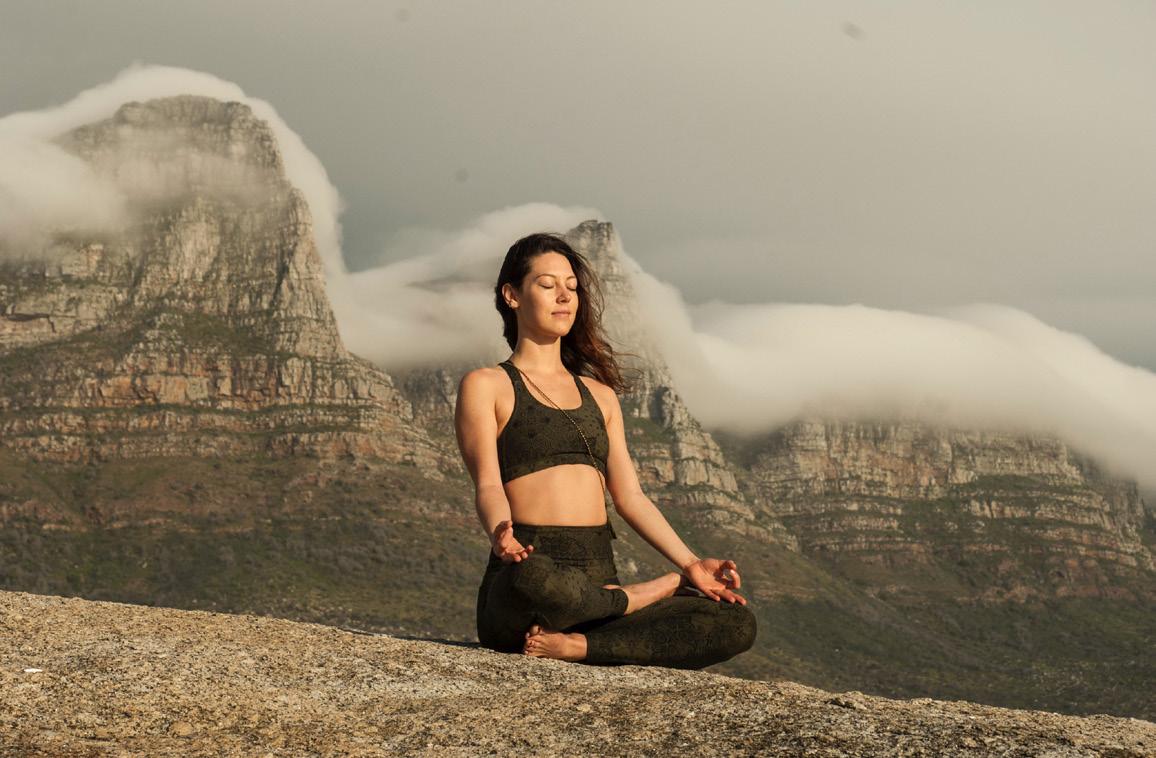

After discovering how a change in nutrition made him a better athlete, Brendan Brazier is now a leading authority on plant-based performance nutrition
BY LOUISE HODGSON-JONES SHIGGY ICHINOMIYA IMPACT guest editor, communications and event specialist in Victoria, B.C. LOUISEHODGSONJONES LOUISEHODGSONJOBrendan Brazier always knew what he wanted in life. At home in North Vancouver, B.C. at age 15 he took up running so he could become a better hockey player. When he discovered he loved running he knew he wanted to run professionally and make a success of it. To do that he needed an edge. He started experimenting with his nutrition, realizing that a speedy recovery from a workout or race was the key ingredient in his training.
“I was looking for that advantage and became obsessed with my body to renew and regenerate myself as quickly as possible,” he recalls. “I tried different ways of eating; then I tried plant-based food, but I was always hungry.”
Over the years he kept experimenting, making many mistakes along the way, often relying on too many carbohydrates and not enough nutrients. Then he did some research on different plants, which back in the 1990s was a challenge as there wasn’t a lot of information available. But he did realize he was missing three essential nutrients—omega, calcium and iron.
“I started to make blender drinks. It was efficient and easy to digest and would fill me for hours.” He continued to experiment adding hemp, flax, pea and rice protein but he was constantly feeling tired with low energy. Then through a chance encounter with a Vancouver businessman, Charles Chang in 2003, he discovered maca, a root vegetable that has properties to aid adrenal fatigue. He immediately noticed a difference.
Brazier and Chang collaborated on the ingredients, producing a plant-based drink powder and in 2004, Vega the multi-million-dollar company was founded. “Vega was marketed to busy people who wanted to feel good, and not necessarily to vegans,” Brazier said. The product was an instant success and when they sold the company in 2015 it was bought for $500 million U.S. ➝
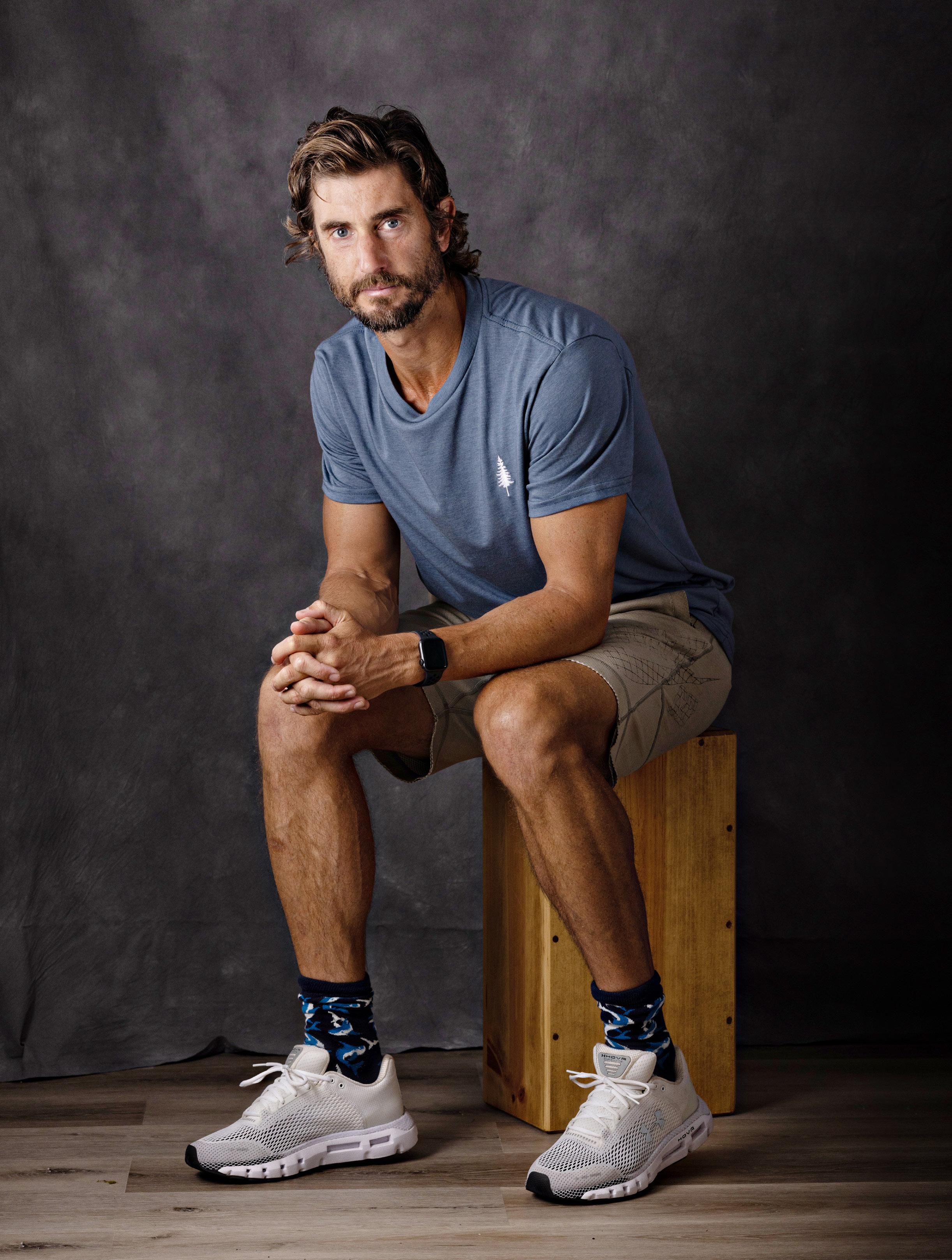
Brazier, 47, was a track runner in school and loved running the trails near his home in North Van’s Lynn Valley. Seeing more opportunities to race professionally, he became a triathlete, which he did for seven years, making enough to live on but not reaching the top tier. But he is fine with that. “I was never competitive, I competed because I enjoyed it and wasn’t there to win.” He entered his first Ironman in 1998 in Penticton and regularly competed there until 2004. His love of trail running saw him take two Canadian 50-kilometre Ultramarathon titles—in Victoria, B.C. in 2003 and in Toronto, ON in 2006.
During that time he helped some of his NHL and NFL athlete friends with their nutrition, not intending to make a career out of it but just to help them perform better. “It was very casual. I would help them with tips if they asked.”
During his sports career he would spend hours writing his recipes; he accumulated over 1,000 he says. “I would go back to them and see what I ate for a particular race and if it worked I would use it again.” His diet switched from pasta and refined carbs to buckwheat, amaranth, quinoa and sprouts all containing essential enzymes and probiotics.
“Food takes a lot of energy to digest. If your digestion is as efficient as possible and you are taking in nutrition without expending energy, then you can spend that energy working on recovery and regeneration.”
His recipes were the basis of his first book The Thrive Diet: the whole foods way to losing weight, reducing stress, and staying healthy for life, published in 2007. Containing over 100 recipes of plant-based food options, the book also features exercise-specific recipes for pre-workout snacks, energy gels, sports
drinks and recovery foods. “I would get asked about being a vegan and so this book stemmed from that.”
Many books followed including Thrive Fitness: The Program for Peak Mental & Physical Strength and Thrive Foods: 200 Plant-Based Recipes for Peak Health. He also was editor-in-chief for Alive magazine and his own publication: Thrive.
Brazier moved to Venice, CA in 2008 and has immersed himself in the community and culture, investing in numerous enterprises. “I like to invest in companies that are making a difference,” he says.
One such company is Pulp Culture, a collaboration with fellow Canadian Mark McTavish. Inspired by fermented apple juice found in the Basque region of Spain, Brazier and McTavish have developed a light alcohol beverage from fresh juice that naturally ferments over three months. Going through a “wild fermentation,” the drink has no sugar or additives but has probiotics and B vitamins, and is just 100 calories.
Brazier has kept his Canadian connections and still works with Chang as an investor and advisor for Lyra, a brand marketing company in Vancouver. He also supports innovative plant-based products such as LOCA, a cheese source made from potatoes; Super Mush, a mushroom mouth spray; RISE, a Kombucha made in Montreal, and Thrive Market, an on-line market for organic goods.
He has also dabbled in film production on the ground-breaking movie The Game Changers, which put the spotlight on several elite vegan athletes and their reasons to adopt a plant-based diet. He was an executive producer with a number of celebrities including James Cameron, Lewis Hamilton and Novak Djokovic.
Brazier’s passion though is in food and
the environment and ensuring nutrient dense ingredients are available to everyone. Enter Fiction, his new company under development—it will be launched next year—which brands itself as a ‘solutions company expressed through food.’
Summing up Fiction’s philosophy, Brazier says, “It’s about the nutrient to resource ratio, looking at land, water, and the amount of fossil fuels that we use in relation to the vitamins and minerals, antioxidants and protein that’s produced. It’s about spending the least amount of natural resource and getting the most nutrition back. It’s finding the efficiencies in the food system which help solve environmental and health issues, making sure people get enough nutrition as there are so many foods out there that don’t provide that.”
When launched, his Fiction products will include ingredients such as beta gluten from euglena (protozoa) to boost the immune system, DHA omega from algae to maintain brain health, plant sterols to reduce LDL (bad) cholesterol, and MCT oil, from euglena, to improve fat metabolism. These combined, he says will boost the ability to perform, mentally and physically.
Brazier has been a vegan for over 30 years and has his favourite foods. Sprouted bread, avocado sandwiches, arugula, greens, lentil pasta, tofu and tempeh are included in his plan. Does he see himself as a pioneer? “There were others like me, Dave Scott, the triathlete, was vegetarian so I wasn’t the only one,” he says modestly.
Although not competing any more he runs regularly and mountain bikes. He isn’t interested in races, preferring to skip the crowds and spend hours on his own. “I love the pureness of running.” Every November he goes to New York, not to run the official
If your digestion is as efficient as possible and you are taking in nutrition without expending energy, then you can spend that energy working on recovery and regeneration.
marathon course, but run 42.2 kilometres just to challenge himself.
He works out regularly at his local Gold’s Gym, which he calls a ‘classic gym.’ (Venice Beach was the first location for Gold’s in 1965 and made famous by celebrities like Arnold Schwarzenegger). “If I don’t lift weights I get too light, so I have to ensure I build muscle.” But he doesn’t have to worry about his weight and eats when he is hungry. He does have one craving though. “There’s nothing like a bag of potato chips after a long, hot run.”

Does he have any advice to anyone considering taking up a plant-based diet? “Start gradually and introduce new things into your diet. You don’t have to cut out meat and dairy right away. For me it started with those blender drinks, and I didn’t feel like eating as they were satisfying. Your palate will change—that’s what I noticed— and if you go back to have any dairy or meat you will find they don’t appeal because your taste senses have changed.”
Brazier feels that meat consumption in North America will decline over the years as people experiment with plant-based options. “Fake meat has its place if done well as people are transitioning.” He gives an example of a company out of Colorado making ‘steak’ from mushroom roots. “It’s companies like this that are creating great culinary experiences. They aren’t trying to be meat, they are trying a different way of making a nutritious, protein product.”
Brazier may not think of himself as a pioneer, but he was a trail blazer in his time. While in his early years he focussed on how he could become stronger and more efficient, he is now putting his energy and passion into helping others to become socially responsible about food efficiency and production.
n 1991, eleven years after Terry Fox’s legendary Marathon of Hope—and a decade after the Canadian hero died of cancer at age 22—his older brother, Fred, ran his very first marathon.

Like Terry and their two younger siblings, Fox had been athletic since his youth in the lower mainland of British Columbia, running cross-country and playing basketball, soccer, and baseball. But he hadn’t run the distance his brother,
just 14 months younger, was famous for running—the distance his brother ran every day for 143 consecutive days, starting in St. John’s Newfoundland and clocking over 5,300 kilometers with his artificial leg until cancer spread to his lungs, forcing him to give up his cross-Canada odyssey in Thunder Bay.
Fox remembers his first marathon in 1991 well. It was a hot, sunny day in Seattle in July. He finished the race, he recalls, but
he suffered through the last five miles.
“The whole time through that marathon, Terry was on my mind,” he says. “You really got a bit of an idea of what he must have been going through every day.”
More than 30 years later, running is still part of the 65-year-old’s fitness routine. You will find him hitting the pavement near his home in Maple Ridge, B.C., 12 months a year, six days a week, usually in the morning around 6 a.m.
Fred Fox runs not just for himself but to keep his brother's memory alive
“I think you're the first person I've ever said this to,” Fox tells me, “but I think of myself as a bit of a late bloomer when it comes to fitness. As I've got older, I think I've become stronger in my perseverance and my will to get things done when it comes to running.”
Athletic pursuits feature prominently in his life. He cycles long distances, curls competitively, lawn bowls (the newest addition to his fitness regime), and hikes
regularly with his two golden retrievers, Scout and Harper, named in honour of his favourite book, To Kill a Mockingbird.
And of course, he runs.

He last ran a marathon in Eugene, Oregon, when he turned 60 in 2017. He will run the same marathon again in April 2023, to commemorate his 65th year.
Running has helped him stay connected to his brother as well as continue Terry’s important work of raising money for cancer research.
The inaugural Terry Fox Run was held in September 1981, three months after Terry’s passing. This year’s will take place on September 18, after a two-year hiatus due to the COVID-19 pandemic. Fred hasn’t missed a run in the event’s 42 years.
Each year, around 650 Terry Fox Runs take place in communities across the country, and more than 10,000 schools host a run, all with the aim of furthering Terry’s goal: to raise money for cancer research and improve the outcome of a cancer diagnosis.
Since its founding, the Terry Fox Foundation has raised more than $850 million through fundraising initiatives like the Terry Fox Run. At a pace of about $25 million every year, Fox estimates they’ll hit the $1 billion mark in five or six years.
“It's amazing,” says Fox, who serves on the executive leadership of the foundation. “None of it happens without so many people over 42 years, so many volunteers,
supporters, and donors. It’s been amazing how people have responded all these years later, how new generations are responding to what Terry did in 1980.”
The funds raised have helped medical researchers make strides in finding a cure for cancer, giving hope to many cancer patients. Significantly, the Terry Fox Foundation brings experts together to collaborate on research through the Marathon of Hope Cancer Centres Network.
“That's the biggest impact Terry had: bringing some of the best researchers in the world together to make new discoveries to find a cure for cancer,” Fox explains.
Terry has always been known for bringing people together. He rallied a country during his Marathon of Hope; he brings communities together for Terry Fox Runs; and he unites people in the hope that there will be cure for cancer.
His story embodies his core message that “anything is possible if you try.”
It’s that willpower of Terry’s that sticks with Fox through every dollar he helps raise, every step he takes.
“I think the biggest thing that we've been able to accomplish over the years is keeping Terry's message current,” he explains.
“He’s an inspiration every day. When you're out there for a run, and you're running up a hill, and you don't know if you're going to be able to finish it, Terry's always on your mind.”
It’s been amazing how people have responded all these years later, how new generations are responding to what Terry did in 1980.
Tréchelle Bunn is hoping that her fundraising half-marathon on Truth and Reconciliation Day will inspire others to reflect and look to the future
BY COLEMAN MOLNAR TIGGY ARACanadian writer and journalist. Find him wherever there is sunshine and Wi-Fi, from Vancouver, B.C. LIETCO
Perched on the top of a hill overlooking the small Manitoba community with which it shares its name, the Birtle Residential School is hard to miss. The “Stone School” was built in 1882 and operated for 90 years under the guise of ‘educating’ the area’s Indigenous youth. In reality, the location—like many other such residential schools across the country—was the headquarters for the Church’s attempt to whitewash First Nations culture in Canada.
Both of Tréchelle Bunn’s greatgrandparents attended the boarding school, and today years after their passing, the Chan Kagha Otina Dakhóta Oyáte nation member is honouring their harrowing experience by organizing the inaugural Reconciliation Run Half-Marathon to be held on September 30, Canada’s Day for Truth and Reconciliation. Bunn, members of her community and university, along with anyone else who’d like to participate, will mark the day by doing what her Kunshi (great-grandmother) Mildred and Unkan (great-grandfather) Donald weren’t able to do all those years ago: run away from that terrible place.
“I remember the first time my dad took me to Birtle Residential School,” says Bunn, a criminology student at the University of Manitoba, member of the school’s varsity hockey team, and hopeful future lawyer. “I was probably 10 or 11 and he was explaining to me what had happened there, and I remember just feeling really sad and heavy. I still have the same feelings to this day.”
Following the discovery of hundreds of unmarked children’s graves at residential schools in Kamloops, B.C., and Marieval, Saskatchewan, Bunn, in July 2021, organized a Healing Walk from the school to her community located 26 kilometres away.
“As an athlete and an Indigenous woman, I grew up with the belief of movement as medicine,” she says, speaking to IMPACT from a hotel room in Europe where her hockey team was touring. “It stuck out to me to do a walk because my Unkan Donald always said that when he was at the school he wanted nothing more than to just run away and go home. But, of course he saw what happened to his classmates and the consequences when they did try to run away, so he never
did make the attempt himself. That’s something I’ve always carried with me. Twenty-six kilometres feels like a long way, but when all you want is to go home to your family, 26 kilometres isn’t that far.”
Bunn says the walk was at once healing and sad, with many of the elders attending setting foot on the school grounds for the first time since they’d been forced to attend as students. One elder survivor performed a traditional pipe ceremony on the lawn of the school grounds. “Their purpose was to ‘solve the Indian problem’ and ‘kill the Indian,’ but us standing there that day proved that they failed,” says Bunn.
This year, the Healing Walk will become a run and will lead participants away from the Birtle Residential School grounds down a backroad and conclude 21 kilometres away at the Chan Kagha Otina Dakhóta Oyáte nation community. Bunn says she hopes the event will encourage Canadians across the country to reflect on their nation’s history on September 30.
“For so long our elders and the survivors were silenced and made to believe that their truth wasn’t worth hearing or wasn’t believable,” she says. “For me, seeing that
truth come to light and seeing the eyes opening in the non-Indigenous community and the rest of the world, it wasn’t confirmation for our community, it was confirmation for others that the stories being told by Indigenous peoples for so long are actually true.”
Bunn says she plans to run a portion of this year’s race relay-style with her hockey teammates and walk the rest with her community, including her grandparents Kunshi Pauline and Uncan Terry, both of whom are survivors of the Birtle Residential School’s day program.

She expects around 100 participants this year, including a number of Manitoba marathon racers and many members of her community, but hopes the event will gain steam, and perhaps even prompt other communities to organize similar walks or runs in future years.
Entry fees from the in-person and virtual event will go to cover the cost of organization, with extra funds being donated to the Aboriginal Health and Wellness Centre in Winnipeg. Visit reconciliationrun.ca to register or learn more.
As an athlete and an Indigenous woman, I grew up with the belief of movement as medicine.
I always felt that if I went through something and learned something, it’s meaningless unless I can pass it on.

How Robert Wong conquered multiple obstacles to achieve his ultimate goal of becoming a certified fitness instructor
BY SCOTT CRUICKSHANK LEAH HENNELA writer covering all levels of sport for more than 35 years on websites and in magazines all over Canada, from Calgary, AB. SCOTTLCRUICKSHANK BYCRUICKSHANK
Appreciative of the workout program that rescued him from a very dark place, Robert Wong made a decision—despite being well into his 50s, he would pay forward the benefits of High Fitness by teaching classes. Encouraged by instructors who were impressed by his conditioning level and outgoing nature, he began the process of becoming certified to lead the aerobics sessions.
The Calgarian created a self-shot video of the approved routine. Then with high hopes, he submitted six minutes of his smoothest moves to senior instructors. This was August 2019. He soon had a reply: not good enough.
Wong, however, was not going to surrender. Good thing. Because, as he sweated through more auditions, rejections began to stack up. Five; 10; 20; 25. For his own mental well-being, he persisted. After all, devoting himself to this cause served as a productive distraction from life’s “emotional roller-coaster.” As he noted, “It was still there, that badness, but I didn’t have time to be depressed.”
After seven months’ worth of submissions—including his 27th— an instructor invited Wong to the gym one night. It turned out to be a surprise party to welcome him aboard. Finally, the seal of approval from High Fitness. “Oh, I cried. I couldn’t believe it. I did it.”
Certification had been a soul-salving benchmark. He really needed validation as years of crushing self-worth issues had made his path towards mental health an arduous one.
In 2017, as a single parent with shared custody of his two children, he’d been devastated when his teenaged daughters decided to live full-time with their mother. “That was the worst thing I went through. That was the catalyst for my depression,” said Wong. “I’d wake up saying, ‘Is this the day I’m going to do it?’ I didn’t want to live anymore.” He went as far as jotting down a list of items to buy for his suicide attempt.
But Wong kept working—he’s in the organic food industry—and, because he’d already paid for a Fitness Plus membership, he kept working out. “Thank god.”
Lonely and yearning for interaction—and not getting much engagement from the gym-rats at the weight rack—he joined a spin class. But even that lacked social give-and-take. One day, the spin
instructor nudged him towards something new, a re-imagined brand of aerobics called High Fitness.
Hooked, Wong was soon going three times per week, relishing the runner’s high of intense workouts, while fortifying his mental health. This version of group fitness was providing what he needed: community, family, empathy. “It’s hard to be depressed when you’re surrounded by all that,” he recalls.
Feeling much better, he made the decision to teach. “I always felt that if I went through something and learned something, it’s meaningless unless I can pass it on.” So, it had been gratifying when High Fitness gave him the go-ahead on March 1, 2020, even if fate tried to intervene. The very next day he was diagnosed with a hernia. A few weeks later COVID-19 shut down the world. By then, though, there was no stopping Wong. “I said, ‘Forget it. I’ve put too much work into this.’ The momentum of it was keeping me from the dark place.”
His roll continues. At the High Fitness Instructor Convention this summer in Provo, Utah, he received the Biggest Inspiration Award. “I was in my chair crying; I couldn’t believe it,” he said. “I wasn’t used to this acknowledgement that I was okay, that I wasn’t a loser anymore.”
Over the years, he’d become a master at hiding his misery. Back when he was a motivational speaker in Calgary’s corporate world, he unfailingly came across as upbeat, despite his “wreck” of a personal life. Nowadays? “I don’t have to make anything up. Because of what I’ve gone through, I’m real and authentic for the first time in my life. It’s awesome.”
Meaning Wong is writing his own story, literally, in fact. In addition to teaching High Fitness classes twice weekly, he recently penned a personal essay about depression and suicide for an online media outlet. He made sure to include his contact information.
“I was putting it out there. ‘Use me,’” he explained. “I should be an example.” The 57-year-old is keen to make a difference, especially for men, who, he maintains, are under-represented on the mental-health landscape.
Wong wants to create dialogue; he wants to help. “If something happened to you—you lost your job—the first thing I say now is, ‘Are you exercising?’ Not that exercising is going to pay your bills, but it’s going to clear your mind so you say, ‘I can go get help. I can do this.’”
Paris, France
 BY EMILY MEYER IMPACT assistant editor, fitness and travel enthusiast in Calgary, AB. EMILY.MEYER.TRAVELTALES EMILY MEYER
BY EMILY MEYER IMPACT assistant editor, fitness and travel enthusiast in Calgary, AB. EMILY.MEYER.TRAVELTALES EMILY MEYER
Travel is back, and we know you are itching to get out there to explore the world’s cuisines. But how do you choose where to go? We’ve got you covered—we enlisted the help of some of your favourite vegan travel bloggers and vegan foodie experts to uncover the best vegan-friendly cities, and spoiler alert, New York and London are not your only hot spots!
Get your passports ready as we take you for a delicious, plantbased trip around the world.
your suitcase!
the best vegan-friendly travel
in the world

Amanda Persi, The Getaway Co., founder of one of the world’s first vegan holiday experience companies. Spent 15 years in the music industry in Toronto, now in Zürich, Switzerland.
THEGETAWAYCO |
Yoga retreats and hip vegan eateries, Buddhist temples surrounded by lush rainforests, if the town of Ubud on the island of Bali isn’t on your list of places to visit, it should be. Just ask Amanda Persi. Persi, who takes people from across the globe on vegan holiday experiences, considers the Balinese town her favourite vegan-friendly destination.
“There are just so many amazing vegan restaurant options with every type of food, vibe and views imaginable,” said Persi.

The food scene in Ubud is about more than just flavours on your palate. The atmosphere and views are incomparable, which is why Persi recommends the restaurant Moksa. “The restaurant is right in the middle of a rice field, has low lighting and is one of those places in Bali that when you’re sitting there, you feel like there’s magic in the air.”

Amélie Gagné, Mostly Amélie, vegan travel blogger, yoga enthusiast, based in Berlin, Germany.
MOSTLYAMELIE |
Originally from Montreal, Amélie Gagné is now living as an expat in Berlin, which also happens to be her favourite vegan-friendly city. Berlin is a fascinating place that truly has something for everyone. The German city has unique architecture, a thriving nightlife, museums, and a rich history. It’s also the vegan capital of Europe.
“You’ll find everything under the sun in a veganized version,” says Gagné. “It’s a quirky and free-spirited city, and this is reflected in the vegan scene.”
With such a vibrant vegan atmosphere, it’s hard to have just one favourite restaurant, since new vegan restaurants are popping up all the time. However, Gangé’s go-to for vegan eats in Berlin has to be li.ke, a fully-vegan Thai street food restaurant. You’ll find all the Thai classics in vegan form, including fried eggs. ➝
Sarah Mackenzie,
Veggie Travels, blogger and digital marketing professional based in Edinburgh, Scotland.
Deep within the Andes Mountain range, this high-altitude locale is the oldest continually inhabited city in the Americas. Famous for being the main access point for Machu Picchu, Cusco is a great place to visit if you’re looking for adventure and vegan cuisine.

“Before heading to Peru, I was slightly pessimistic about what I’d find in the way of vegan eats in Cusco, but I couldn’t have been more wrong,” says Sarah Mackenzie. “For being a relatively small place way up in the middle of the mountains, there was loads to choose from with a heavy focus on veganized Peruvian and (oddly enough) Italian dishes.”
Mackenzie’s favourite restaurant in Peru? Chia Vegan Restaurant. Although, she also fondly remembers a local woman who made vegan dishes out of the back of her house, advertising her cooking with a cardboard sign.
Alysa Tarrant, Voyaging Herbivore, plant-based travel blogger moved to the U.K. from the U.S., based in Edinburgh, Scotland.
Edinburgh is one of the most beautiful cities in the world, with a mix of medieval buildings, Georgian architecture and plentiful gardens. Hike to the top of Arthur’s Seat and admire the views of this 12th century city.
With such a rich history and incredible atmosphere, Alysa Tarrant is happy to not only call Edinburgh home but also one of her favourite vegan-friendly cities.

“Edinburgh is easily one of the best cities in the world for vegan options,” says Tarrant. “From quick to-go meals at grocery stores to five-star restaurants and every type of cuisine you can think of (even vegan haggis!), there really is something for everyone.”
Tarrant suggests a visit to David Bann, a highly-rated, popular, high-end restaurant with a great selection of vegan dishes.

Lauren Toyota, Hot for Food, one of IMPACT Magazine’s Top Vegan influencers, content producer and author based in Los Angeles, CA.
Las Vegas is known for its flashy lights, grand casinos and unparalleled entertainment. Take a ride on the world’s largest observation wheel, float down a canal on a Venetian gondola, and revel in the excitement of Fremont Street. But Vegas is more than an adult playground. It also happens to be Lauren Toyota’s favourite vegan-friendly city.
“It’s unexpected, but in a place that’s so abundant and extra, of course it can be a vegan’s paradise,” says Toyota.
Toyota is a huge fan of the Wynn Encore because all of its restaurants have vegan menus. However, it’s not just the Wynn Encore that has a fantastic selection of vegan options. Whether elsewhere on the strip or in old Las Vegas, Toyota says there are plenty of options and restaurants dedicated to vegan food including VegeNation, Crossroads Kitchen, Chef Kenny’s and Tacotarian.
Nina Bolders, Fly Me to the Vegan Buffet, vegan blogger and food photographer, flight attendant for 15 years, in Berlin, Germany.
Canadians rejoice! The vegan food scene continues to expand in major cities across Canada, and Montreal is on the list of Nina Bolders’ favourite vegan-friendly cities.
As a flight attendant Bolders has travelled the world, getting familiar with some of the best vegan food available.
When Bolders first started visiting Montreal years ago, it was difficult for her to find vegan food. Nowadays, the options are endless.

am by far not done. There are so many places I still have on my bucket list [to try],” she says.
Sophie Sucrée, LOV, and Leaves House are among Bolders’ favourite vegan restaurants in Montreal. However, she is excited to return and explore the vegan sushi restaurants that are getting such rave reviews.
Kristin Lajeunesse, Will Travel for Vegan Food, an award-winning website. Published author, travelled full-time for eight consecutive years, from Troy, NY.
WTFVEGANFOOD | WWW.WTFVEGANFOOD.COMAh, the city of love. Paris finds its way onto many people’s bucket lists thanks to the Eiffel Tower, Arc de Triomphe, Louvre Museum, romantic vibes, charming cafés and patisseries. But it should be on your list for the scrumptious vegan eats available.

“Often underrated and overlooked when it comes to vegan fare, Paris is currently home to more than 85 fully-vegan restaurants,” says Kristin Lajeunesse, who calls Paris one of her favourite vegan-friendly cities. “In Paris, you’ll find vegan cuisine ranging from traditionally inspired Parisian dishes and baked goods (I’m looking at you, croissants) to fully-vegan coffee shops, upscale dining experiences, comfort food, and ‘yoga hotels’ with vegan restaurants located on-site.”
You’ve already booked your ticket, haven’t you? Well, before you go, you should know where to eat. Find your way to brEAThe Restaurant for Japanese/Asian fusion foods and a fine dining experience you won’t soon forget, says Lajeunesse.
Carolyn Scott-Hamilton, Healthy Voyager, billingual TV host and media spokesperson, holistic nutritionist, vegan chef, cookbook author, and speaker in Los Angeles, CA.
HEALTHYVOYAGER | WWW.HEALTHYVOYAGER.COMPortland has been a dream destination for vegans for years. In 2007, the world’s first vegan mini-mall opened, hosting shops such as a bakery, a tattoo parlour and a vegan grocery store. And the mall was just the beginning. Today, you’ll find vegan food trucks, vegan food stalls, and countless vegan restaurants everywhere you go, which is why Portland is one of Carolyn Scott-Hamilton’s favourite vegan-friendly cities.
However, with such a vegan-friendly city comes an array of choices for where to eat. And with such an array of choices, it’s nearly impossible to have a favourite. “[There are] so many great places; it’s like asking a parent to choose a favorite child,” says Scott-Hamilton.

As if we needed another reason to go to Mexico. But it’s not just the beautiful beaches, hot sun, palm trees and laid-back vibes that we have to love about the country. Our go-to southern getaway is becoming more popular with veganism, and vegans are noticing, which is why Puerto Vallarta is on Lauren Yakiwchuk’s list of favourite vegan-friendly cities.

If you find yourself in Puerto Vallarta, you can’t miss 100% Vegana Taqueria, says Yakiwchuk. “While the restaurant’s decor doesn’t have too many frills (the restaurant itself looks to be inside a little garage!), the food is outstanding.”
The highly-rated restaurant is authentic Mexican gone vegan, with tacos, salsas, sauces and traditional favourites made from beans and veggies.
“Everything was so fresh and delicious, so we couldn’t help but order seconds,” says Yakiwchuk.
Taipei is the bustling capital of Taiwan. It’s a spectacular city home to impressive modern architecture and breathtaking temples, and it’s certainly a vegan’s wonderland.
“It’s one of the few cities I didn’t even have to use an app to locate vegan-friendly restaurants,” says Caitlin Galer-Unti. “I just wandered down the street spotting the restaurants.”
Due to its large population of Buddhists, many of whom choose to follow a plant-based diet, Taiwan has long been accommodating to veggie-lovers.

Although Galer-Unti says she had such an easy time finding vegan eats, it was the high-end restaurant Yu Shan Ge that tops her list of favourites. Yu Shan Ge serves delectable vegan and vegetarian Asian dishes. And although the restaurant is in the Michelin Guide, prices are very affordable compared to similar Canadian offerings.
Visit impactmagazine.ca to see more of our travel bloggers’ favourite vegan-friendly cities.
Running 10 marathons in 10 days reveals an unprecedented level of fitness and a new Guinness World Record
BY AMBY BURFOOT DR. NICOLAS BERGER AND GRAND TO GRAND ULTRAAuthor, speaker, coach, former executive editor of Runner’s World Magazine, 1968 Boston Marathon winner from Mystic, CT.
AMBY BURFOOT AMBY BURFOOTExtreme marathoning and ultra-running are regular occurrences these days. Someone is always running endless backyard loops, from coast to coast, or on all seven continents in a week.

These efforts are fascinating and inspiring, but they don’t actually teach us much about the human body. For that, someone would have to run super long on a laboratory treadmill.
Enter Sharon Gayter. A new study published in the International Journal of Environmental Research and Public Health explores all the data produced by the British runner when she completed 10 marathons in 10 days in the sports science lab at Teeside University, Middlesbrough, England in 2018.
Gayter averaged 4:23:09 per marathon while Teeside University exercise physiologist Dr. Nicolas Berger compiled mountains of data on her effort. This included, among other things, her heart rate and perceived exertion while running, her calories burned and consumed on and off the treadmill, her hydration, her sleep, and her 10-day changes in body weight, fat, and muscle.
An experienced ultrarunner, Gayter was 54 at the time of the study and she clearly knew what she was doing on-the-run. She held approximatley the same pace through all 10 marathons, finishing each between 4:21:21 and 4:24:38. “It went as I planned,” she says rather matter-of-factly. “I thought there would be less than 10 minutes between my fastest and slowest times.”
That doesn’t mean the marathons came easy. In fact, her heart rate increased by five beats per minute in the third hour of each marathon, and by another five beats in the fourth hour. Similarly, her “perceived exertion” rose by about 10 per cent during the third and fourth hours. She held pace, yes. But she had to grit it out in the last two hours.
Nor did everything go as planned. Gayter had hoped to consume a steady supply of fuel as she ran. She tried, but her stomach refused to cooperate. Result? She consumed only water and several handfuls of grapes during her last eight marathons—about 46 calories per marathon. On days one and two, she did a little better, choking down 180 calories and 126 calories.
Another runner might have panicked over the low fuel supply. Gayter had been there before, however, and knew she could continue. “I rarely take carb drinks in my ultras due to the nausea problem,” she admits. “I thought I might be okay on this ‘short run,’ but it just didn’t work out.”
Instead, she concentrated on finding a sustainable pace. She estimates she could have run a single, hard marathon in about 3:30 at the time of her 10/10 challenge. Because she was running considerably slower than that, her body could rely on stored fat for energy. She burned fat for 67 per cent of the calories she needed. Her daily diet during the run consisted of 55 per cent carbohydrates, 22 per cent protein, and 23 per cent fat. ➝
Gayter averaged 4:23:09 per marathon over the 10 marathons.
What strategies were most important for Sharon’s success?
Consistency. Each day’s marathon started purposefully late, at 11 a.m., to allow her optimal sleep, and time for breakfast and a pre-run snack. This late start massively decreased the stress on her each morning. Her immediate post-marathon recovery plan was critical to allow her to perform consistently for 10 days. She was sipping her recovery drink even as I was doing the post-run tests, and then she had a massage.
What could Sharon have done better?
Consume constant carbohydrate and protein while running. We had drinks, jellybeans, sandwiches, smoothies, and protein drinks on hand, but she became so nauseous she was unable to take them. Before her big competitions, Sharon often tries to gain one to two kilograms, because she knows she’s going to lose the weight while racing.
Given Sharon’s steady pace, why did her heart rate and perceived effort increase in her third and fourth hours of running?
Both of those were quite minor and expected. Running for more than three hours becomes uncomfortable. With more energy intake and salt/electrolyte intake, Sharon would have experienced less upward drift in heart rate and effort.
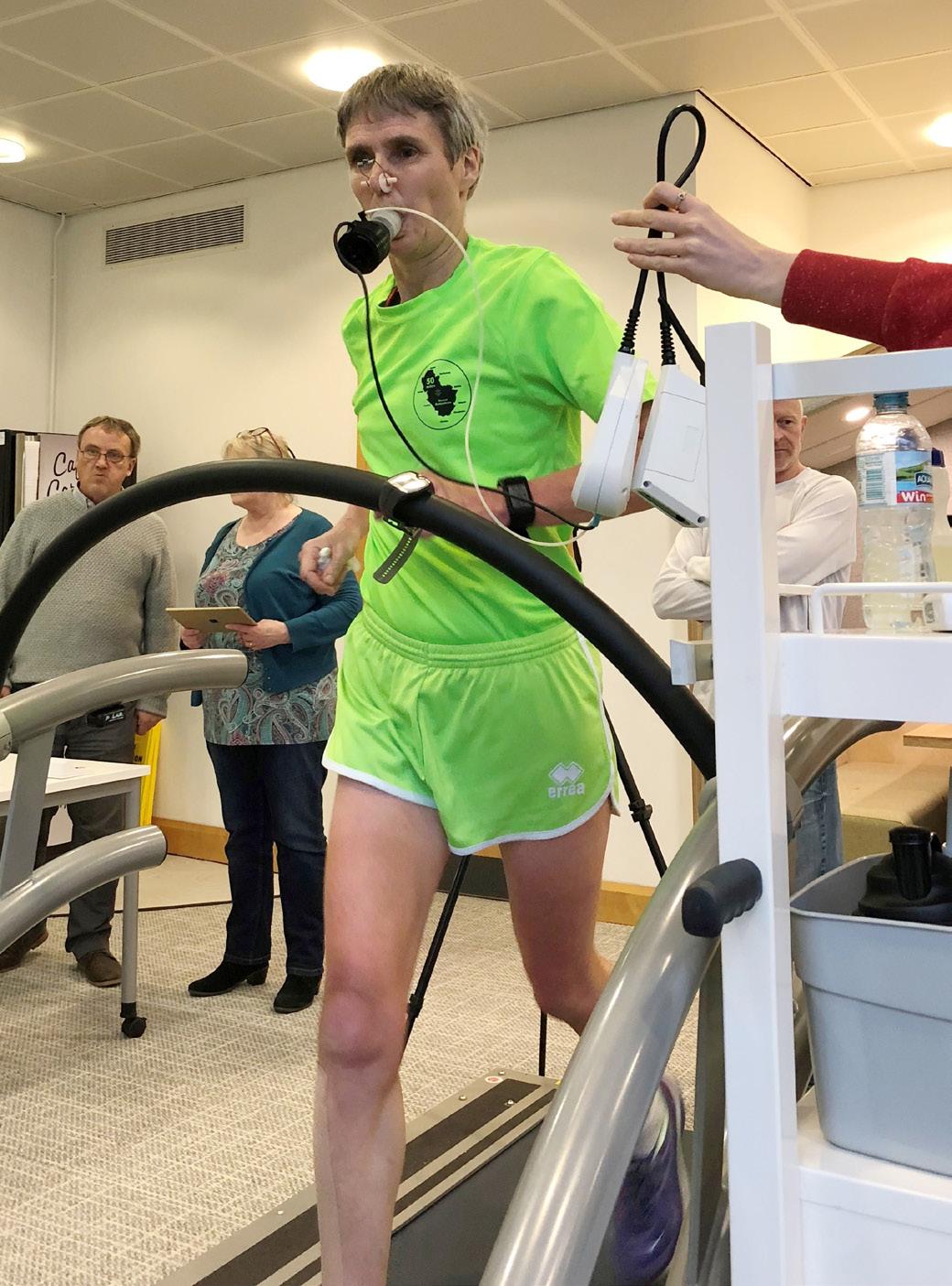
Other runners shouldn’t use Sharon’s example as a template for their own ultra efforts. If they consumed as little on the run, their performance would drop off after several hours. You can’t overlook the mental aspect. Sharon has an amazing ability to distract herself without any outside stimuli like music or video.
Gayter began each day with an early-morning breakfast, and then a soup-and-bread snack an hour before running. After each marathon, she consumed a “shake” that included protein, colostrum powder, and a banana. Evenings she ate protein and a medley of vegetables, followed by apple crumble. Before bed, she had a protein drink.
Immediately after finishing each marathon, Gayter turned to her replacement drink. “That drink was probably my most important recovery strategy,” she said. A daily massage ranked second, though she acknowledged it was mostly “psychological.”
Overall, Gayter burned an average of 3,305 calories a day, including 2,030 per marathon. She was only able to consume 2,036 calories/day. This meant that she lost weight (five pounds seven ounces/2.5 kilograms), body fat (four pounds/1.8 kilograms) and muscle (six and a half ounces/0.18 kilograms) over the 10 days.
During her almost 44 hours of treadmill running, she sought no outside stimuli like TV, music, or books-on-tape. “I am mentally strong, and I can focus on the job at hand,” she says. “Music and people talking to me are a distraction. My mind works in numbers. I focussed mainly on my pace and milestones like every kilometre or 10 kilometres.”
Gayter’s focus paid off setting a new female Guinness World Record for running 10 marathons in the fastest aggregate time.
When it comes to ultrarunning Sharon Gayter has an unrivalled record. The U.K. runner completed her first 100-kilometre race in 1994, winning it comfortably and subsequently representing Great Britain over 25 times and winning many national championship titles. She has competed in over 185 ultra marathons and 114 marathons, including iconic races such as Badwater Ultramarathon, Marathon des Sables, Trans-Alpine from Germany to Austria, Switzerland and Italy, Fire and Ice 250 km, Al-Andalus Ultra Trail and the Grand to Grand Ultra. She has held many world records and at 58 shows no sign of slowing down. Already this year she has completed five ultras and plans to return to the Grand Canyon in September and run the six-stage Grand to Grand again. “This is one of my favourite races and I rarely go back to repeat races, but with a 10-year gap for me I am looking forward to experiencing this again,” she says.
Gayter also has a couple more records to break, she says, one on a treadmill and two overseas. She also wants to do one of the toughest races in the U.K., the Winter Spine, a 268-mile non-stop event with 40,000 feet of climbing. “I entered the first ever edition of this and didn't finish, hence I have unfinished business there.”

I am mentally strong, and I can focus on the job at hand,” she says.
“Music and people talking to me are a distraction. My mind works in numbers. I focussed mainly on my pace and milestones like every kilometre or 10 kilometres.

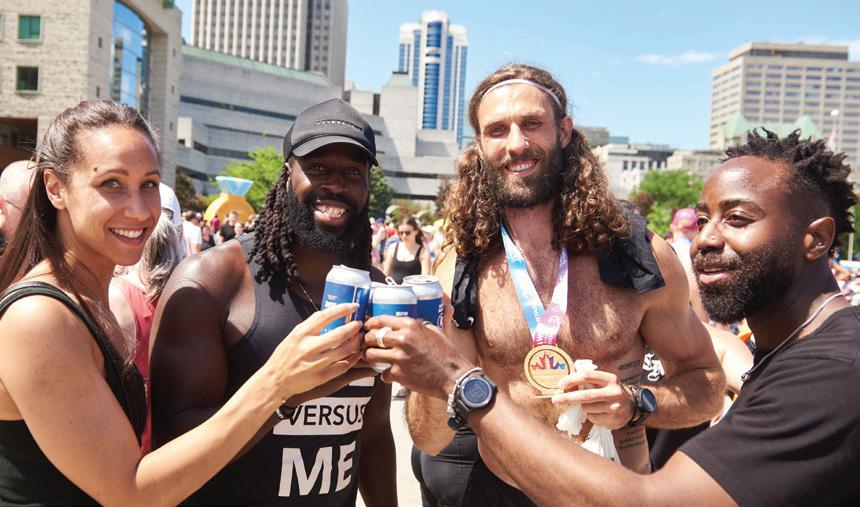
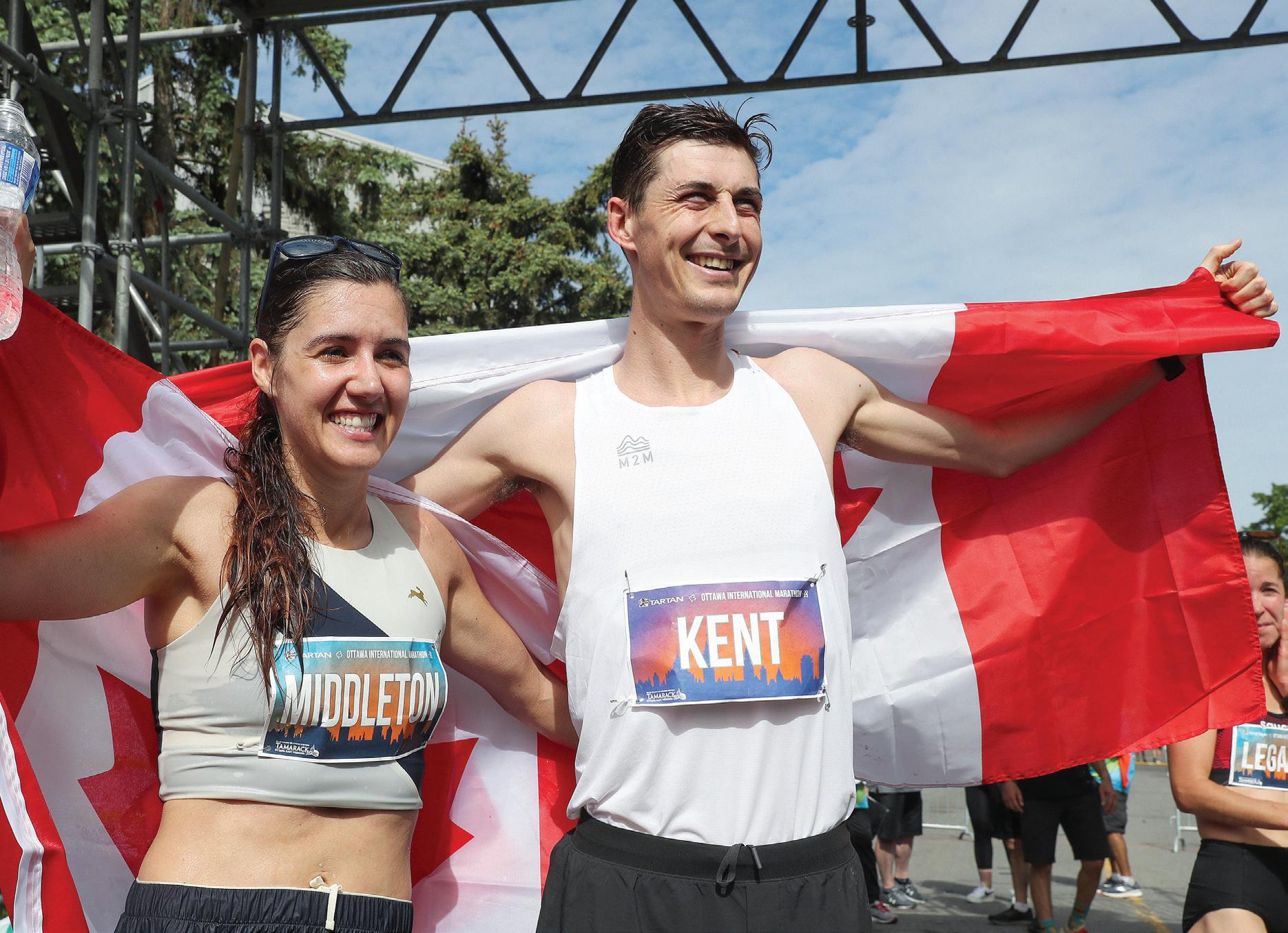



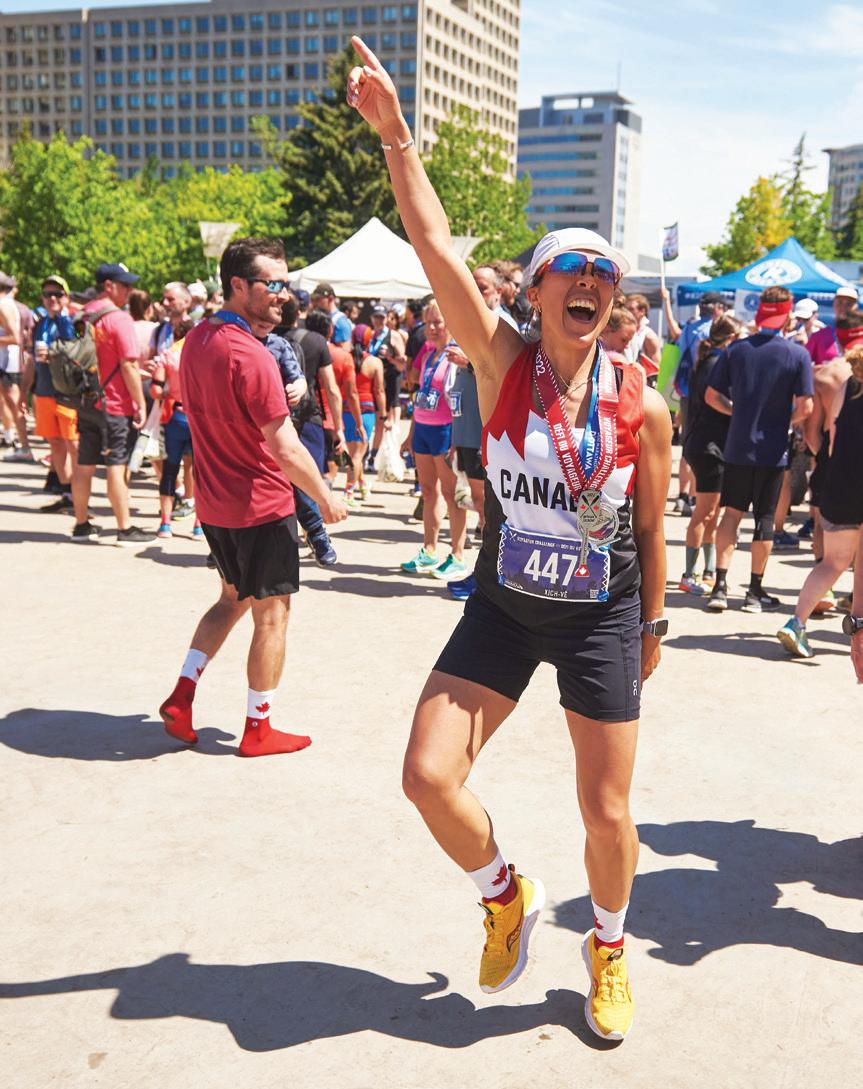



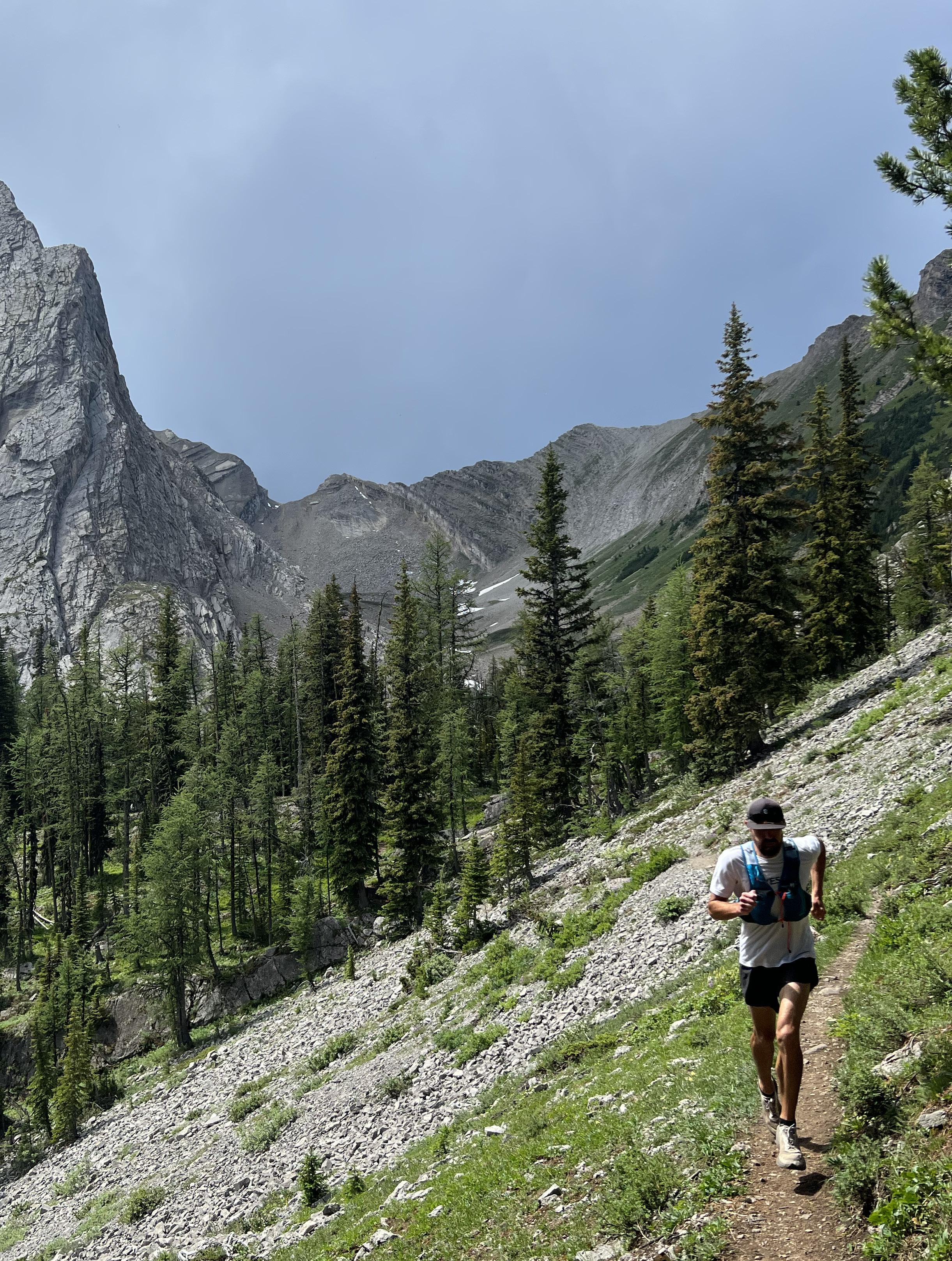 BY JACOB PUZEY JACOB PUZEY; 5 PEAKS ADVENTURES Father and husband who cobbles together a living as an ultrarunner, coach and race director, from Canmore, AB. TEAMPEAKRUN PEAK RUN PERFORMANCE
BY JACOB PUZEY JACOB PUZEY; 5 PEAKS ADVENTURES Father and husband who cobbles together a living as an ultrarunner, coach and race director, from Canmore, AB. TEAMPEAKRUN PEAK RUN PERFORMANCE
The trails are calling, and many runners are heeding the call
On the descent, when you see an obstacle decide whether to go over it or around it.
The sport of trail running is growing. Some folks are transitioning from the roads to the trails while others are taking up trail running as their introduction to running in general. Whether it is a desire to spend more time in nature or simply the need to mix things up, trail running provides a new challenge and plenty of opportunities to learn and grow. As with any new activity, the level of enjoyment one experiences correlates with the amount of confidence and competence one possesses.
On one hand, it’s exciting to try something new and tackle a new challenge. On the other hand, gaining at least some confidence and competence in the new activity certainly makes it a bit less intimidating and more fulfilling and sustainable in the long run.
So how does one increase competence and confidence on the trails?
Learning to trail run is like learning a new language. It’s different, yet familiar. It’s challenging, yet intriguing. It’s intimidating yet rewarding. And just as the best way to learn a new language is to immerse yourself into a new culture, the best way to learn to run on trails is to run on trails.
If you are transitioning from the roads to the trails, I recommend some skill development drills or plyometrics to help
prepare for the specificity of running on trails, but drills alone won’t be enough to feel confident or competent. As you immerse yourself by regularly practicing the skill of running on trails and dedicating some time to practice the unique skills of running up and down hills on uneven terrain, your confidence and competence will increase. Adding strength training to your running routine can also help prepare your body and mind for the demands of trail running.
• Start small (one easy trail run per week) and incrementally increase the time that you spend on the trails by either lengthening the run or adding another run on trails each week.
• Do your easy/recovery runs on trails for a mental and physical break from the pavement. As with reading for pleasure, these low-stakes runs will help you gradually feel more confident without forcing it. Go as slow as you need to go and over time your confidence will simply increase.
• Before adding hill repeats, simply do some of your easy/recovery and long runs on undulating terrain. Start by running these hills—up and down—at the same effort as you would the rest of the run. Over time you can begin increasing the intensity as you ascend and descend the hills.
• Uphill running. Lean into the hills at your heels, keep a short stride length – this allows for better foot placement and your forefoot will propel you forward. If you need to walk or hike that is fine, often at the end of a race a runner’s pace is more efficient hiking rather than running.
• Downhill running. As with the uphill, lean forward with your heels and strike in the forefoot/midfoot. Foot placement is important. When you see an obstacle like a rock decide whether to go over it or around it. Flaying out the arms is normal—nobody said trail running was elegant!
• In any running plan, at least 80 per cent of it should be at a conversational pace at 5-10 RPE (Rate of Perceived Exertion). If trails are easily accessible,
you could eventually work your way up to doing 80 per cent or more of your training on trails. If trails are not accessible, aim to do at least some of your runs on dirt roads or grass, even if it means doing loops around sport fields.

• If you feel the need or desire to add some intensity to your training, start by doing cut-down runs, strides, fartlek, or hill repeats once a week on pavement. Once you feel comfortable and familiar enough with specific trails you can move these higher-intensity efforts to less technical trails or dirt roads. However, remember most trail running events aren’t short enough that you’ll need to be sprinting up or down hills or in the middle of a race on a flat section, so simply training at a conversational effort or a bit harder should suffice for most runners.
Plyometrics / Agility Drills –these are explosive movements that are meant to increase muscle power. Typical exercises include jumping jacks, lunges, box jumps and push-ups.
Easy runs – these aren’t slow slogs but run at an aerobic effort with a focus on feel and form.
Cut-down runs - these are an effective way to prime the legs and lungs for future hard efforts. You start comfortably and increase the effort incrementally throughout the run, therefore ‘cutting’ the pace down.
Strides – after a warm-up increase your pace for 50-100 metres, rest and then repeat.
Fartleks – the Swedish word for speed play. These are intervals done at 5-10 km pace during a run.

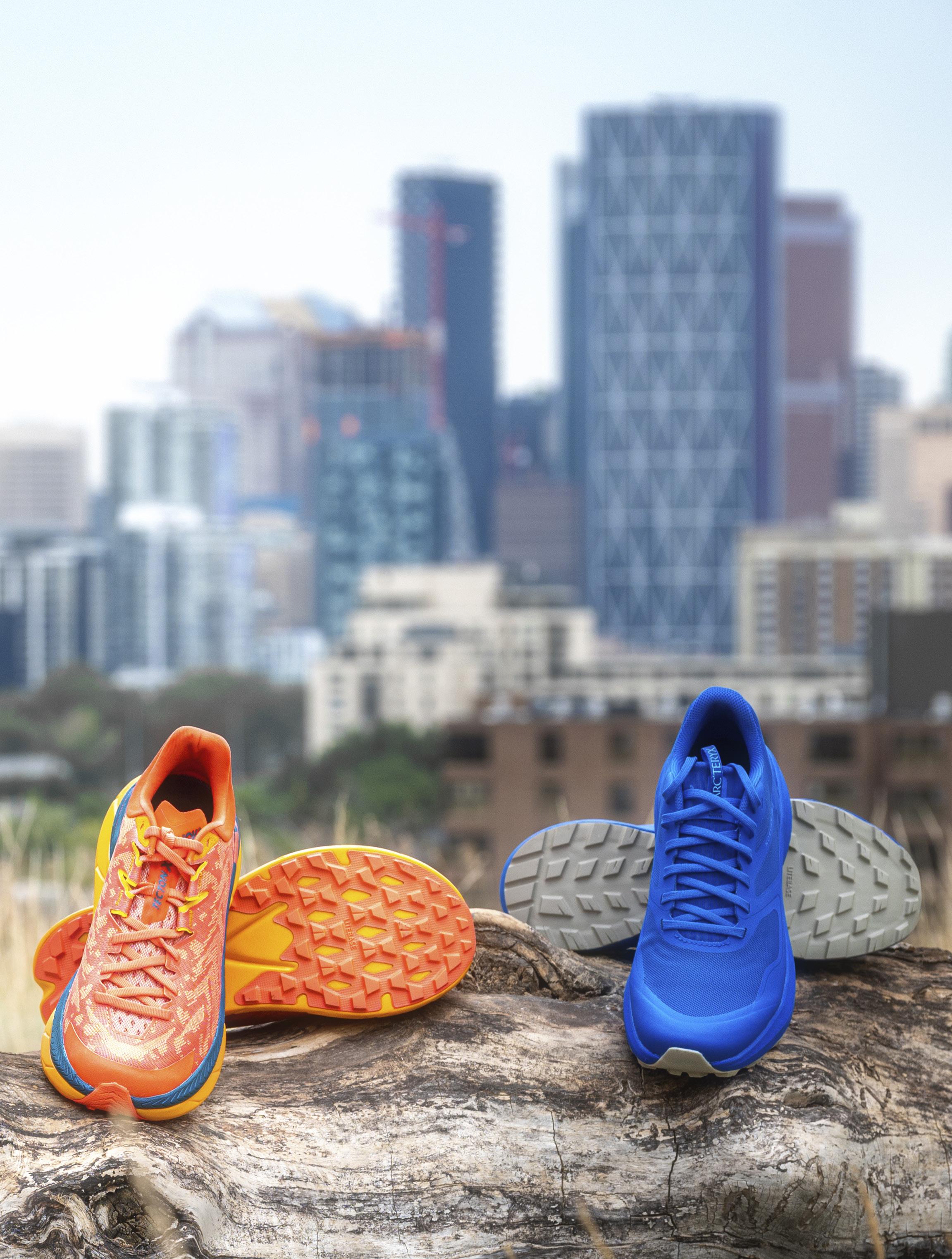
Looking for new trail running shoes? Once again we’ve asked some of the best runners from across Canada who live and breathe running to cover miles of trails for us. Whether you run local trails in the park or rugged mountain terrain, you will be prepared for the most epic trail experience possible with the right shoes.
PHOTOGRAPHY: GRAHAM MCKERRELL MCKERRELLPHOTOGRAPHYConsider the ‘Drop’
This is the difference between the heel and the forefoot measurements, or in other words, how much your toes ‘drop’ below your heel. Why is this important? Because a higher drop can lead to more heel striking and also transfers some strain away from the lower leg and up towards the knee. A lower drop will shift the load further down to your calf. Check with an expert, choose what feels comfortable to you and take into account your running mechanics and history of injuries.
$180 M
TERREX Agravic Flow 2 10.5 oz. | 8 mm Drop www. adidas.ca


The Agravic Flow 2 is a surprising combination of light and sturdy while paying attention to the planet you are bounding over. You can pat yourself on the back for cruising in a shoe made with recycled materials, whose upper features at least 50 per cent recycled content. It handles sharp exposed ridges, fast steep turns, root ripping and forest bounding with equal ease. The mesh upper is supportive and breathable so that you’ll always have a comfortable, cool, dry foot strike. Sturdy enough to put in piles of miles, this is my favourite this season.
PETE ESTABROOKS , Calgary, AB – One of Canada’s foremost fitness experts, ultrarunner and coach, is happiest when running in the mountains.
$180 W
TERREX Agravic Flow 2 10.58 oz. | 8 mm Drop www. adidas.ca
I was skeptical of this shoe at first because it is stiff and hefty with a high, rigid heel collar. However, I tested it while orienteering off-trail, and it felt fantastic on the lumpy, uneven ground. I was confident with each foot landing and felt stable as I ran. The toe box was particularly roomy, and I liked the 8 mm drop. While I won’t lace these up for any racing, they will be my go-to training and orienteering shoe. Perfect for those who worry about twisting an ankle on rough terrain.
NICKI REHN , Calgary, AB – ultramarathon runner, orienteer and adventurer who loves to travel the world doing crazy races, disappear deep into the mountains, and rip up the local single-track.
$180 M Outroad
10.68 oz. | 0 mm Drop www. altrarunning.com
These new shoes from Altra offer an excellent choice for mellow terrain: something of a balance between trail and road running. The Outroad offer maximal comfort on easy terrain. They were superb underfoot running on gentle trails in the woods of central Alberta. The shoes have generous padding, flexibility and wide midsole alongside Altra’s typical wide toe box. As is Altra’s approach, the Outroad have a 0 mm drop. I thoroughly enjoyed training in the Outroad.
IAN MACNAIRN , Calgary, AB – Trail runner, guy with a PhD in ultrarunning community.
$180 W Outroad 8.8 oz. | 0 mm Drop www. altrarunning.com

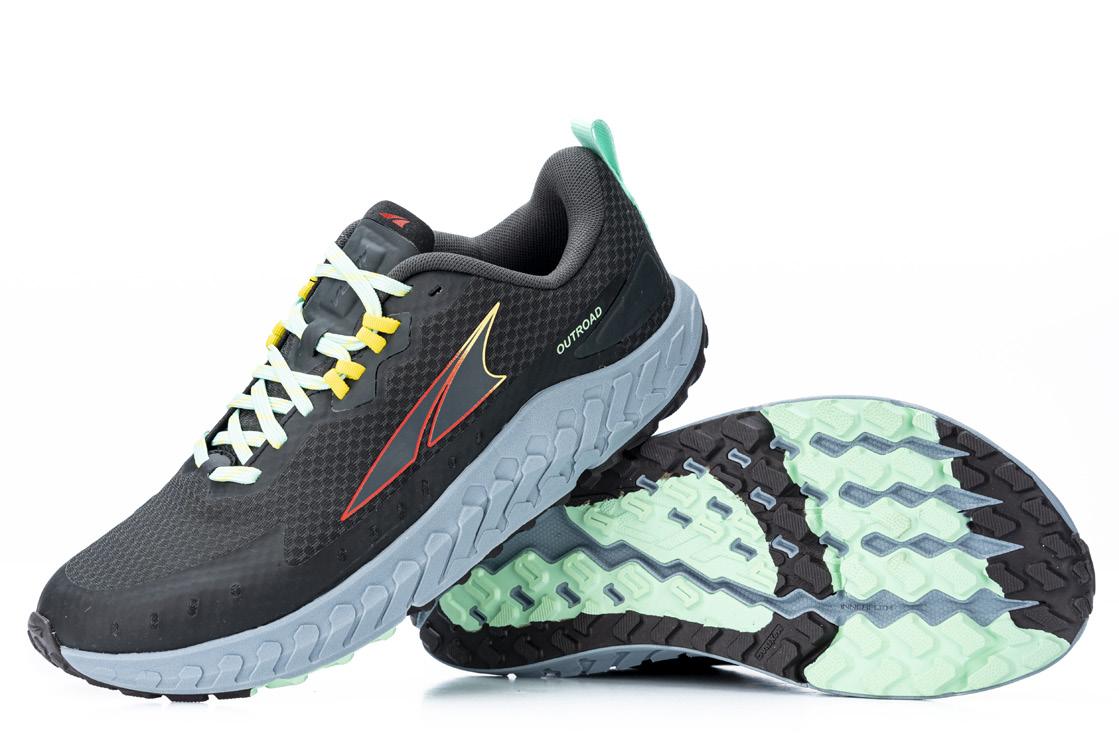
These shoes are very comfortable to run in on both road and trail. The toe box is slightly smaller than other Altra models and the heel is secure. Unfortunately, the soft foam that makes for a comfortable ride does not provide adequate protection on rocky trails. I bruised my heel on more than one occasion. The lugs also do not grip well on claybased mud, but the grip is much better on loamy soil. I’d recommend these shoes for non-technical dirt trails.
JOANNA FORD , Calgary, AB – Ultramarathon runner with a passion for running long distances in the mountains.
$185 M
Men’s Norvan LD 3 10 oz. | 6 mm Drop www.arcteryx.com
This long-distance trail shoe is perfect for serious adventures. The Vibram MEGAGRIP works well on all trails and tarmac. They are lightweight and feel great on foot but tend to be a little stiff. The wide toe box serves those longer runs with amazing engineering for durability, but I would likely choose a half size larger. They are stable, have great grip and look great. The lacing system and tongue provided a secure and comfortable fit with no issues on super steep slopes. This is a serious mountain shoe for running and speed hiking.
CAL ZARYSKI , Calgary, AB – Professional active lifestyle coach, 9x World XTERRA Triathlon Champion, 3x Triathlon Canada Coach of the Year, 3x Alberta Triathlon Coach of the Year.
$185 W
Women’s Norvan LD 3 9 oz. | 6 mm Drop www.arcteryx.com
Designed for long distances, Arc'teryx made this shoe comfortable and durable. I loved how breathable and streamlined the CORDURA upper felt. The Norvan LD 3 felt light and plush on descents and ascents. The durable outsole was aggressive with 4 mm Vibram MEGAGRIP lugs and a good bite on rocky and technical terrain. The Norvan LD 3 felt responsive on technical trails and short stints on the road. An excellent trail shoe for technical and urban trails.
EMILY SETLACK , Trenton, ON - Canadian marathoner and mountain runner.
$150 M
FUJI LITE TM 2 9 oz. | 4 mm Drop www. asics.com
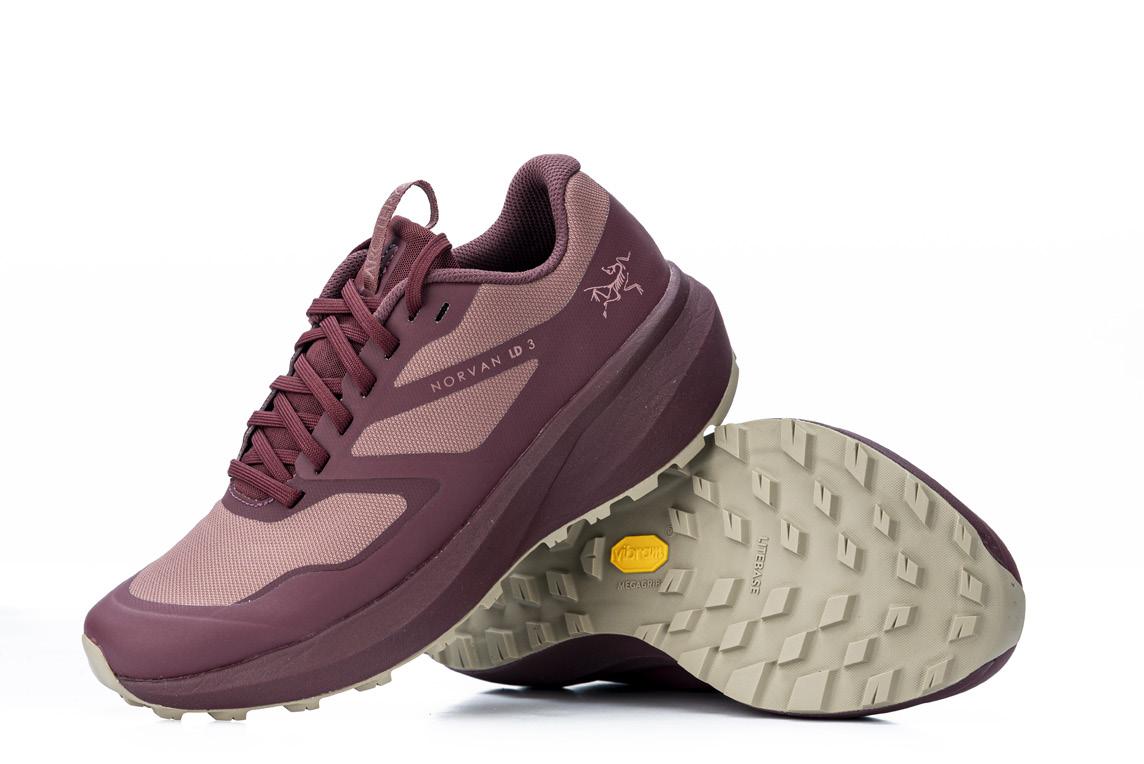
The Fuji Lite has a new FlyteFoamTM midsole made with recycled materials, providing lightweight shock absorption that propels you forward through the trails. It has exceptional grip with the ASICSGRIPTM outsole and a unique tread pattern. The upper is equipped with a lace garage to keep your laces tucked in. This is a versatile, lightweight shoe designed for a variety of trail surfaces and would be an excellent choice for shorter trail races.
BLAINE PENNY, Calgary, AB - Competitive masters runner with notable accomplishments consisting of a marathon PB 2:28, 3x Canadian Ultramarathon Champion, 6x Guinness World Record holder and winner of the 2015 Wings for Life run (North American).
$150 W
FUJISPEED 7.3 oz. | 4 mm Drop www. asics.com


Right out of the box this is a stunning, lightweight trail runner. It is built for faster trail runs, with ample cushioning and a focus on the materials and grip remaining light but durable. The laces are comfortable, stay done up, and have a fantastic lace garage on the tongue. I would recommend going up a half size as they run a bit small and are on the narrow side.
 RACHAEL MCINTOSH , Calgary, AB – Retired Team Canada Track and Field athlete turned recreational road and trail runner.
RACHAEL MCINTOSH , Calgary, AB – Retired Team Canada Track and Field athlete turned recreational road and trail runner.
$190 M
$160 W
Caldera 6
11.3 oz. | 6 mm Drop www. brooksrunning.com

The Brooks Caldera 6 is the latest iteration of the Brooks vision for trail maximalism! This shoe did not disappoint. It looks huge out of the box, but on my feet on a smooth groomed trail, it did not feel at all clumsy, and the ride was springy, with a much nimbler feel than I was expecting. The midsole foam is a winner if you are looking for all-day trail comfort. Despite a less aggressive outsole, I didn’t have any issues with grip. The nice wide toe box will keep your toes comfy. Overall, highly recommended.
ANDY REED , Canmore, AB – Sport medicine physician, mountain ultra-trail runner, numerous podium finishes in mountain ultras through North America.
Cascadia 16 9.5 oz. | 8 mm Drop www. brooksrunning.com

Put your feet in the Brooks Cascadia 16 for a soft, cushioned and stable run! The shoe has a comfortable fit with room in the toe box and a snug fit around your heel; there’s no need to worry about heel slippage. The lightweight feature of the new DNA LOFT v2 midsole makes hitting the trails light and bouncy. The grooves on the midsole provide enough traction to feel confident on any terrain with roots, hills, gravel or dirt. This is the ideal shoe for comfort, durability and traction!
REBECCA BASSETT, Coquitlam, B.C. – Canadian distance runner specializing in the 5000 m, All-American in cross-country, who loves to hit a hilly and tactical trail for long runs with her teammates.
$210 M Men’s Escape™ Thrive Endure™
15 oz. | 8 mm Drop www. columbiasportswear.ca
The Columbia Escape Thrive Endure is a hiking boot for foul weather. I typically opt for a running shoe, but this boot felt comfortable when I first put it on. For those who prefer to hike in boots but prefer a more athletic look, this hybrid option has a sportier look and offers a comfortable, stable ride. It felt quite grippy on loose dirt and rock and the membrane should keep your foot dry while splashing through puddles. It would be a good hiking boot to cover more distance and is more than a standard trail running shoe.
ADAM CAMPBELL , Squamish, B.C. – Lawyer, endurance athlete, happy in the mountains on foot, bike, rocks and skis.
$210 W
Women’s Escape™ Thrive Endure™ 15 oz. | 8 mm Drop www. columbiasportswear.ca
This is an ultra-cushioned trail shoe with great traction and a comfortable waterproof upper. I was impressed with the overall mobility and ‘running shoe’ feel considering the ankle-hugging height of the shoe, and while I would not choose it for a trail race, it’s a great shoe for someone who wants cushioning and something lightweight to play around all day in trails or any sort of rough terrain.

LUCY SMITH , Victoria, B.C. – Elite athlete in distance running, duathlon and triathlon for more than 30 years, coach and motivational speaker.
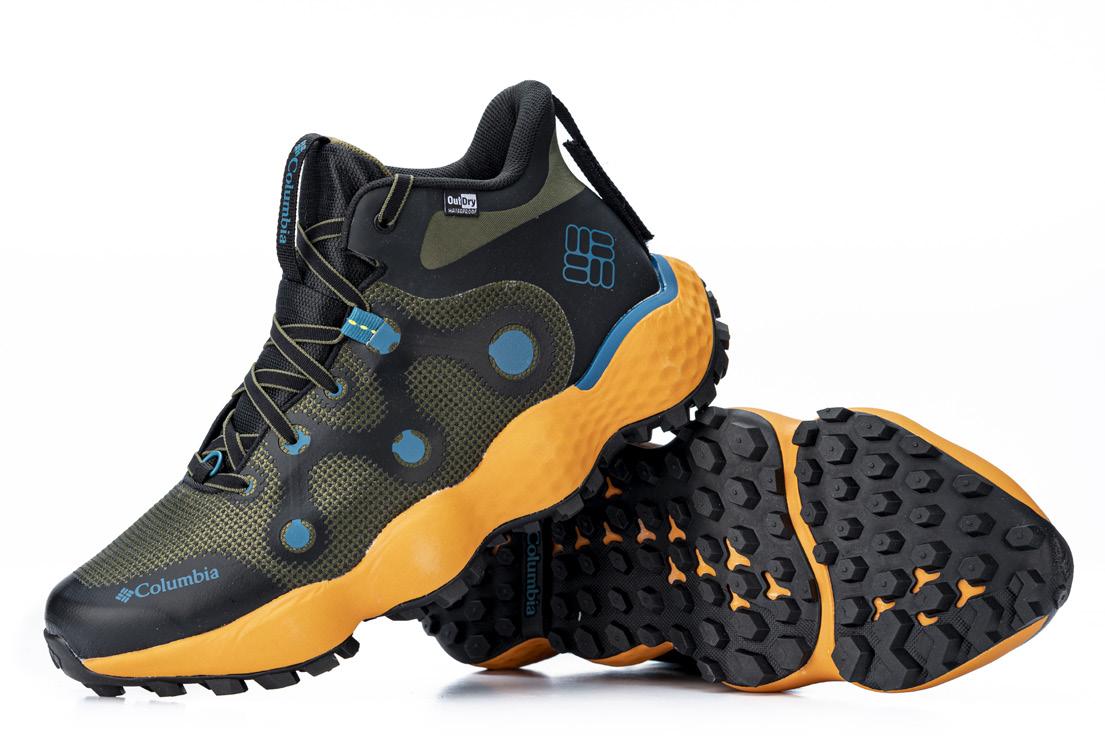
$240 M
Men’s TECTON X 8.5 oz. | 5 mm Drop www.hoka.com
HOKA’S Slogan, “Time to Fly” describes this trail shoe accurately. These modern carbon-plated endurance trail shoes have all the best features for any trail runner. The shoes are stable and lightweight with great cushioning. The fit is true to size. The soles are great for a hardpacked trail. The lacing system and super lightweight tongue creates a comfortable and secure fit. I had no issues with heel slip or hot spots after several longer trail runs. This shoe is ideal for a wide forefoot and both road and a variety of trails. It’s the perfect all-rounder shoe!
CAL ZARYSKI , Calgary, AB – Professional active lifestyle coach, 9x World XTERRA Triathlon Champion, 3x Triathlon Canada Coach of the Year, 3x Alberta Triathlon Coach of the Year.
$240 W
Women’s TECTON X 6.9 oz. | 5 mm Drop www.hoka.com
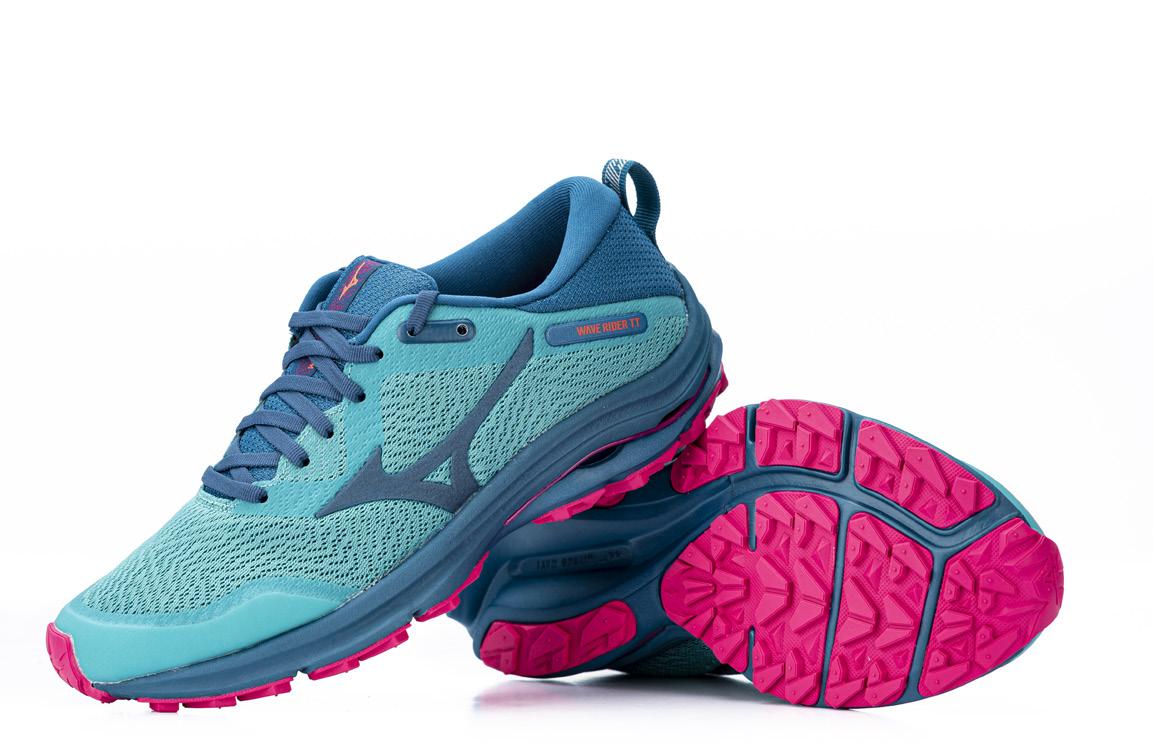


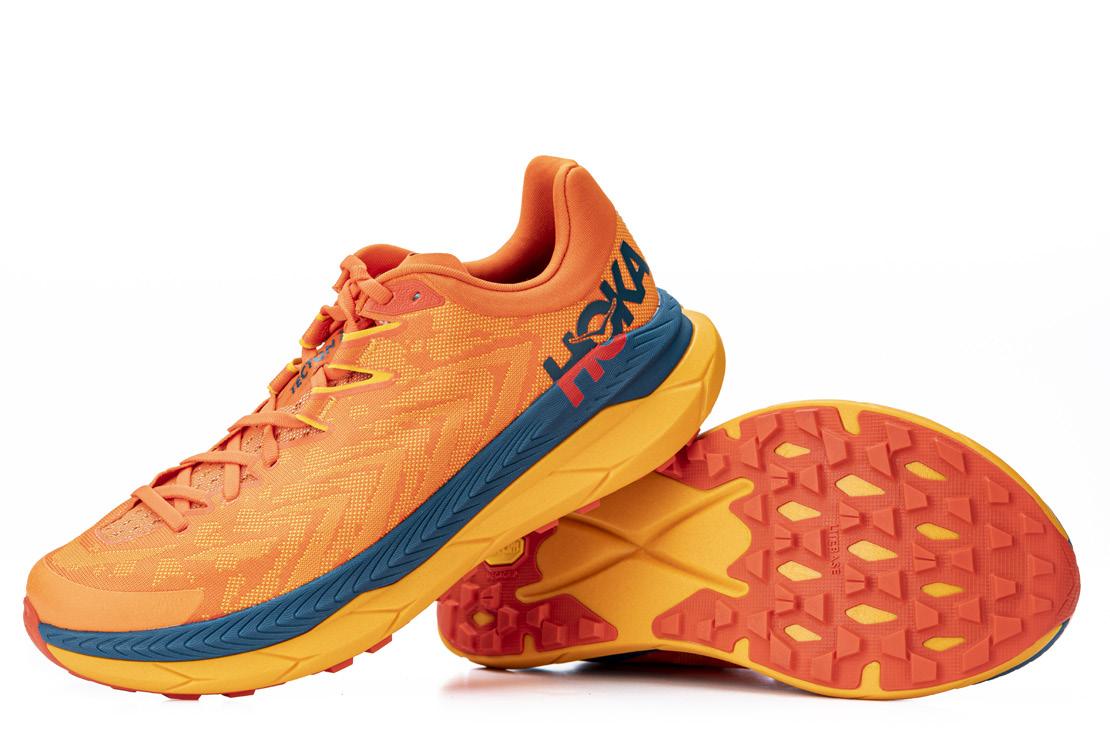
These might be my new favourite trail shoes! They’re nice and light, but the treads take me everywhere I want to go. I’ve used them on all of the Invermere trails and the rockier Canmore ones. Lots of room in the toe box, they keep my heels nice and snug, and they keep all the fine dust out. I was surprised at how supportive they were without being too heavy or clunky or restrictive.
AMY PUZEY, Invermere, B.C. – 2x Team Canada member at the World Mountain Running championships, mother of six.
$175 M
$175 W
Wave Rider TT
10.1 oz. | 12 mm Drop www. mizunousa.com
The Mizuno Wave Rider TT is a great shoe for anyone who is looking for a lightweight, well-cushioned shoe. The shoe handled well on groomed trails and cross-country terrain and gave a lot of comfort over those conditions. I will be looking at using these shoes for light trail runs up to 21-kilometre routes. I would recommend sticking to less technical trails as I did not find them supportive and stiff enough for mountain trails or overly rocky and rooted trails. Overall, a great shoe for a mix of light to moderate trails and roads.
PHIL HIOM , Kamloops, B.C. – Runner who spends most of his time training on the trails around Kamloops, training for 100 km Lost Soles Ultra in Lethbridge, AB, hoping to qualify for the Western States Endurance Run Lottery.
Wave Rider TT 8.3 oz. | 12 mm Drop www.mizunousa.com
The Wave Rider TT (Total Terrain) is meant for varied surface running. Like most Mizuno shoes, they fit slightly smaller than true to size. The toe box is more narrow than other brands, which will appeal to some runners. This shoe performed well on mixed terrain including crushed gravel and some more technical terrain. The shoe itself is a great weight for all types of terrain. This versatile shoe has a responsive ride and a breathable upper, but I definitely recommended it for a narrower fit foot.
CATRIN JONES , Victoria, B.C. – 50-km, 50-mile and 6-hour Canadian record holder.
$179.99 M
Fresh Foam X 880v12
10.5 oz. | 10 mm Drop www. newbalance.ca
The New Balance 880 v12 was the perfect fit! The knitted upper was extremely comfortable for my wider foot. My heel felt locked in right away and the tongue and laces disperse the pressure across the top of the foot evenly. The sole is a two-part foam consisting of Fresh Foam X for softness and FuelCell for responsiveness; this combination is the perfect match. The thick rubber on the outsole provides great protection on gravel trails and asphalt. If you are a wider-foot runner who is looking for your next everyday trainer, this is it.
LOGAN ROOTS , Courtenay, B.C. - Road, trail, and mountain running enthusiast who enjoys crushing big mileage, ego-altering workouts and running just fast enough to qualify for elite entry.
Fresh Foam X 880v12 8.4 oz. | 10 mm Drop www. newbalance.ca


From the first step out the door, the 880 felt fast and springy. It felt like I had been training in it for years. The Fresh Foam midsole was a pleasure to run on, feeling plush but responsive. The slightly higher volume fit would accommodate an orthotic nicely but held onto my foot with the stock insole as well. If you are looking for a neutral, everyday training shoe with cushion and comfort, the New Balance 880 might just be your new favourite.
JEN MILLAR , Victoria B.C. – Winner of Times Colonist 10K 2022, National Masters X-Country Champion 2021, mom of two.
$180 M
$180 W
Air Zoom Terra Kiger 8
9.9 oz. | 6 mm Drop www. nike.com
Disappointing to see this shoe gaining weight with each iteration. As Nike’s trail racer, the Kiger feels overbuilt and unable to react to quick changes in terrain. The midsole provides plenty of protection but lacks ground feel. On the plus side, the new upper breathes well and locks the foot in nicely.
Air Zoom Terra Kiger 8 9.1 oz. | 6 mm Drop www. nike.com
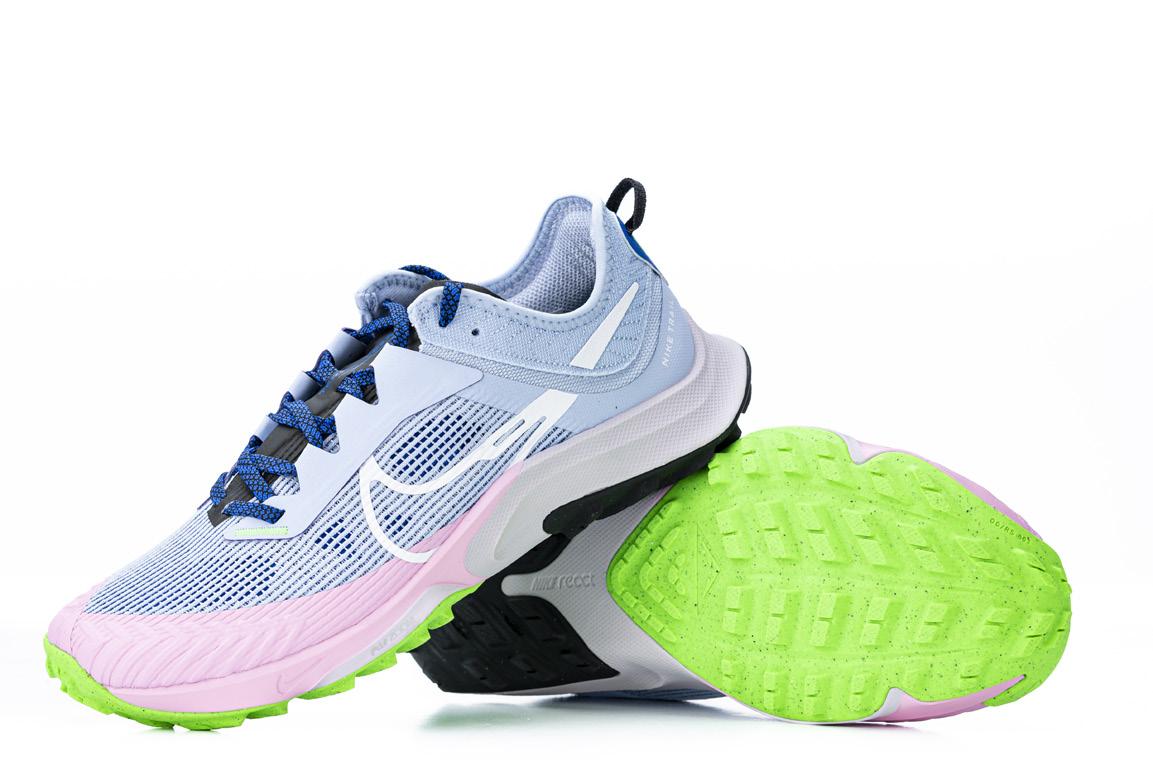
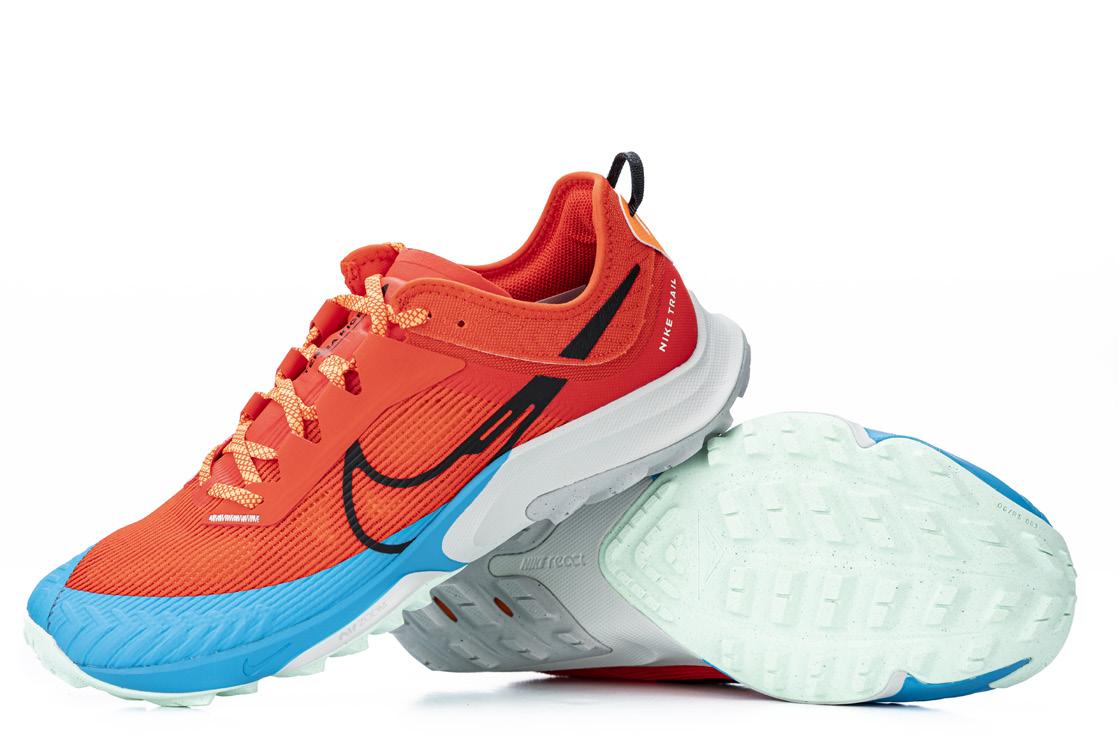
A light and nimble shoe for urban and rugged trails with multidirectional traction lugs and a dynamic fit system through midfoot. I felt confident running on rocky and uneven descents and ascents. The midfoot React foam provided ample cushion, and I loved how light and breathable the upper was. The shoe really moved with me and provided exceptionally good sensitivity while running on rocky and rough terrain while providing a good amount of cushion. The Kiger comes into its own on urban and rough trails.
ANDREW RUSSELL , Saanichton, B.C. – 2019 Vancouver Island Race Series champion, 2019 Finlayson Arm 28K champion and course record holder.
EMILY SETLACK , Trenton, ON – Canadian marathoner and mountain runner.
ON $209.99 M
Cloudultra 8.99 oz. | 11 mm Drop www.on-running.com
The Cloudultra is a nicely cushioned all-around performer in the trails. The 8mm drop, stable ride and grippy outsole give me confidence in this shoe for long run or ultra race duty. Things felt a little stiff out of the box but loosened up nicely after a couple runs. The unique FlipRelease systems allows subtle width adjustment in the toe-box which could prove useful as feet swell over long distances.
MATTHEW CECIL , Victoria, B.C. – Trail runner and running coach, represented Canada at the Trail World Championships and holds various trail FKTs.
ON $209.99 W
$259.99 M
9 oz. | 6 mm Drop www. saucony.com
Endorphin Edge
The long wait for a trail super-shoe may be over. The Endorphin Edge succeeds where other carbon-plated trail racers have failed because it’s as stable as it is snappy. The soft, squishy midsole offers plenty of comfort and protection, but it’s also nimble on rocks or roots and smooth on corners. When you pick up the pace on downhills, it just flies. The Carbitex carbon plate propels you forward like you’ve got a rocket strapped to each heel. It’s like having a Ferrari under your feet with the traction of a four-wheel drive.
KEITH BRADFORD , Calgary, AB - Elite masters runner with a passion for road racing, run coach and crisis communications consultant who has worked with athletes at multiple world cups, world championships and Olympic Games.
Cloudultra
8.64 oz. | 8 mm Drop www.on-running.com
When you want an ultra-cushioned, ultra-comfortable, ultra-versatile trail running shoe, the On Cloudultra is unbeatable. The biggest highlights of this shoe for me were its traction, grip, long-term comfort on ultramarathon trail race days, durability, breathability, and a unique feature called FlipRelease found in the lower lacing, where flipping the plastic switch provides an option for variable lacing width and pressure release at the forefoot. For a sock-like fit no matter a short or long number of kilometres, this is your light and reliable shoe!

MANDY GILL , Vancouver, B.C. – Ultramarathon runner (road & trail), keynote speaker, IMPACT Top Vegan Athlete.
$259.99 W
Endorphin Edge 7.8 oz. | 6 mm Drop www. saucony.com
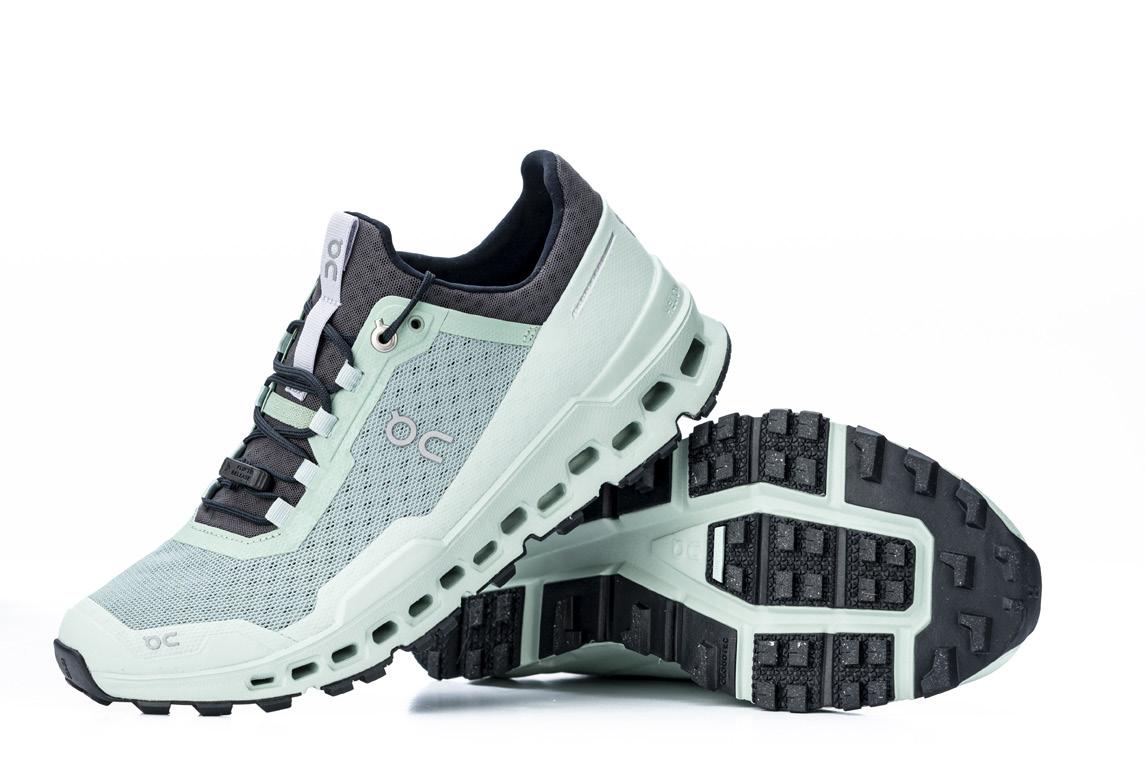
If you have a trail race coming up or like to rip it on the trails, the Saucony Endorphin Edge is your shoe. It’s light, fast and race-ready! Tackle the hills with pop thanks to the carbon fibre plate. The lugs (grip) on the bottom of the shoe are great for the trails but a bit much if you plan on any road running. The upper will keep your feet dry in moderately wet weather and provide a snug fit for average to wider width feet. Overall, I was thoroughly impressed with the shoe and can’t wait to hit the trails!

SABRINA WILKIE , Surrey B.C. – Physiotherapist, mother of three, 2:45 marathoner and winner of the 2016 Victoria Marathon.
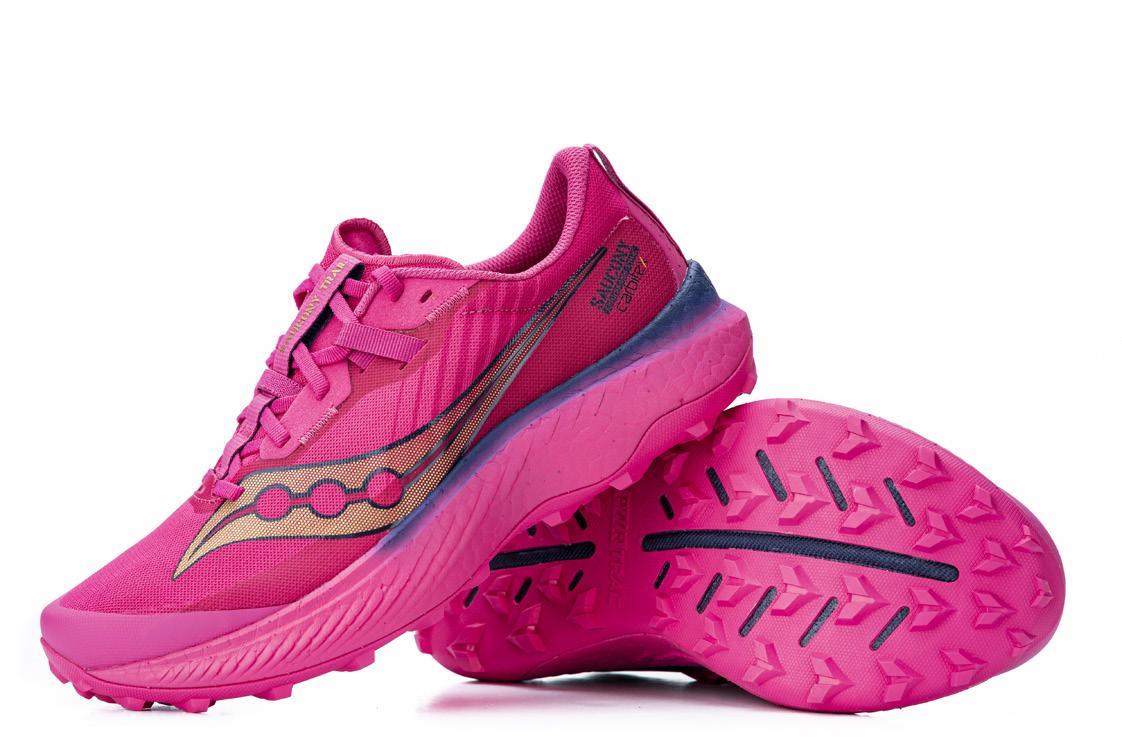
$220 M
Mtn Racer 2 10 oz. | 5 mm Drop www. topoathleticcanada.ca
These shoes crush everything from technical mountain runs to blasting through the trails. They hug the heel and midfoot and leave the toes room to breathe without sacrificing any feeling of speed. The Topo Mtn Racer 2 is stable and grips everything from wet rock to sloppy mud. They are compatible with gaiters and expel water quickly after a river crossing. These are my new favourite trail shoes!
LOGAN ROOTS , Courtenay, B.C. – Road, trail, and mountain running enthusiast who enjoys crushing big mileage, ego-altering workouts and running just fast enough to qualify for elite entry.
$210 W
ULTRAVENTURE 2 8.3 oz. | 5 mm Drop www. topoathleticcanada.ca
A brand that I didn’t recognize, but one that I will remember. The Topo Ultraventure 2 is the most comfortable trail runner that I have ever worn because of its wide toe box and generous cushioning. This shoe offers a perfect balance of stability and plushness without adding too much bulk or weight. Plus, the lugs provide excellent grip on varied terrain. This shoe even comes with added gator holds! The Ultraventure 2 inspires me to hit the trails and explore!
LISSA ZIMMER , Vancouver, B.C. – An elite marathoner with a 2:42 PB set in 2016 and trail runner with goal of racing a 50-kilometre one day.
VIVOBAREFOOT
$288 M
Primus Trail II FG 10.3 oz. | 0 mm Drop www.vivobarefoot.com

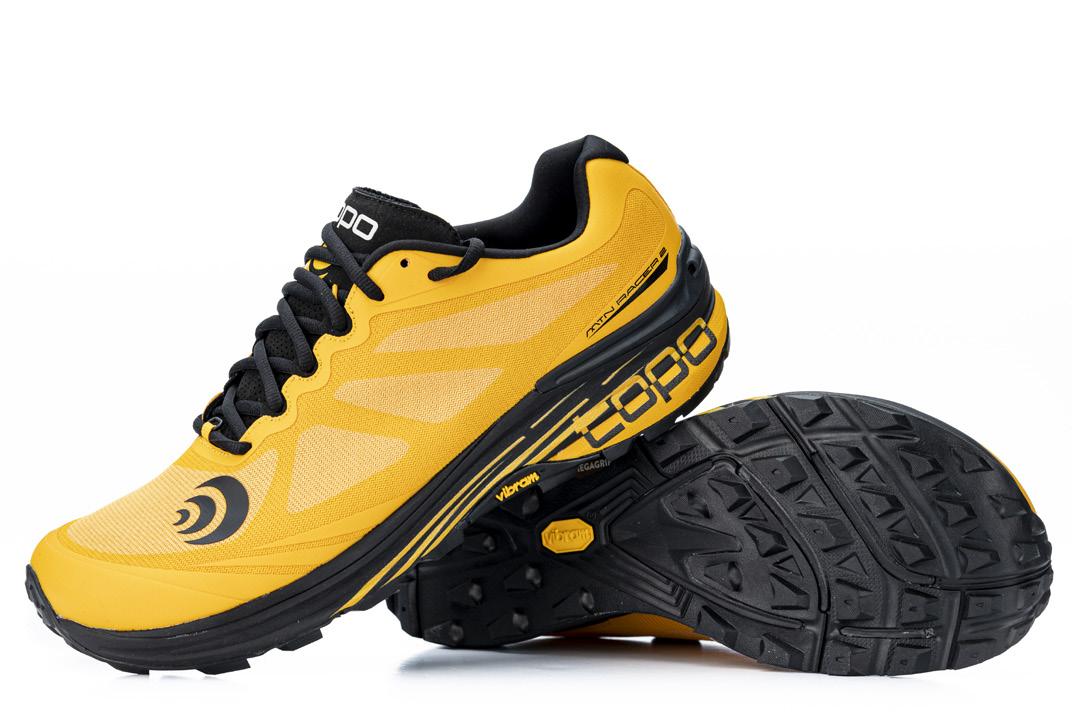
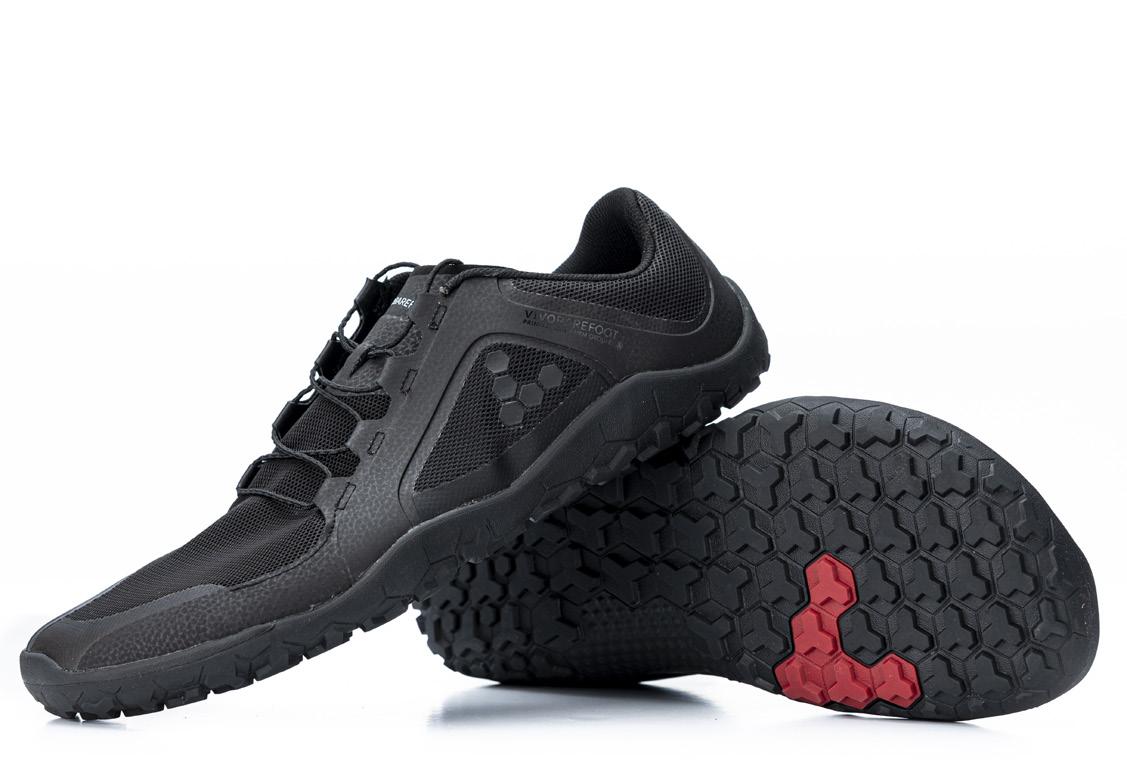
The greatest attribute of this barefoot trail shoe is its ethical origins. The outer shoe, including a firm ground outsole, is made entirely of recycled plastic waste and is vegan. The shoe is zero-drop and has oversized, 4 mm lugs, which offered good traction on trails both dry and muddy. I found great freedom of movement throughout my whole foot, in part due to the wide toe box and supple upper and outsole.
IAN MACNAIRN , Calgary, AB – Trail runner, guy with a PhD in ultrarunning community.
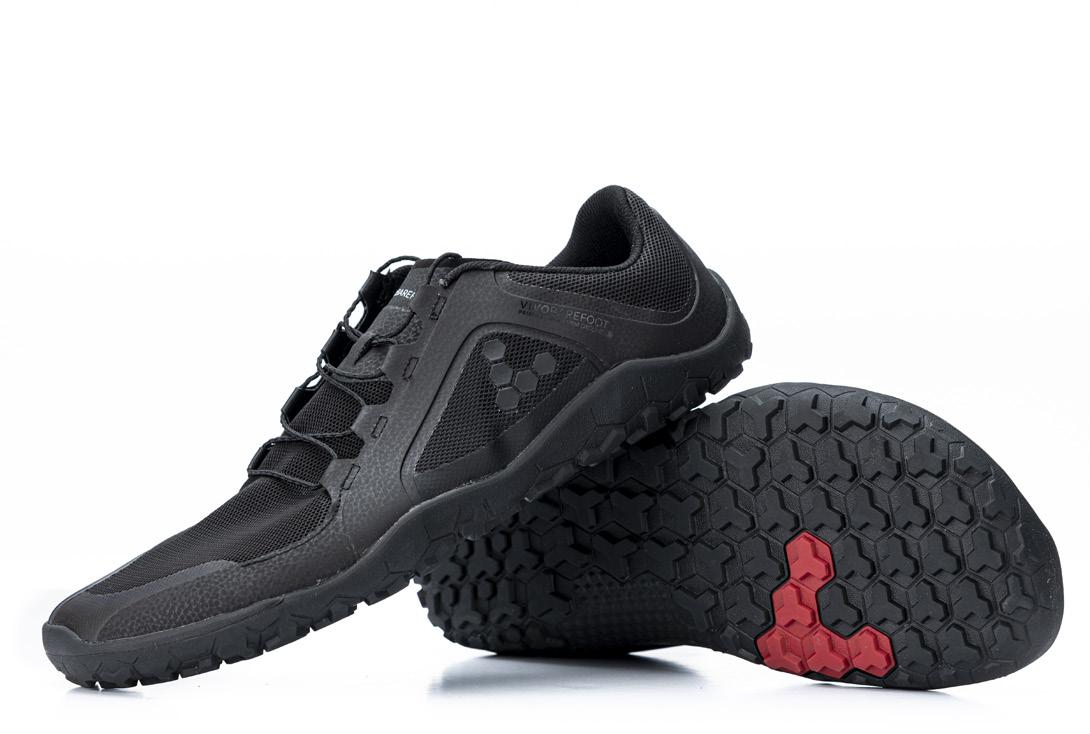
$288 W
Primus Trail II FG 8.8 oz. | 0 mm Drop www.vivobarefoot.com
These are my go-to shoes for trail running. Throughout every season in Squamish, I use them for my short or long runs in the forest. The trails here are classic “mixed terrain,” with packed dirt, slippery tree roots, rock gardens, scrambles and lots of mud. Having a shoe to eat up all that usually means a compromise, but the flexible sensation of barefoot combined with extra grip makes the Primus the ideal tool for the job. Best all-rounder trail shoe in my arsenal.
JENNY TOUGH , Scotland – Adventure athlete currently involved in a project to run solo and unsupported across a mountain range on every continent. The first woman to win the Silk Road Mountain Race and Atlas Mountain Race.
XTRM 2 9.4 oz. | 4 mm Drop www. spryactive.ca
What struck me right out of the box was the aggressive tread. I was keen to try these shoes on a steep, single track and headed out to put these puppies through their paces. I liked the heel support: snug with no rub spots. Up and down the trail there was no slippage inside the shoe, and I was grateful for the wider toe box. These shoes claim that they have the “best grip on the planet”. I can say that I can’t wait to get out again and tackle some new gnarly single tracks.
MARTIN PARNELL , Cochrane, AB – Endurance runner, fundraiser, adventurer and author, six Guinness World Records in endurance events, summited Mount Kilimanjaro in 21 hours.
$230 W
XTRM 2 9.4 oz. | 4 mm Drop www. spryactive.ca
Living on the west coast, the trails are often wet and slick, and this lightweight shoe did not disappoint as it offered excellent traction over slippery trail surfaces. The slipperier, the better for this shoe; it wants to get wet and dirty! The “fitflock” feature secured the midfoot in place while running over uneven ground and gave a snug feel around the instep while offering more room in the toe box. It lives up to its reputation as a shoe that grips, but there is less cushioning and protection against gnarly terrain.
JEN MILLAR , Victoria B.C. – Winner of Times Colonist 10K 2022, National Masters X-Country Champion 2021, mom of two.
XERO $169.99 M
Mesa Trail 15.2 oz. | 0 mm Drop
This ideal minimalist trail shoe is light, lean, and flexible. Be protected yet connected with zero drop, no unnecessary arch support (and a perfect platform if you feel the need to add some), and a wide forefoot area. Delivering a great trail feel, it encourages natural forward motion across all terrain. The mesh upper is durable, breathable and fast-drying. Socks are optional. Remove the insoles to create space and allow more feedback. Run light, smooth, and easy. Great for building a stronger foundation, or for experienced minimalist runners to cover any distance.




RANDY KREILL , Beavercreek, OH – Wellness and truth seeker with 23 official 100-mile ultramarathons complete and roughly 80 total ultramarathons. Celebrating 60 soon with a goal to keep running ultras “injury free.”
$169.99 W
Mesa Trail 12.8 oz. | 0 mm Drop www. xeroshoes.com
The Xero Mesa Trail is a great barefoot style trail shoe. The sole is super low to the ground and extremely flexible the whole way through with a decent tread. The shoe has a wide toe box and hugs the midfoot very well. The mesh outer makes the shoe super breathable and ideal for warm weather running. The shoe fits small, so I would definitely get a half size up next time. This is a great shoe for someone looking for a comfortable lightweight trail shoe for shorter, faster runs in decent weather conditions.
MELISSA ROSS , Nanaimo, B.C. – Competitor at the Canadian 10K Championships, Canadian Cross-Country Championships and World Mountain Running Championships, enjoying running all over Nanaimo with her one-year-old son in the stroller.
Stress fractures occur in high-intensity activities, but what actually causes them and how can they be treated successfully?
BY REED FERBER PH.D., CAT(C), ATCA professor in the Faculty of Kinesiology at the University of Calgary, internationally recognized as a leading expert in the research and clinical treatment of lower extremity injuries.
RUNNINGINJURYCLINIC DRFERBER
Stress fractures are one of the five most common running-related injuries and account for six to 14 per cent of all injuries sustained by runners. The bone that is most commonly injured is the tibia (the shin bone) with tibial stress fractures accounting for between 35 and 50 per cent of all stress fractures.
Tibial stress fractures begin as “shin splints” (more correctly called medial tibial stress syndrome), which then progress to stress reactions and finally stress fractures, characterized by fractures to the bone. Shin splints involve overloading to the tibialis posterior (a muscle on the inside of the tibia) and soleus muscles (one of the calf muscles that comprises the Achilles tendon). These muscles control foot pronation and reduce subsequent pronatory and twisting forces experienced by the tibia and foot. Sometimes these muscles are simply weak and loading in the tibia will therefore increase. However, most times these muscles are strong but are overworked since they must compensate for other muscle imbalances. Determining exactly what muscles are weak is critical
to prevent stress fractures from occurring.
Many biomechanical factors have also been identified in research literature. Potential biomechanical reasons for developing a stress fracture can be divided into three general categories: impact forces, twisting forces, and pronatory forces. Greater impact forces experienced by the foot and tibia have been measured in runners with tibial stress fractures compared to non-injured runners. Running in the incorrect shoe or in shoes that are worn out have also been shown to significantly increase impact forces. It has also been shown that after rehabilitation from a stress fracture, the amount of impact experienced by runners does not change. Thus, impact forces alone do not explain why a stress fracture develops.
Twisting, or torsional forces, to the tibia can also lead to a stress fracture. If the foot excessively pronates, or collapses inwards, greater pronatory and twisting forces are experienced since foot pronation and tibial rotation are coupled biomechanical motions. However, our research, and research from other labs, has shown that hip muscle weakness is one of the most
common sources for increased twisting forces. During the stance phase of gait, the tibia and femur internally rotate, and these motions are primarily controlled by the deep external rotator muscles (the piriformis muscle to name one). In addition to the internal rotation, the knee collapses inwards and this motion is controlled by the hip abductor muscles located on the outside of the hip (the gluteus medius). Weakness in either one of these muscle groups can allow the leg to collapse inwards and increase pronatory and twisting forces experienced by the tibialis posterior and soleus muscles. Despite their proven importance, hip muscle strength is often overlooked as a potential contributor in the cause of a stress fracture or as an integral part of rehabilitation.
Typically, rehabilitation for a lower extremity stress fracture requires six to eight weeks of complete rest to allow the bone to heal. As discussed previously, since stress fractures arise due to several different factors, it is critical to identify each of these factors to optimize your rehabilitation. The general approach discussed here may
The bone that is most commonly injured is the tibia (the shin bone) with tibial stress fractures accounting for between 35 and 50 per cent of all stress fractures.

not apply to all runners but will focus on those factors that have been identified by researchers as most important.
For the first six weeks, the emphasis is to begin active rehabilitation and start a gradual progression back from non-weight bearing to weight bearing activities.
Therefore, rehabilitation should be focused on developing strength from a foot-up and a hip-down perspective, as well as ensuring the runner has footwear specific to their type of foot and foot mechanics.
Once the pain has been resolved, sufficient strength has been gained, and your physician or health care professional has cleared you to start weight-bearing activities, the
functional phase of rehabilitation begins.
The specific aim of the functional phase is a gradual return to training without reinjury.
It is also important that strength continues to improve by completing hip and lower-leg strengthening exercises on a regular basis.
It is equally important that a gradual return to activity is implemented. The general recommendation is no more than a 10 per cent increase in training intensity, duration, and/or distance per week, and that adequate rest is given between training sessions (at least 48 hours). This allows for adequate rest and recovery for the structures (muscles, joints, bones) and will help to prevent a reoccurrence of symptoms.
If an increase in symptoms arises once training has been resumed, it is essential that activity again be modified. The intensity and volume of training should be significantly reduced and the substitution of non-weight bearing activity such as deep-water running or stationary biking is recommended. An increase in symptoms represents an incomplete recovery and more time must be spent in the active rehabilitation phase prior to further increases in training. If symptoms persist despite rehabilitation efforts, then a visit to a sports medicine physician or qualified health care professional is recommended for further investigation.
Studies reveal that writing exercise prescriptions along with a regular fitness regime will improve health and longevity
BY JOSH LEVIN, MD, CM, CCFP, DIP. ABLMInactivity is a modifiable risk factor for chronic disease and, according to the World Health Organization, the fourth leading risk factor for death worldwide. Exercise has demonstrated benefits for dozens of chronic diseases, yet 80 per cent of Canadians do not meet physical activity guidelines. So, is it time for clinicians to address the benefits of prescribing exercise (ExRx)?
Recent Canadian movement guidelines recommend accumulating at least 150 minutes of moderate to vigorous physical activity per week. Moderate intensity aerobic activity, such as power walking, swimming, and snowshoeing, makes breathing harder than normal: one can talk but not sing. Vigorous activity increases heart rate and makes it difficult to say more than a few words without needing to catch one’s breath. This can be achieved in team sports such as soccer, basketball, and hockey, as well as cycling, running and uphill climbing—stair climbing, hiking and cross-country skiing.
We researched systematic reviews of clinical trials done in a primary care setting for adults with and without chronic disease. Various interventions were made on the individuals including anything from writing an exercise prescription (ExRx), to advice or prescribing a free pass to a recreation program.
We identified seven reviews with clinical trials ranging from two to 12 months, but two included studies with over 12 months of follow-up. Five reviews included metaanalyses; four of five found a positive effect
of an ExRx (or equivalent) on physical activity levels. The remaining two of seven reviews found mixed results.
These systematic reviews found that exercise counselling is modestly effective at increasing physical activity. For example, a review of 15 trials (with 8,745 people) found that health care providers had to counsel 12 people to get one of them to do the recommended amount of active physical activity for one year (a ‘number needed to treat’ of 12).
The same review identified three trials in which exercise referrals (e.g., to a community centre or walking program) were no more effective than recommendations directly from a primary care doctor or nurse. Furthermore, there is no evidence that recommending any specific type of exercise leads to better adherence.
Two key issues to consider are exerciseinduced cardiovascular events and musculoskeletal injury from falls. The risk of exercise-triggered cardiovascular events may be highest in sedentary people, but this can be mitigated by appropriate screening or an assessment before initiating an exercise program. People with low cardiovascular or metabolic risk gain little from screening before recommending exercise.
Most trials did not report musculoskeletal injuries and falls due to exercise. A consistent message from research studies is that the very low risks of an exercise program should be weighed against the clinically important disadvantages of remaining sedentary.
As mentioned earlier to achieve substantial health benefits, including prevention of chronic diseases or premature death, at least 150 minutes per week of moderate to vigorous physical activity is recommended. However, people who do little or no exercise can improve their health by small changes in behaviour, such as substituting light-intensity activity for sitting time.
The United States National Health and Nutrition Examination Survey (NHANES) measured physical activity from 2003 to 2006 in 4,840 adults aged over 40 (mean age was 57 and 53 per cent women) who wore an accelerometer for seven days. (An accelerometer is used to monitor frequency, intensity and duration of physical activity). During the follow up over 10 years, the investigators found that: “increasing moderate to vigorous physical activity by 10, 20, or 30 minutes per day was associated with a 6.9 per cent, 13 per cent, and 16.9 per cent decrease in the number of deaths per year, respectively.”
Helping people change their entrenched behaviours is not easy. There are many common barriers to activity include lack of motivation, insufficient time, pain, or loneliness. Behavioural expert BJ Fogg’s simple model focuses on three factors:
• Start simple
• Find a time when physical activity fits
• Remind yourself to do it
Then celebrate success and repeat.
A family doctor with a lifestyle-focused practice, aspiring to combine the best scientific knowledge with the wisdom of the body, from Victoria, B.C. DRJOSHLEVIN
• Type of activity: uphill walking, rowing, skating
• Intensity of activity: gentle walking, moderate swimming, vigorous cycling
• Dose: how much per session e.g. minutes, steps, distance
• Frequency: how often, e.g. daily, twice a day
• Duration, repeats & review: when?
Your typical prescription from your GP could be: “Walk briskly every day for at least 30 minutes to reduce blood pressure and lower blood sugar. Let’s reassess your progress in four weeks.”
Get your personalized sleep recommendations to help improve your athletic performance for free with the Athlete Sleep Screening Questionnaire - an online tool that is accessible and easily completed in under 15 minutes. The questionnaire provides an individualized treatment plan and 1-click access to a sleep physician.

To sum up: we know that physical inactivity is a major but modifiable risk factor for chronic disease. Exercise is medicine. Clinicians should routinely recommend and monitor physical activity options with their patients and stress that even small increases in activity can improve health. In primary care, recommending exercise is good but writing an exercise prescription to increase physical activity is better.
Reproduced from Physical Activity is Medicine: Prescribe It, Therapeutics Institute, University of British Columbia, by Dr. Josh Levin.
centreforsleep.com

Suite 106, 51 Sunpark Drive SE, Calgary 403-254-6663
Plant-Based Retreat

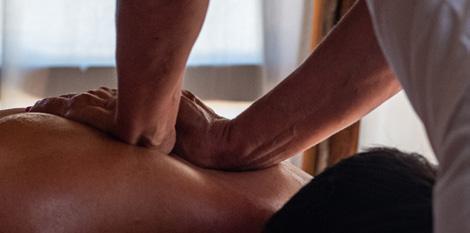

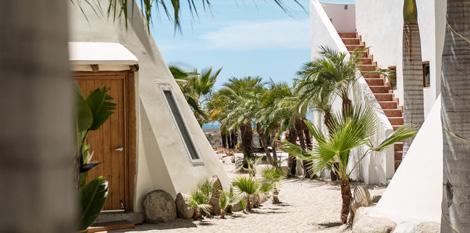
• Gourmet
Trail
Daily
Register
Hiking
A beautiful desert oasis less than an hour’s drive from Cabo San Lucas, this quaint community has an unmatched creative community and an inspiring lifestyle. Air-conditioned teepees with a sleek and modern interior have all the comfort and amenities for a rejuvenating stay including full bathrooms with bath and shower.
Awareness about ADHD is growing as is support for those with this neurodevelopmental disorder
BY ROBBIE MCDONALDFreelance writer and podcast host who uses the power of story to bust the stigmas that lurk around neurodivergence, mental health, and hidden disabilities, from Vancouver, B.C. ROBBIEDAWNINVAN ROBERTADINVAN
J olene, 37 recalls her visit to the Adult ADHD Centre last year. “I had very bad brain fog. I couldn’t remember anything. I just chalked it up to ‘mom brain’ because I do have four kids.”
She says it often felt like her mind was working against her and it was difficult to retain information. “You forget stuff right away. Or it’s not so much that you forgot, it’s that in the last ten seconds, four other thoughts have jumped in.”
ADHD (attention deficit hyperactivity disorder) is a neurodevelopmental disorder that presents in millions of people worldwide. The name can be misleading as it often presents in complex ways that have little to do with physical hyperactivity.
There are three subtypes of ADHD.
• ADHD-Inattentive Type (sometimes called ADD) people struggle to follow instructions and can be easily pulled off task by distractions.
• ADHD-Hyperactive/Impulsive
Type is the least common type and is characterized by erratic and hyperactive behaviours. People often describe being run by a motor and/or inability to sit still.
• ADHD-Combined Type is very common in adults and presents with both problems with focus and with hyperactivity/impulsivity challenges.
One of the biggest struggles is maintaining attention and sustaining focus. Contrary to some myths, it is a lifelong condition and doesn’t go away over time. It can be managed with a holistic approach tailored to an individual’s needs and goals. Counselling, coaching, exercise—and when deemed safe and appropriate, medication—can all help people to develop life skills and cope with some of the more disruptive aspects of ADHD.

“It is highly hereditary,” explains Dr. Gurdeep Parhar, Director of the Adult ADHD Centre in Burnaby, B.C. He notes the chances of having ADHD are increased in families with one or more members that have been assessed or diagnosed. He has met parents who take their children for assessment and start to see patterns in their own behaviours and challenges, so they seek out their own assessments.
Dr. Parhar says for adults, one of the biggest challenges is executive function.
“This is the brain’s capacity to prioritize and manage thoughts and actions and consider the long-term consequences of their actions.
For folks with ADHD, this can be very challenging and even feel impossible.”
Reduced impulse control is an unwanted aspect of ADHD, leading to overspending and difficulty with delayed rewards. It can lead to forgetting appointments or difficulty getting started on important projects. People with ADHD can appear restless and fidgety and often struggle to sit through meetings without taking multiple breaks. Their legs might bounce under the table or they may tap their pen repeatedly without realizing it.
Dr. Anita Parhar, PhD is the Educational Director at the Adult ADHD Centre. She says women are often diagnosed later, partly due to ways ADHD symptoms show up in women and girls.
“This could mean daydreaming more often in class, struggling to be on time, and becoming overwhelmed with day to day responsibilities,” she says. “It’s important to create a scaffolding of support to help with the challenges of ADHD and most importantly, be gentle with yourself.”
Exercise plays a crucial role in managing ADHD symptoms. Body movement and cardio can help release the nervous tension that accumulates while
sitting at a desk job or in class and the surge of dopamine that follows a sweaty workout can lead to feelings of well-being, calm and clarity.

ADHD can also be associated with depression, bipolar mood disorders, anxiety and substance use disorders. While co-existing diagnoses are fairly common, some people struggle with receiving a proper ADHD assessment and are incorrectly treated with medications that don’t address the underlying issues. It’s important to seek out an assessment with a trained medical professional.
As awareness grows about ADHD—it’s become a trend on TikTok and other
social media platforms—it’s vital to know that it is nothing to be ashamed of. There are many resources available and communities of support that are set up specifically for neurodiverse people.
For Jolene, discovering her unique brain has led to increased confidence.
“Since the brain fog has lifted, I’ve been learning a lot, and I’ve been able to retain it. When I was younger I’d wonder, why can I not pay attention to this person talking? But now I actually am able to.”
“For me, the diagnosis was a huge relief. It was like: I’m not crazy. I actually have really good intuition. And I knew this was part of who I am.”
It’s important to create a scaffolding of support to help with the challenges of ADHD and most importantly, be gentle with yourself.
Adopting a plant-based diet can also prime you for peak performance mode
BY MIKAILA KUKURUDZAFitness enthusiast, marketing nerd and complete brunch enthusiast in Toronto, ON. MIKAILAKUKURUDZA MIKAILA KUKURUDZA
t’s impossible to get enough protein to build muscle.” If you’ve ever thought this about a plant-based diet, you’re not alone—but you are wrong. As an athlete, to build muscle you need two things: consistent strength training and an adequate amount of protein.
The latter has been debated for decades with claims that it is impossible to replicate the complete animal-proteins with plantbased substitutes, but actually you can–it just takes more planning to get all nine essential amino acids. In conjunction with the rise in popularity of plant-based products, studies have shifted from overstating the downsides to being vegetarian or vegan, to finding its many health benefits. Elite athletes such as Venus Williams and Scott Jurek have proved that plant-based diets can improve performance and recovery.
Beyond your own health, dishing up plates full of plants will benefit the health of the environment. Global food production accounts for 35 per cent of all human-made greenhouse gas emissions (that’s almost 19 times the amount of carbon dioxide from the commercial aviation industry), according to a recent University of Illinois study. With animal-products producing twice the amount of emissions than planet-based ones, how you choose to fuel your body can move the needle for your own health and for the planet—without compromising your fitness goals.

Here are five tangible steps you can implement for a healthier you and a healthier planet.
1. Embrace plants, not labels. If the world’s population were to become vegetarian by 2050, we could reduce food-related
greenhouse gas emissions by 60 per cent. “Aim for effort over perfection,” says Dr. Anita Vandyke, author of A Zero Waste Life. “Small steps can make a big cumulative difference. Rather than strictly adhering to any diet and labelling it a certain way, it’s best to just be consistent and do your best.” By opting for meatless meals (even if it’s just two days a week), we can reduce risk of heart disease, lower cholesterol, improve gut health and lower mortality rate. If you’ve been holding back for fear that you won’t get enough protein to ensure your gains, rest easy. In a 2022 review of 43 studies, researchers determined plantbased animal product alternatives are healthier than animal products, aiding in weight loss and muscle synthesis. And with the plant-based meat market valued at over $5 billion last year and expected to increase by 19 per cent by 2030, options are only going to continue to improve.
2. Go (no) fish. A fresh filet may provide the essential Omega-3 fatty acids which aid heart health among a slew of other benefits, but there is a tiny problem with choosing fish as your main protein source: microplastics. Fifty-one trillion microplastic particles—more than 500 times the number of stars in the Milky Way—are in the sea and likely will make their way on to your plate. While only 0.03 per cent of ocean plastic comes from the now largely banned plastic straws, 10 per cent of all ocean plastic can be attributed to fishing gear from commercial fishing. A study that looked at the three commercially important wild fish from the north east Atlantic Ocean found that 49 per cent have microplastics in their system—32 per cent of which is found in the often-consumed dorsal muscle. By opting to get our omegas and lean protein from walnuts, flaxseeds or chia seeds, we can do our part in reducing the plastic in our bodies and our oceans.
3. Eat for the season. Filling up half your plate with local, readily available fruits and vegetables helps reduce your carbon footprint in multiple ways. The transportation of food is responsible for six per cent of the world’s greenhouse gas emissions, according to a study published in the journal,
Nature Food. Produce makes up the majority of these emissions due to the demand for out-of-season items and the refrigeration required to transport them. Eating seasonally helps you get the most nutritional value out of your produce and promotes a healthy microbiome due to a more varied diet. Also, a recent Australian study compared individuals who ate 230 grams of fruits and vegetables to those who consumed 470 grams or more. The individuals in the latter group had 10 per cent lower stress levels.
4. Pass on plastic. By shopping the areas of the store with less packaging you’ll be doing both you and the planet a favour. Ultra-processed food (usually packaged in plastic) often contains sugar, artificial ingredients and trans fats that can lead to a plethora of health issues such as heart problems and obesity. Also, researchers found that individuals whose diets consist of more than 20 per cent of ultra-processed foods experience a 28 per cent faster global cognitive decline. When we stick to whole foods we can help reduce the plastic pollution of our aquatic ecosystems and our bodies—the average person ingests a credit card’s weight of microplastics each week, according to new findings by University of Newcastle. “Don’t beat yourself up when you realize that avoiding plastic altogether is virtually impossible,” says Lindura and Dr. Antonia Sappong, co-founders of Plastic Free Toronto. “Singleuse plastic has become ubiquitous in our society, so celebrate your small wins and keep it moving.”
5. Get creative in the kitchen. How many of your perishables well…perish before you get to them? The average Canadian household throws out 79 kilograms of food each year, according to a 2021 UN Environment Program report. When you go to the grocery store try reducing your shopping list by 30 per cent and check your kitchen stores before heading back to the aisles. When produce is starting to spoil, freeze it for smoothies or future stir fry’s. By getting creative with what’s in our fridge and cooking at home more, we can ensure food is seen as it truly is— a valuable resource for fueling a healthy body.
Beyond your own health, dishing up plates full of plants will benefit the health of the environment.
Athlete and nutrition coach, Zuzana Fajkusova inspires us with the power of plants.
Tips on achieving your ideal weight – the plant-based way
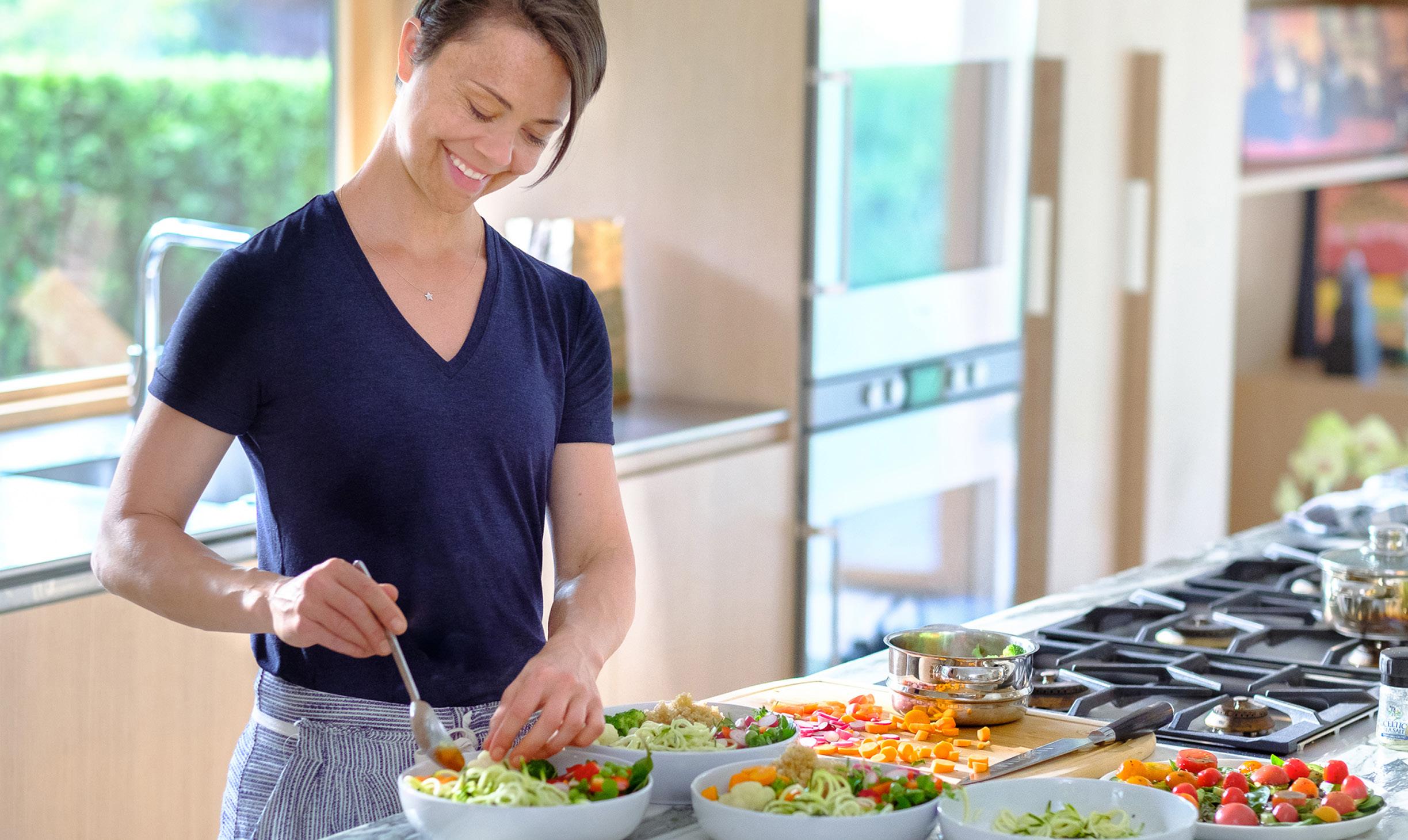 BY ZUZANA FAJKUSOVA JENNA JONES
BY ZUZANA FAJKUSOVA JENNA JONES
All too often when people hear about a plant-based diet it sparks a question: will it help me lose weight and get back into shape?
Firstly, let’s acknowledge that only a healthy body can achieve and maintain a normal weight. Our body is incredibly intelligent, and it never behaves irrationally. If it gets overloaded with stress, environmental toxins, nutritional deficiencies, too many calories, too little sleep and many more imbalances, it will not be able to digest and metabolize food efficiently. This chronic physical and emotional stress will result in toxicity and excess body weight.
Eating a highly processed diet of nutrient-depleted foods
Overconsumption of acid-forming foods and supplements
Overworking
Overtraining
Overstimulation of senses
Exhaustion
Lack of sleep
Irregular eating habits
Heavy nighttime meals
Overeating
• Stimulants such as coffee, tea and cigarettes
• Not drinking enough water
• Feeling unfulfilled and dissatisfied
• Alcohol consumption
• Unresolved conflicts (impairing digestion)
• Fear, worry and other emotional upsets
• Environmental toxins and pollution (air, water, soil)
If your goal is to lose body fat and achieve a healthy weight, forget the newest crash diet, extreme workouts, supplements
or diet pills, and concentrate on reducing stress, detoxifying and healing your body. Consider the following strategies to help you reach your goals.
• Eat primarily organic, plant-based foods that are minimally processed.
• Eat smaller meals throughout the day.
• Favour alkaline-forming, low-calorie, nutrient-rich raw foods.
• Slow down your meals and enjoy each bite of your food.








• Do not eat when ill or upset.
• Hydrate with pure water.
• Prioritize a good night’s sleep.
• Maintain emotional balance; release worry, fear and anxiety, jealousy, stress and resentment through physical exercise and deep breathing.
• Live in a place that contributes to good health (fresh, clean air, low crime rate, etc.)
• Develop loving and supportive relationships with your partner, family and friends.
Your health and body composition will improve automatically once you remove toxicity and keep your body and mind open and clean.
The best way to build new muscle tissue is to regularly challenge your body with intense resistance training and nourish it with the right building blocks. When it comes to training, choose exercises that are difficult yet safe and that you enjoy. Make strength training part of your lifestyle. Each time you train, you will create small micro-tears in your muscles as you challenge your body with more repetitions and heavier weights. This micro breakdown in the muscle tissue doesn’t stop at the end of the workout, it continues even after your last rep. That’s why proper nourishment is a crucial component of muscle growth. By giving your body the right nutrients it needs to repair these tears, your muscles will rebuild, growing bigger and stronger. Following the principles of the whole food plant-based diet is an ideal place to start; however, if your goal is to build lean muscle mass, you will have to put particular emphasis on the amount of food you consume—you’ll need plenty of lean protein, quality carbs and healthy fats, too.
Protein is the building block of muscle tissue, and you will need quality protein, in larger quantities than non-athletes, to
grow and maintain lean muscle. Protein comprises a variety of amino acids; some amino acids are essential to obtain from the diet; others, your body can produce itself. By including a variety of lean, plant-based protein sources, you ensure that your amino acid needs are being met. How much protein do you need to gain lean muscle? Over the years, I have found that most people, myself included, who eat a whole food plant-based diet and lift weights regularly need roughly 0.5 to 0.75 grams of protein per pound (455 g) of body weight each day to achieve their desired body composition. So, if your goal is to be 130 pounds (59 kg), lean, muscular, and vibrant, then you will want to aim for a minimum of 75 grams of high-quality, bioavailable plant-based protein per day.
Carbs often get a bad rap, but when you’re building muscle they are just as important as protein. Carbohydrates provide your body with energy. Muscles can store energy from carbohydrates and use them as fuel during workouts. However, because muscles can only store a limited amount of these carbs, you have to consume more before, during and after your training session. Doing this will give you the energy you need to fuel a powerful workout and allow you to recover faster.
Don’t neglect fat in your diet, even if your goal is to shed body fat while you build or maintain lean muscle. Healthy fats, such as cold-pressed oils, nuts, seeds, avocado, chia and hemp, play an important role in metabolizing the food you eat. Without dietary fat, your body cannot absorb vitamins A, D, E and K. Fat is also essential in the production of hormones, necessary for the lubrication of joints and helps protect muscle tissue from breaking down.
1. Eat Real Food Walk into the average supermarket and you will find a variety of processed vegan products—sausages, cheese,
yogurts, burgers, ice cream and other food-like substances made to mimic various animal products. Although these foods might be tempting, many of them are over-processed and nutrientdepleted. Make sure you’re not relying on these vegan convenience foods and instead eat real food.
2. Abundance, not Restriction
Do not starve yourself to get lean! Aim to fill three-quarters of your plate with foods that are lower in caloric density yet satisfying. Main food staples should be grains (whole grain rice, quinoa, wild rice, buckwheat, millet) and of course vegetables (particularly green vegetables), beans, fruit, nuts and seeds. Eat until you are satisfied.
3. Ditch the Processed Sugar
Keep a closer eye on your daily sugar intake. Become aware of what’s in your food. Added sugar lives in processed foods, even foods you wouldn’t expect (such as salad dressings, granola, bread or protein bars).
4. Alcohol
If your goal is to lose fat and enjoy vibrant health, consider cutting back on drinking. Alcoholic drinks are empty calories. They provide little to no nutritional value. Also, while the liver is busy metabolizing alcohol, it is unable to metabolize fat. Alcohol is not treated as a nutrient by the liver, it is treated as a poison. It wraps it up in a fat cell and stores it which is why it sabotages your health and body composition.
5. Eating Out
Eating out should be a treat, not a convenience. Make the time to prepare healthy meals most of the time and save your eating out experiences as a treat or highlight of your week, rather than a quick and easy way to get food.
Overall, if your goal is to lose fat and gain muscle, you need to step outside your comfort zone regularly. Train hard, eat clean, get enough rest and keep your thoughts positive and you will see results.




If you are experiencing oral pain, swelling, bleeding and don’t know why, you may have a dental emergency that requires immediate attention. At Inglewood Family Dental, patients will receive same-day appointments who require emergency dental care in Calgary. Dental emergencies don’t always happen during normal business hours, therefore, extended evening hours and weekends are available.
It’s important to know that delaying urgent dental treatment can lead to more serious issues that can end up costing more time, money, and frustration down the line, so if you believe that you have a dental emergency, it’s best not to hold off. A full evaluation will help you make an informed decision about your health.
If you or someone you love is experiencing oral pain, dental trauma, or are unsure if your issue is urgent, we encourage you to call (587) 355-2542 for a consultation.
Inglewood Family Dental also offers a variety of sedation dentistry options so that patients can relax during their emergency dental procedures.
Do your teeth hurt when you eat? Are they sensitive to hot or cold food or drinks? Do you experience oral pain that comes and goes? All of these are common symptoms of chipped, cracked, or fractured teeth. If left untreated, these types of injuries can become infected and cause more serious harm to the health of your smile.
If you are suffering from excruciating tooth pain, you may require an emergency tooth extraction. Preserving your natural teeth is a top priority, so pulling a tooth is always a last resort. However, sometimes badly damaged or decayed teeth are unable to be saved. Tooth extractions can happen for standard reasons like wisdom teeth to more critical issues like advanced periodontal disease.
Swollen gums can be a sign of severe mouth infection, whether you are experiencing pain or not. If the swelling is severe, it requires immediate attention as it could indicate a more serious condition. Some of the common conditions associated with swollen gums include:
• Pericoronitis – swelling or inflammation of the gum tissue surrounding your wisdom teeth. It is most common in your lower teeth and can be mild and resolve on it’s own. However, some cases involve severe pain and swelling which require immediate attention.
• Periodontal Abscess – a pocket of pus in the gum tissue which causes the gums to push away from the teeth. These are common and painful dental emergencies that often result from accumulation of bacteria or impaction of a foreign body (food) in periodontal pockets.
1420 9 Ave SE #24, Calgary, AB inglewoodfamilydental.ca


Is magnesium part of your nutrition plan?
Studies show it can help your fitness and endurance.
BY EMMA HERRLEHealth and science writer, studying cognitive science at McGill University, planning to become an obstetrician/gynecologist, from Toronto, ON. EMMA HERRLE
Your body needs magnesium for sleep, energy, stress management, mood regulation, brain health, strong bones, healthy blood sugar, inflammation, and more. Yet few people realize that magnesium is also a key mineral for fitness. Whether you’re a dedicated athlete or you exercise purely for fitness, magnesium can make all the difference in your performance and endurance.
Do you get that achy feeling the morning after a good workout? While this can be satisfying because you know you’ve pushed yourself you could also be feeling some delayed onset muscle soreness (DOMS) particularly if you can’t walk or move properly.
DOMS is believed to be a result of microtears to muscle fibres. These cause an increase in blood flow and inflammation to the area, which makes the area more responsive to movement by stimulating
the pain receptors within the muscle tissue, making you stiff and sore in the following days.
Magnesium reduces inflammation and thus can downgrade post-exercise DOMS pain. A 2021 study on the effects of magnesium supplementation on muscle soreness and performance found that magnesium supplementation (350 mg/day for 10 days) significantly reduced muscle soreness at 24, 36, and 48 hours.
Lactic acid, a normal by-product of muscle metabolism, can also cause you to “feel the burn” after exercise. But magnesium neutralizes lactic acid. It has been shown to reduce lactic acid levels and exercise-induced pain.
Exercise is a form of stress—albeit a healthy form—and as such, exercise speeds up our magnesium burn rate. The effort involved in muscle contraction, respiration, and energy production places increased demand on our magnesium stores.
Even without sweat, we excrete magnesium daily. Add a good workout, and you lose magnesium through your pores (endurance athletes sweat 1- 1.5 l/ hour). You also don’t need to cut back on exercise to get your magnesium in balance. Statistically, most people don’t eat enough dark leafy greens, legumes, nuts, and seeds. Yet, even if you do, those foods deliver less magnesium than whole foods did 100 years ago because of the leaching of soils through industrial agriculture. Some great magnesium-rich foods to add to your diet are dark chocolate, avocados, and tofu.
You can also easily replace your magnesium with supplements. “Picking a high quality, easily absorbed magnesium supplement is one of the fastest ways to boost magnesium levels and alleviate symptoms of deficiency,” says Linda Bolton, top Canadian health influencer and founder, Natural Calm Canada.
It’s important to note that caffeine, sugar, and sodium in sports and electrolyte replacement drinks, protein bars, shakes with lots of calcium, and sports gels can all deplete your magnesium reserves, so choose your workout fuel wisely.
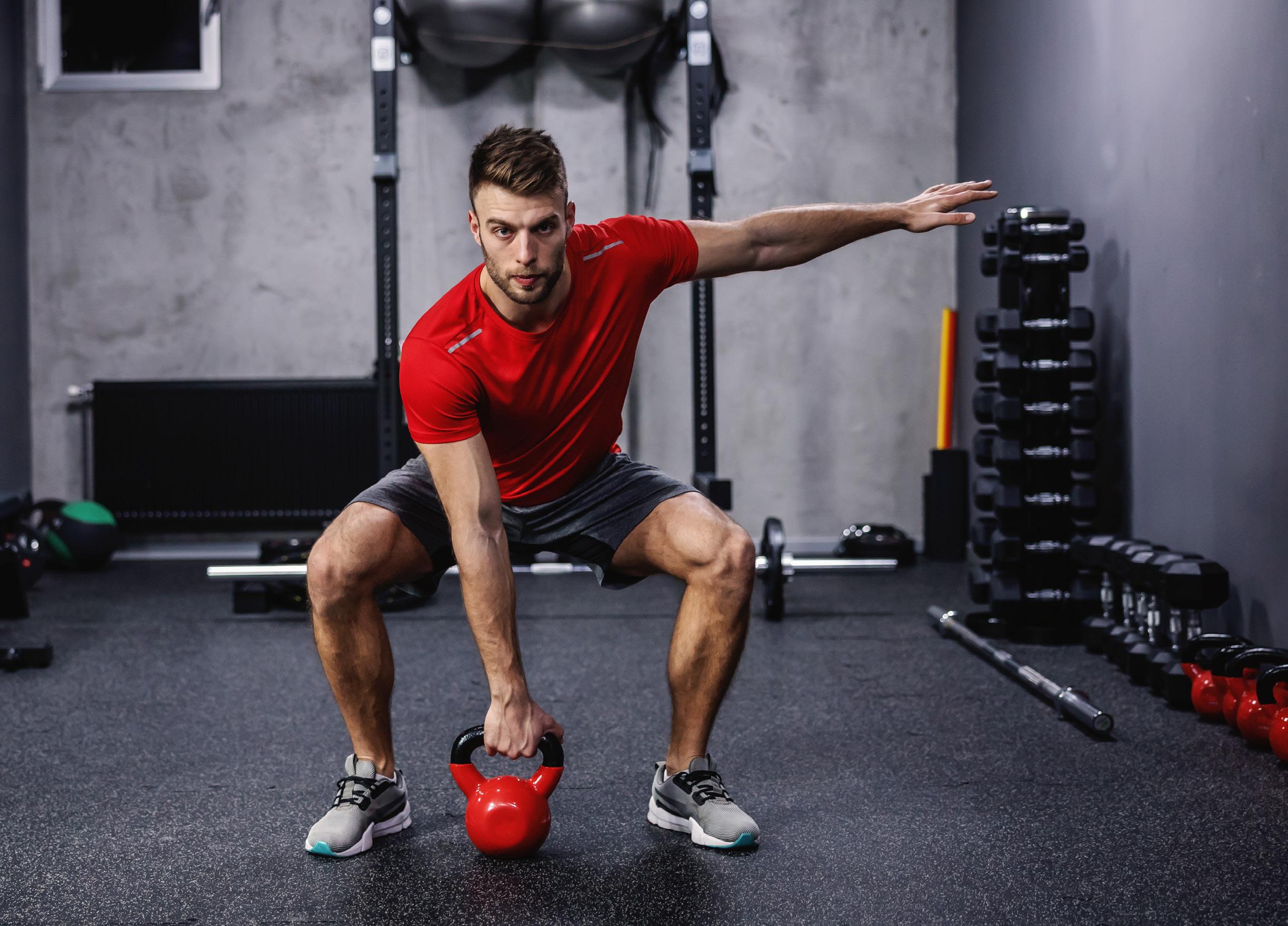
Fortunately, if you correct a magnesium deficiency, your body will become more efficient at producing energy, and you might not need these performance enhancers.
There have been many studies on magnesium and performance in recent years. In a tightly controlled, three-month study in 2002, the effects of magnesium depletion on exercise performance in 10 women were observed. The study established that when magnesium was deficient, metabolic efficiency was reduced as heart rate and oxygen intake increased. Low magnesium made the body work much harder to perform the same task.
In 2006 the same authors—Nielsen and Lukaski—published an update on the
relationship between magnesium and exercise and concluded that: “magnesium supplementation or increased dietary intake of magnesium will have beneficial effects on exercise performance in magnesium-deficient individuals.”
Other studies contrasting athletes under magnesium supplementation with control groups have found that: “magnesium supplementation positively influences performance (Cinar, Nizamlioglu, Mogulkoc, & Baltaci, 2007)” and that it “improved alactic anaerobic metabolism” even in athletes who were not magnesium deficient (Setaro et al., 2014).
How much magnesium do you need for fitness and exercise performance? No two people have the same magnesium requirements. Body size, age, lifestyle, stress, and exercise are factors. “Research has shown that even by conservative estimates, working out increases your body’s magnesium demands by up to 20
per cent,” adds Bolton. That means, if your RDA for magnesium is 400 mg/day before exercise, you may need closer to 500 mg if you exercise often.
Unfortunately, most of us aren’t meeting our magnesium requirements through diet alone. The best way to determine whether you are getting enough magnesium and to find your intake sweet spot is by looking at symptoms. Common symptoms of low magnesium include tension, cramps, pain (headaches and muscle pain), restlessness, anxiety, difficulty sleeping, and even constipation. So, it is important to address your low magnesium to prevent fatigue, lethargy, weakness, nausea, and other health risks linked to magnesium deficiency.
Whether you’re a casual exercise person, a fitness buff, or a serious athlete, make sure you’re getting enough magnesium as part of your performance nutrition and recovery plan.
The more I’ve researched over the years, the more I’ve come to realize that healthy foods are not necessarily interchangeable. Some foods and food groups have special nutrients not found in abundance elsewhere. For example, sulforaphane, the amazing liver-enzyme detox-boosting compound, is derived nearly exclusively from cruciferous vegetables. You could eat tons of other kinds of greens and vegetables on a given day, and get no appreciable sulforaphane if you didn’t eat something cruciferous.
It’s the same with flax seeds and the anticancer lignan compounds. Flax may average a hundred times more lignans than other foods. And mushrooms aren’t even plants at all; they belong to an entirely different biological classification, and may contain nutrients (like ergothioneine) not made anywhere in the plant kingdom.
It seems like every time I come home from the medical library buzzing with some exciting new data, my family rolls their eyes, sighs, and asks, “What can’t we eat now?” Or they’ll say, “Wait a second. Why does everything seem to have parsley in it all of a sudden, or something?” They’re very tolerant.
As the list of foods I tried to fit into my daily diet grew, I made a checklist and had it up on a little dry-erase board on the fridge, and we’d make a game out of ticking off the boxes. This evolved into my Daily Dozen: the checklist of all the things I try to fit into my daily routine.
This may all sound like a lot of boxes to check, but it’s easy to knock off a bunch at a time. One simple peanut butter-banana sandwich, and you just checked off four boxes. Or, imagine sitting down to a big salad: two cups of spinach, a handful of arugula, a handful of walnuts, a half-cup of chickpeas, a half-cup of red bell pepper, and a small tomato. You just knocked out seven boxes in one dish. Sprinkle on your flax, add a handful of goji berries, and
enjoy it with a glass of water and fruit for dessert, and you just wiped out nearly half your daily check boxes in a single meal! And then, if you just eat it on your treadmill—just kidding!
Whenever I was sitting down to a meal, I would ask myself: Could I add greens to this? Could I add beans to this? (I always have an open can of beans in the fridge.) Can I sprinkle on some flax or pumpkin seeds, or maybe some dried fruit? The checklist just got me into the habit of thinking, How can I make this meal even healthier?
I also found the checklist helped with grocery shopping. Although I always keep bags of frozen berries and greens in the freezer, if I’m at the store and want to buy fresh produce for the week, it helps me figure out how much kale or blueberries I need.
The checklist also helps me picture what a meal might look like. Looking over the checklist, you’ll see that there are three servings each of beans, fruits, and whole grains, and about twice as many vegetables in total than any other component. So, glancing at my plate, I can imagine one quarter of it filled with grains, one quarter with legumes, and a half a plate filled with vegetables, along with maybe a side salad and fruit for dessert. I happen to like one-bowl meals where everything’s mixed together, but the checklist still helps me to visualize. Instead of a big bowl of spaghetti with some veggies and lentils on top, I think of a big bowl of vegetables with some pasta and lentils mixed in. Instead of a big plate of quinoa with some stir-fried vegetables on top, I picture a meal that’s mostly vegetables—and oh, look! There’s some quinoa and beans in there too.
But, there’s no need to be obsessive about the Daily Dozen. You know, on hectic travel days, when I’ve burned through my snacks and get stuck in some airport food court, sometimes I’m lucky if I even hit a quarter of my goals. If you eat poorly one day, just try to eat better the next.
My hope is that the checklist will just serve as a helpful reminder to try to eat a variety of some of the healthiest foods every day.
Instead of a big bowl of spaghetti with some veggies and lentils on top, I think of a big bowl of vegetables with some pasta and lentils mixed in.
By beans, I mean legumes, which also includes split peas, chickpeas, and lentils. You know, while eating a bowl of pea soup or dipping carrots into hummus may not seem like eating beans, it certainly counts. We should try to get three servings a day. A serving is defined as a quarter-cup of hummus or bean dip, a half-cup of cooked beans, split peas, lentils, tofu, or tempeh, or a full cup of fresh peas or sprouted lentils. Though peanuts are technically legumes, nutritionally, I’ve grouped them in the Nuts category, just as I would shunt green beans, snap peas, and string beans into the Other Vegetables category.
1 SERVING
Common cruciferous vegetables include broccoli, cabbage, collards, and kale. I recommend at least one serving a day (typically a half-cup) and at least two additional servings of greens a day— cruciferous or otherwise.
A serving of whole grains can be considered a half-cup of hot cereal, such as oatmeal, cooked whole grains, or so-called “pseudograins,” like amaranth, buckwheat, and quinoa, or a half-cup of cooked pasta or corn kernels, a cup of ready-to-eat (cold) cereal, one tortilla or slice of bread, half a bagel or English muffin, or three cups of air-popped popcorn.
A serving of berries is a half-cup fresh or frozen, or a quarter-cup of dried. While, biologically speaking, avocados, bananas, and even watermelons are technically berries, I’m using the colloquial term for any small edible fruit—which is why I include kumquats and grapes and raisins, as well as fruits that are typically thought of as berries, but actually technically aren’t, such as blackberries, cherries, mulberries, raspberries, and strawberries.
Serving sizes for other greens and vegetables are a cup for raw leafy vegetables, a half-cup for other raw or cooked non-leafy vegetables, and a quarter-cup for dried mushrooms.
1 SERVING
Everyone should try to incorporate one tablespoon of ground flax seeds into their daily diet, in addition to a serving of nuts or other seeds.
1 SERVING
A quarter-cup of nuts is considered a serving, or two tablespoons of nut or seed butters, including peanut butter. (Chestnuts and coconuts, though, don’t nutritionally count as nuts.)
For other fruits, a serving is a medium-sized fruit, a cup of cut-up fruit, or a quarter-cup of dried fruit. Again, I’m using the colloquial, rather than the botanical, definition. So, I place tomatoes in the Other Vegetables group.
1 SERVING
I also recommend one-quarter teaspoon a day of the spice turmeric, along with any other (salt-free) herbs and spices you may enjoy.
The serving size in the beverage category is one glass (12 ounces), and the recommended five glasses a day is in addition to the water you get naturally from the foods in your diet. I explain my rationale in my video How Many Glasses of Water Should We Drink a Day?
1 SERVING
Finally, I advise one daily “serving” of exercise, which can be split up over the day.
I recommend ninety minutes of moderateintensity activity each day, such as brisk (four miles per hour) walking, or forty minutes of vigorous activity (such as jogging or active sports) each day.
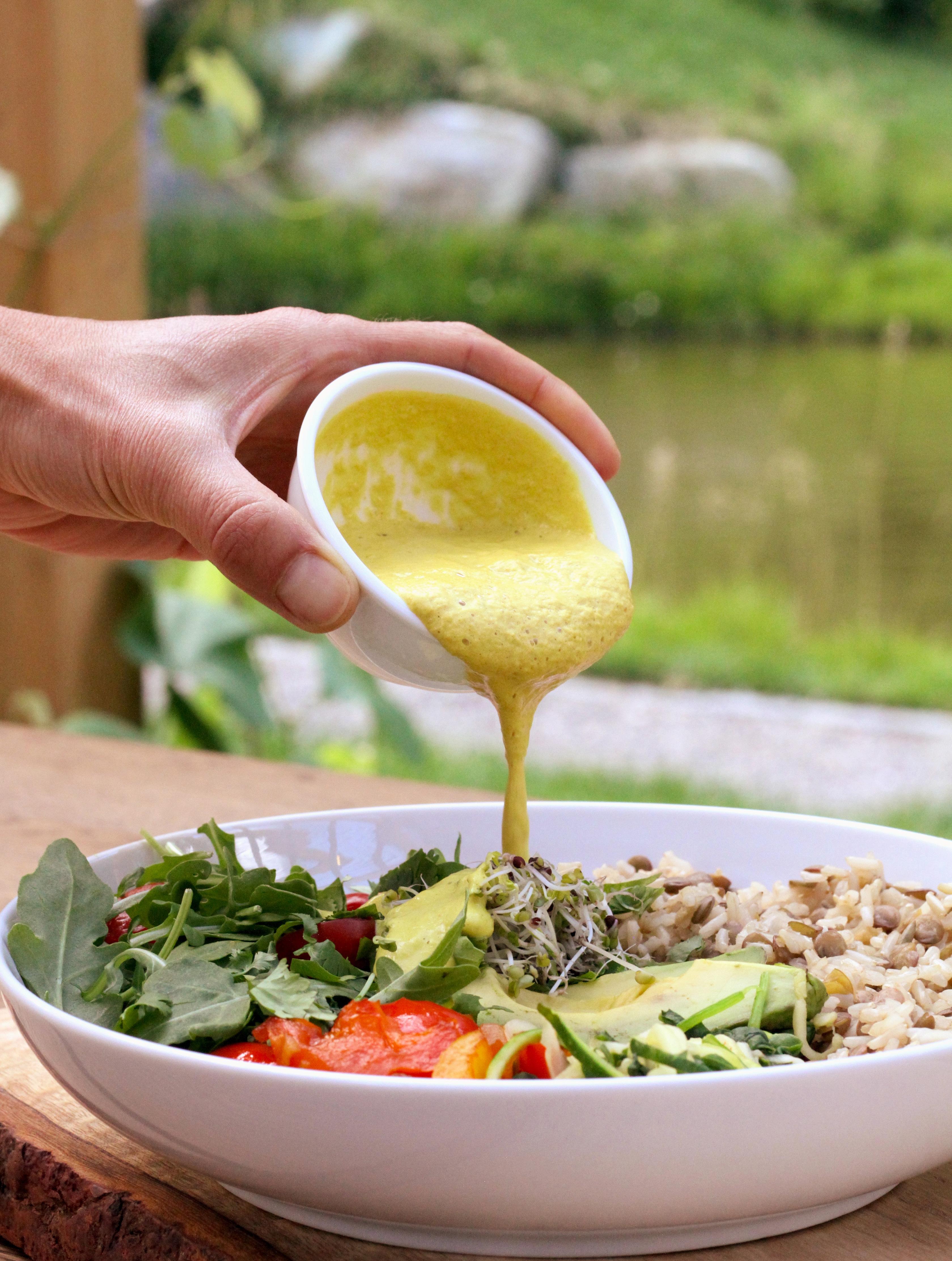
This quick-to-make nourish bowl is packed full of raw and cooked veggies, and plant-based protein and it’s drizzled with our homemade vegan “cheese” sauce. It makes for a simple weeknight dinner and will satisfy your cravings for comfort food.
RECIPE AND PHOTOGRAPHY BY ZUZANA FAJKUSOVAPersonal wellness coach, author of The Vegan Weight Loss Manifesto and Plant Powered Athlete, in Vancouver, B.C. ACTIVEVEGETARIAN ACTIVEVEGETARIAN
Prep Time: 10 mins
Cook Time: 30 mins
Total Time: 40 mins
Serves 2
• 1/3 cup green or brown lentils
• 1/2 cup whole grain rice
• 1 Tbsp coconut oil
• 1/2 sweet onion, sliced
• 1 red bell pepper, sliced
• 1 yellow bell pepper, sliced
• 1/2 tsp smoked paprika
• 1/2 tsp unrefined sea salt
• 1 small zucchini, spiraled
• 2 cups baby spinach
• 3 cups arugula
• 1/3 cup fresh cilantro chopped
• 10 cherry tomatoes, halved
• 1/2 avocado, sliced
• sprouts of choice
1. Soak rice and lentils for at least 30 minutes (preferably 8 hours or overnight). (see notes)
2. Drain and rinse the rice and lentils and add them to a medium pot on high heat with 1 1/2 cups of water. Bring to a boil then reduce to a simmer, with the lid partially covered. Cook until all water is absorbed and al dente, about 30 minutes. If the rice and lentils have cooked and are al dente but some liquid remains, simply drain the liquid and let sit on low heat without a lid to allow the excess moisture to evaporate.
3. While rice and lentils are cooking, prepare your sauté veggies. Add coconut oil and onions to a medium pan and sauté on high heat for 2 minutes, stirring and adding 1 Tbsp. water as needed to prevent burning. Add peppers, smoked paprika and salt and continue to stir (and add water as needed) for another 4 minutes. Add spiralized zucchini and spinach gently mix it all together and continue to cook for only 1 more minute then remove from heat.
Divide the fresh arugula, cilantro, tomatoes, avocado and sprouts among the bowls.
Top each with 1/2 - 1 cup cooked rice and lentils and a generous amount of sautéed veggies.
Drizzle with vegan cheese sauce. Enjoy!
NOTE:
Soaking brown rice helps to quicken cooking time, and soaking lentils is beneficial for many reasons. Use organic ingredients whenever possible.
• ½ cup of water
• 1/3 cup raw sunflower seeds, soaked at least 30 mins in warm water
• 1 tsp Dijon mustard
• 2 Tbsp. nutritional yeast
• 1 Tbsp. lemon juice
• 2 Tbsp. apple cider vinegar
• 1 tsp. turmeric
• 1/2 tsp. unrefined sea salt
• Generous pinch of black pepper
1. Drain and rinse the sunflower seeds then add them to a high-speed blender along with the remaining ingredients. Blend on high until smooth and creamy, adding additional water as needed.
Store in an airtight container in the fridge. Will last about 2 or 3 days.
Nutrition facts per serving Calories 477; protein 19 g; fat 20 g; carbs 57 g.
This Bengali five-spice dish is a lively choice for any night of the week
BY PREENA CHAUHAN AND ARVINDA CHAUHAN REENA NEWMANProprietors of Canadian-based, Arvinda’s Spices & Chai, regularly appearing as food experts on TV shows like Cityline, from Oakville and Mississauga, ON. ARVINDAS
Panch phoran consists of five different spices that deliver a distinctive punch of flavour—brown mustard seeds add a mild pungency; nigella seeds lend a delicious oniony flavour; fenugreek seeds give a touch of bitterness; cumin brings in warmth and earthiness; fennel imparts a licorice-like sweetness. This Bengali five-spice never fails to add excitement to a dish, and this channa dal preparation with pumpkin is no exception. Channa dal as a lentil has a wonderful hearty texture and can handle the bold flavours of panch phoran. When cooked in the Instant Pot, the panch phoran imparts its extraordinary flavour so impeccably well.
Prep time: 15 minutes, plus 10 minutes for instant pot natural pressure release Cook time: 20 minutes
4
• 1 cup channa dal (Indian chickpeas, split and hulled), dried
• 2 Tbsp. sunflower oil
• 2 tsp. Panch Phoran
• 1 cup cubed peeled pumpkin
• 1 medium tomato, finely cubed
• 1 1/4 tsp. sea salt, plus extra if necessary
• 1/2 tsp. coriander powder
• 1/2 tsp. cumin powder
• 1/2 tsp. turmeric powder
• 1/4 tsp. Indian chili powder
• 1/2 tsp. garlic paste
• 2 cups water, plus extra if necessary
• Warming garam masala to garnish
• Fresh cilantro, to garnish
1. In a medium bowl, rinse the channa dal in a few changes of warm water. Cover with fresh warm water and set aside to soak.
2. Meanwhile, turn the setting of an Instant Pot to “sauté more.” Heat the oil and sprinkle in the panch phoran. Fry the spices until the cumin seeds turn golden brown, the mustard seeds begin to pop, and the spices become fragrant.
3. Lower the setting to “sauté less.” Add the pumpkin and tomatoes and sprinkle in the salt, coriander, cumin, turmeric, and chili powder. Mix together, then stir in the garlic paste. Cook for a couple of minutes, until the spices become fragrant.
4. Drain the dal and add it to the Instant Pot, gently folding to coat the dal with the spices. Add the 2 cups water.
Once the pressure cooking is complete, the Instant Pot will begin the natural pressure release. Allow for 10 minutes of natural pressure release, then release the remaining pressure manually by carefully setting the pressure release valve to venting. Always wear an oven mitt or glove when venting and keep your hands and face away from the vent, as the steam is extremely hot and can burn! Handle the valve from the side, not from above or overhead. Open the lid only when it is safe to do so, checking that all the pressure has been released first.
6. Stir the dal, then thin out with extra water and adjust the salt if required.
Excerpted from New Indian Basics: 100 Traditional and Modern Recipes from Arvinda’s Family Kitchen. Copyright © 2022Preena Chauhan. Published in Canada by Appetite by Random House, a division of Penguin Random House Canada Limited. Reproduced by arrangement with the Publisher. All rights reserved.
5. Take care to secure the lid correctly and be sure the pressure release valve is set to the sealing position. This is very important. The Instant Pot will register as “on.” Adjust the setting to “pressure cook low” and set the timer for 3 minutes.
7. Transfer the dal to a serving dish and garnish with garam masala and cilantro to taste.
Nutrition facts per serving Calories 166; protein 3.75 g; fat 4.75 g; carbs 15 g.

Explore textures, colours, flavours and nutrients with this recipe, perfect for the early days of autumn
Servings: 2
• 1 small butternut squash
• 1 Tbsp coconut oil (or Earth Balance’s Buttery Spread, or lemon juice)
• 1 tsp dried basil
• 1 tsp dried thyme
• 1/8 tsp Himalayan salt
• 1/2 tsp black pepper
• 1 head broccoli
• 1/4 cup chopped green onion
• 2 tsp white sesame seeds
• 2 Tbsp almond butter
• 1 tsp maple syrup
• 1 tsp tamari
• 1 tsp miso paste
• 1 tsp apple cider vinegar
• 1/8 tsp chipotle powder
• 1 garlic clove
• 3-4 Tbsp. water, or more, as needed
1. To prepare the squash: peel, deseed and cut into 1/2-inch cubes; toss with melted coconut oil, salt, pepper and herbs. Bake for 30 minutes at 375 F, or until each piece is tender all the way through (test one with a fork).
2. Cut the broccoli into bite-size pieces and steam for 7-8 minutes or until vibrantly green and slightly tender.

3. To make the sauce: blend everything together until smooth, adding as much or as little water as you like.
4. Place butternut squash and broccoli on a plate or in a bowl, drizzle with your sauce, then sprinkle on green onion and sesame seeds.
This would also be delicious with rice or noodles added!
Nutrition facts per serving Calories 261; protein 6.5 g; fat 15.5 g; carbs 24.5 g.


One of the most iconic desserts is the classic banana split, which has been served in diners across the Western Hemisphere for decades. This deluxe and dairy-free version features a chocolate sauce that’s easy to make, strawberry sauce, and whipped cream made from coconut milk. Make it with my Best Banana Soft Serve but any vanilla ice cream will do. Note that you need to chill the coconut milk in the freezer for t wo hours, so plan ahead!
Servings: 2 banana splits INGREDIENTS
• 2 cups chopped very ripe frozen bananas (see Tip)
• 3 Tbsp. unsweetened almond milk or soy milk
• 1 Tbsp. maple syrup
• 1 tsp. pure vanilla extract
• 6 Tbsp. maple syrup
• 6 Tbsp. cocoa powder
• ¼ cup melted virgin coconut oil
• 2 Tbsp. cold water
• ½ tsp. pure vanilla extract
• Pinch of sea salt
• 1 cup frozen strawberries
• 1 Tbsp. sugar
• 1 tsp. pure vanilla extract
• ½ tsp. freshly squeezed lemon juice
• 1 can (14 oz.) full-fat coconut milk, chilled in freezer for 2 hours (see Tip)
• 2 Tbsp. agave nectar or maple syrup
• 1 tsp. pure vanilla extract
• 2 bananas, cut in half lengthwise
• 1 cup Best Banana Soft Serve
• Fresh strawberries, cut in half
• Chopped unsalted peanuts
1. Make the ice cream: In a food processor fitted with a metal blade, combine the bananas, almond milk, maple syrup, and vanilla. Process until the bananas are crumbly, about 2 minutes. Using a rubber spatula, scrape down the sides of the bowl. Process again until the bananas start to become somewhat smooth, about 1 more minute.
2. Scrape down the sides of the bowl again. Process until the bananas are smooth, creamy, and look and feel like soft serve ice cream. Serve immediately or freeze for 30 minutes. You will need to eat the ice cream almost right away because it does not keep well frozen for long periods like traditional ice cream usually does.
3. Make the chocolate sauce: In a small bowl, combine the maple syrup, cocoa powder, coconut oil, water, vanilla, and salt. Whisk until well combined; there should be no lumps and the sauce should be smooth and shiny.
4. Make the strawberry sauce: In a small pot, combine the strawberries, sugar, vanilla, and lemon juice. Bring to a boil uncovered, then reduce the heat to a simmer. Cook, stirring frequently, until the mixture is thick, 10 to 12 minutes.
5. Make the whipped cream: Freeze the can of coconut milk for about 2 hours, or long enough for the fat to separate completely from the liquid. Carefully scoop the solid
cream that has separated into the chilled bowl of a stand mixer fitted with the whisk attachment. Reserve the remaining liquid in an airtight container in the refrigerator for up to 3 days.
6. Whip the coconut cream for 4 to 5 minutes, or until soft peaks begin to form. Add the agave and vanilla and whip for 1 to 2 more minutes, or until stiff peaks form. Serve immediately or transfer to an airtight container and store in the fridge for up to 2 days.
7. Make the banana splits: Place 2 banana slices in each serving dish and move them to each side of the dish, leaving room in the middle for the ice cream.
Place 3 scoops of ice cream in the middle of each dish. Top with strawberry sauce, chocolate sauce, and whipped cream, then top with fresh strawberries and chopped peanuts. Serve immediately.
TIPS: It is best to make this ice cream with frozen bananas that are very ripe and covered in brown spots. Firmer green bananas will not break down and become smooth and creamy.
Most commercial coconut milks have some type of emulsifier added. This keeps the fat and water blended but can make whipping it to stiff peaks a little more challenging. If you are using coconut milk that has an added emulsifier, add a pinch of xanthan gum while the cream is mixing. This will help hold the air that has already been incorporated into the cream.
Nutrition facts per serving Calories 1272; protein 8.7 g; fat 94 g; carbs 119.5 g.
A retired nurse, homemaker, co-founder of the McDougall Program and co-author of 13 national best-selling books in Santa Rosa, CA. Mary is best known as the inventor of low-fat, vegan cooking and loves sharing the practical methods of turning the kitchen into a healthbuilder for the whole family.
This gorgeous chocolate pie is nestled in a delicious cashew crust and is incredibly rich and decadent. S erve in small wedges and enjoy this luxurious, chocolate lover’s dream with friends and family.

Servings: Makes one 9-inch pie
• 1/3 cup unsalted, roasted cashews
• 3 Tbsp. Sucanat or brown sugar
• 3 Tbsp. prune puree
• 1/2 tsp. vanilla extract
• 1 cup unbleached white flour
• Dash salt
• 2 cups vegan (non-dairy) chocolate chips
• 24.6 oz. extra firm, silken tofu
• 3/4 cup Sucanat or brown sugar
• 1 tsp. vanilla extract
• Dash salt
• 1 cup thinly sliced almonds
• 1/4 cup maple syrup
• 10 oz. bag frozen, unsweetened raspberries, thawed
• 1/4 cup sugar
1. Preheat oven to 350 F.
2. Use a 9-inch silicone springform pan. (Side may be loosened and removed after baking.)
3. Place the cashews in a food processor and grind until they resemble fine meal. Add Sucanat or sugar, prune puree and vanilla. Process until well combined. Mix the flour and salt in a medium bowl. Add the cashew mixture and mix well, beginning with a spoon and ending with your hands. Press this mixture into the bottom of the prepared pan. Bake for 15 minutes, until light brown. Remove from oven and set aside.
4. Place the chocolate chips in a double boiler and melt over barely simmering water. Place the tofu in a food processor and process until smooth. Add Sucanat or sugar, vanilla, and salt. Process again, then add the melted chocolate. Blend until smooth and creamy.
5. Scoop the chocolate mixture into the pan. Smooth out the top and bake at 350 F for 35 minutes. Remove from oven and
let cool to touch (10-15 minutes), then refrigerate for at least two hours before serving. Remove side before serving.
6. Place the maple syrup in a small saucepan and bring to a boil. Cook, stirring constantly for about one minute, then add the almonds, reduce the heat and continue to stir at least five minutes until the syrup
A very rich dessert to be savoured on your most special occasions
has crystallized onto the almonds and the almonds appear dry. (If the heat is too high, the sugar will burn and you will have a sticky, smelly mess.) Place on a baking sheet and allow to cool. Store at room temperature in a covered container.
7. Place the raspberries and sugar in a blender jar. Process until blended.
Strain the sauce through a fine strainer, stirring often to remove the seeds. Leave the mixture in the strainer for at least one hour to allow as much sauce as possible to drip through. Discard the seeds and pour the seedless sauce into a covered container and refrigerate until ready to use.
Cut a small wedge of the chocolate pie and place on a dessert plate. Sprinkle a few of the almonds over the pie, then drizzle with a small amount of the raspberry sauce.
Nutrition facts per serving Calories 453; protein 12 g; fat 18 g; carbs 76 g.
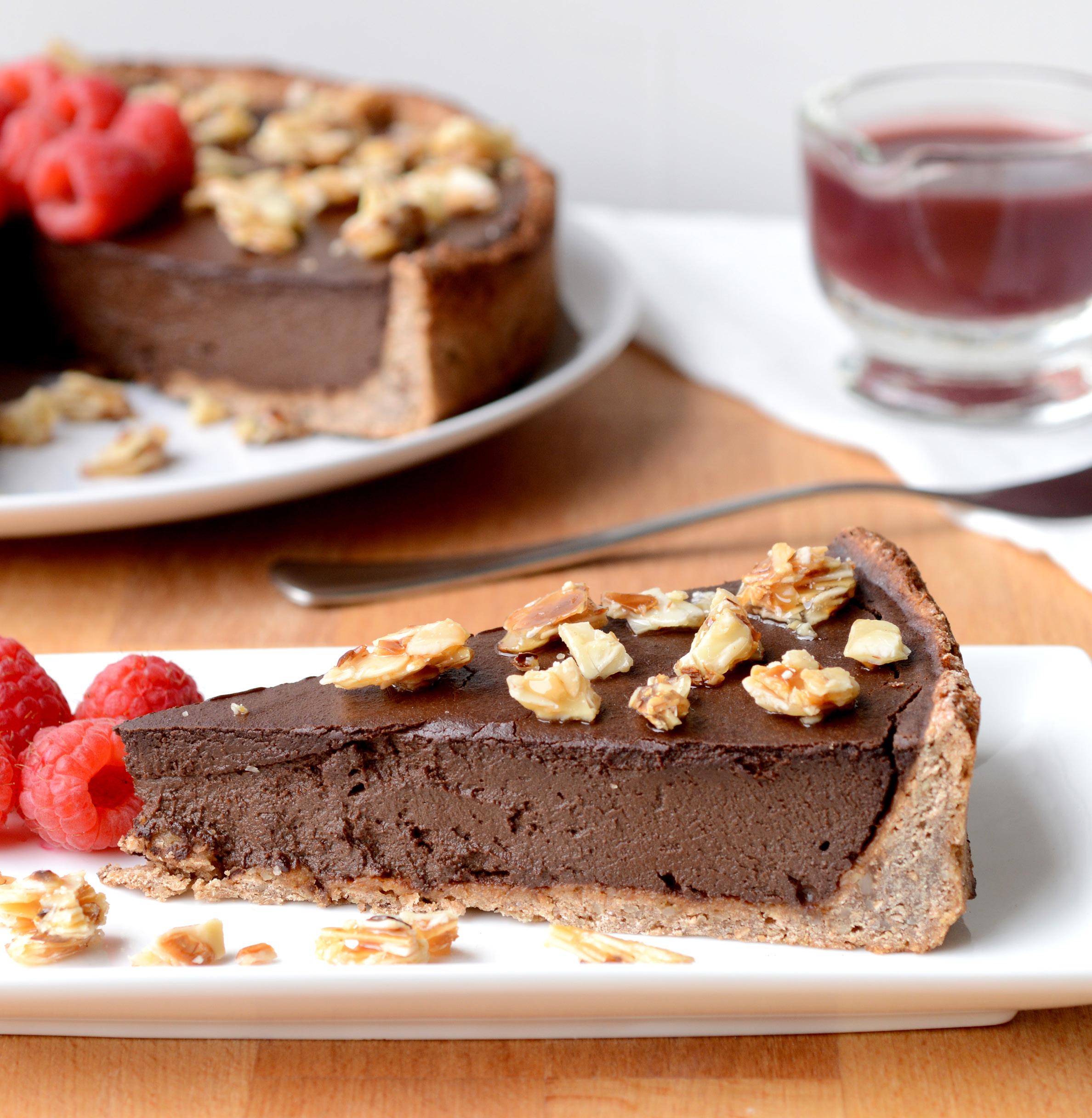
t was an emotional moment for ultrarunner Dave Proctor as he ran over to his hero Terry Fox and kissed the feet of the bronze statue at Victoria, B.C.’s Mile 0. A journey that started on May 15 in St John’s Newfoundland, ending 7,159 kilometres later on July 21 on Vancouver Island was an achievement in itself, but he also completed it in 67 days, 10 hours and 27 minutes, five days faster than Al Howie’s TransCanada run in 1991.

It was Proctor’s third attempt. In 2018 he embarked from Victoria but succumbed to a back injury in Manitoba. As reported in IMPACT’s 2020 Running Issue—where Proctor was a featured Athlete with IMPACT—he then planned to run in May that year until the pandemic curtailed that effort. Not to be defeated, his third attempt brought its challenges, including a tough 20 days running through Ontario, but his resilience and belief in himself got him through.
“I am a man of my word. I proved it to myself and told myself I could do it,” he said. “I could have given myself 10,000 reasons to quit but I didn’t close that door; I didn’t exit.”
Standing in front of family and friends at Mile 0 he reflected on his heroes. In addition to the Terry Fox statue there is a plaque commemorating Howie’s achievement. “I feel honoured to stand here with Terry and Al. Terry taught us what grit and determination is and we can all learn some great lessons from him. Both he and Al proved what human beings are capable of doing.”
Proctor, 41, lost 16 pounds, went through 12 pairs of shoes, and climbed 47,584 metres – the equivalent of five Mt. Everests. He averaged 107 kilometres a day. Taking in the required calories was relatively easy, he said. “I found a perfect way to take in calories. I ate my way from bakery to bakery! I would have lost more weight if it hadn’t been for the cinnamon buns and scones.”
Along the journey he met some incredible people: “We are a very regional country, and I met some kind and passionate individuals. The people were the best part of the journey.” Then there was the support of his parents, kids, and girlfriend: “They all lifted me along the way.”
Proctor has held many ultrarunning records. He is a two-time Canadian Champion and has won some of North America’s best endurance races including the Calgary Marathon, Sinister 7 and the Blackfoot 100. He also holds Canadian long-distance records and is a world record holder for running on a treadmill. But it was Howie’s record that he wanted to break. He said he could do it in 67 days and he kept true to his word.
When asked what his future plans are, he laughingly said he would think about it, but was happy to “sign off on this one and move on to the next thing.”
“I can finally say I did something hard, and I was brave enough to take it on.”
It was four years in the making but ultrarunner Dave Proctor finally completed his record-breaking TransCanada runDave Proctor with his hero Terry Fox at Mile 0 at the end of his 67-day journey.
In the heart of the Canadian Rocky Mountains, sitting at the confluence of two historic rivers and surrounded by six of Canada’s most stunning national parks you will find the mountain adventure town of Golden. Golden is a paradise for those seeking unrefined adventure and a wide variety of outdoor activities, including some of the best hiking opportunities in Western Canada.
Choose from easy trails to challenging overnight hikes, all with spectacular scenery.
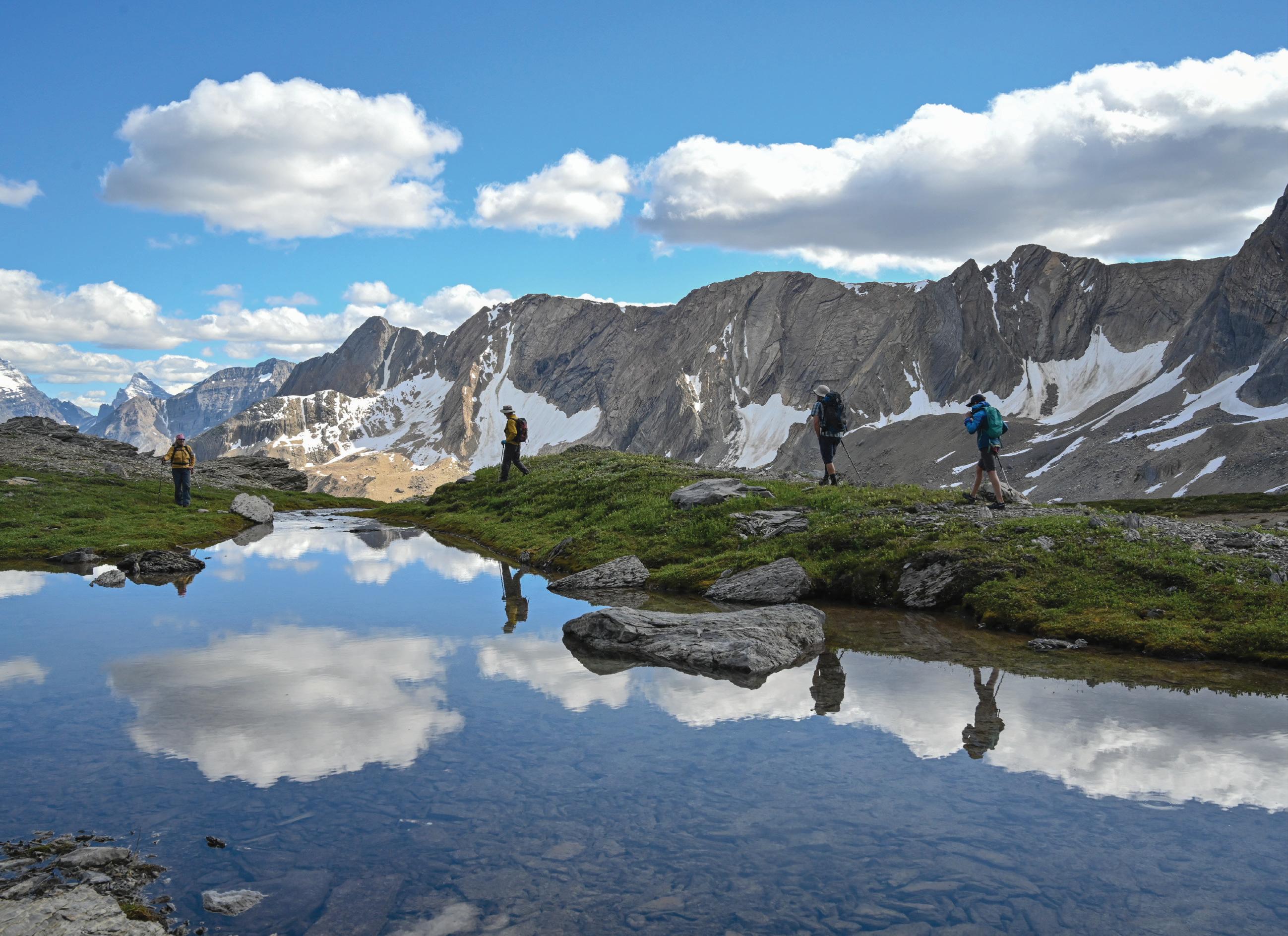
Use the interactive ‘My Golden Experience Finder’ to help you to uncover your own unique Golden adventure.
Help

